Paul van Yperen's Blog, page 99
January 17, 2023
Svatý Václav (1930)
Svatý Václav/St. Wenceslas (Jan S. Kolár, 1930) is a Czechoslovak historical film about Wencesla(u)s, Duke of Bohemia and now seen as a saint and martyr. It was the most expensive Czech film to date, with the largest set constructed in Europe to accommodate an all-star cast of over a hundred, together with 5,000 extras for the lavish battle scenes.
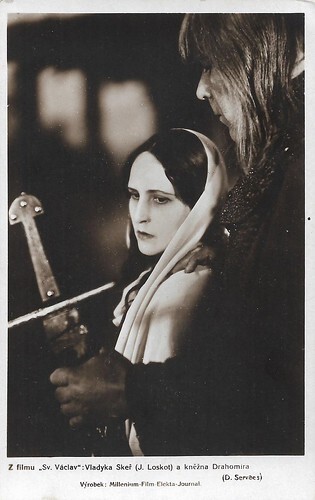
Czechoslovakian postcard by Nákladem K & P, Praha, no. c. 600, 1930. Photo: Millenium-Film-Elekta-Journal. Dagny Servaes as Wenceslaus' mother Dragomira in Svatý Václav/St. Wenceslas (Jan S. Kolár, 1930). Caption: The thane Skeř (Josef Loskot) with Princess Drahomira ( Dagny Servaes ).
An all-star cast
Svatý Václav/St. Wenceslas is a 1930 Czechoslovak historical film about Saint Wenceslas by Jan S. Kolár. It was the most expensive Czech film to date, with the largest set constructed in Europe to accommodate an all-star cast of over a hundred including Dagny Servaes as Wenceslaus's plotting mother Dragomira, and Vera Baranovskaya, the heroin of Vsevolod Pudovkin's classic Mat/Mother (1929), as grandmother Ludmila, killed by her own daughter. There were 5,000 extras for the lavish battle scenes.
The film initially received a loan of 1 million crowns from the government of Czechoslovakia — half of the film's original budget. However, the budget has been increased to 4 million crowns due to filming in winter. When the film was on a verge of being terminated the government lent the production another 1 million crowns. Prime minister František Udržal also provided military equipment as well as people from the state services to finish the film.
The shooting started in September 1929. Exteriors were shot in Prokopské údolí, Šumava primeval forest, Křivoklát, Brdy and Unhošť. Sets of Wenceslaus' and Boleslaus' castles were built at the Strahov Stadium based on designs by Ludvík Hradský, who studied historical sources to be historically accurate. Large reflectors needed to be built for shooting the night scenes. The generators and planes were provided by the Ministry of Defence. Some scenes were filmed using five cameras.
In December the production moved to Vinohrady's A-B Ateliers for interior scenes. The last big battle scene with Radslav was shot in March 1930. The whole film was shot over 82 filming days. Orchestral music was composed by Oskar Nedbal and Jaroslav Křička. It was originally thought that the music would be synchronised with the film, but the lack of funds proved this impossible. A 40-piece orchestra accompanied Svatý Václav/St. Wenceslas at its premiere. Some of the later screenings were with non-original music.
Wenceslaus was played by Czech actor, playwright, director and screenwriter Zdeněk Štěpánek, considered one of the most prominent and well-known Czech stage and screen actors of the 20th century. In cinema, he portrayed several characters from Czech history, such as Jan Hus in the trilogy Jan Hus (1954), Jan Žižka (1956) and Proti všem/Against All (1957) by Otakar Vávra.
In addition to Vávra, Štěpánek played in many films by Martin Frič and Hugo Haas, from the 1930s onward. Memorable were his parts in the comedy Cech panen kutnohorských/The Merry Wives (Otakar Vávra, 1938), Bomba (Jaroslav Balík, 1958), Dnes naposled/Today for the Last Time (Martin Fric, 1958), Transport z ráje/ Transport from Paradise (Zbynek Brynych, 1963), and Ikaria XB 1/Voyage to the End of the Universe (Jindrich Polák, 1963). He appeared in 65 films between 1922 and 1968.
Wenceslaus's brother Boleslav is played by Czech film actor and film director Jan Wenceslaus Speerger, originally Jan Sperger. He appeared in over 270 - mostly Czech - films between 1919 and his death in 1950. He started as a cinema projectionist and later worked as a technician and assistant director for Wetebfilm. He acted mostly in supporting roles and also directed three films.
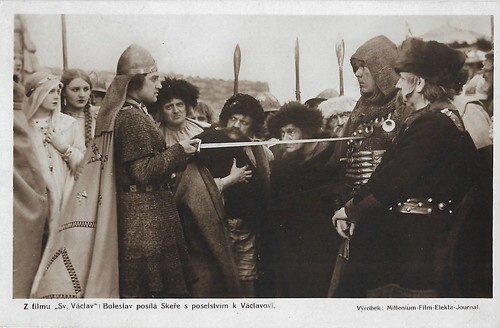
Czechoslovakian postcard by Nákladem K & P, Praha, no. 864, 1930. Photo: Millenium-Film-Elekta-Journal. Jan W. Speerger as Boleslav and Josef Loskot as Sker in Svatý Václav/St. Wencesla(u)s (Jan S. Kolár, 1930). Caption: Boleslav reinforces Sker with a message to Vaclav. It is not entirely clear if this translation is right but Boleslav/ Boleslaus, the younger brother of Wenceslaus, had his brother assassinated in the year 935. After conspiring nobles had stabbed Wenceslaus, Boleslav ran his lance through him. Immediately after his death, Wenceslaus became a martyr and saint.
Martyr and Saint
The beginning of Svatý Václav/St. Wencesla(u)s (Jan S. Kolár, 1930) is set in pagan Bohemia. The Přemyslid duke Bořivoj and his wife Ludmila are baptised by the missionary Methodius. When hunting, their son Vratislav meets a pagan girl, Drahomíra, and, after she is baptised, he marries her. First, their son Wenceslas (Václav) is born, then Boleslav.
Wenceslas is raised by his grandmother, Ludmila, in the spirit of Christianity, culture, and humanity. Since his childhood, he has felt that his view of the meaning of life is very different from what he sees in the pagan surroundings. Radmila, a daughter of a significant thane, Skeř, falls in love with Wenceslas, but he doesn’t return her love, because he has decided to dedicate his life to God.
After Vratislav dies, Ludmila and Drahomíra start fighting for the throne. Wenceslas ascends the throne, but the plotter Skeř incites Boleslav, Drahomíra, and Radslav, Duke of Zlič, to oppose Ludmila and Wenceslas. Instead of a violent fight, Wenceslas challenges Radslav to a duel which ends with Radslav being subjugated. Warlike Boleslav refuses this bloodless solution, behaving in the same way later, in the battle with German troops.
Meanwhile, Ludmila is killed at the suggestion of Skeř and Drahomíra, and, therefore, Drahomíra is banished by Wenceslas. After Radslav is subjugated and Drahomíra is banished, Skeř finds the last chance to gain power – Boleslav. At first, Boleslav refuses the idea of fratricide, but he gradually succumbs to it. Pretending that a chapel will be consecrated, Boleslav invites Wenceslas to his castle.
He gets his company drunk in order to find Wenceslas in prayers alone in the morning. Boleslav starts a fight in the courtyard, but he is knocked down. The members of his company come in a hurry and kill the escaping Wenceslas in front of the church door. The penitent mother, Drahomíra, comes to the place of the murder, Boleslav regrets his deed, and Skeř, hit by Wenceslas’s heavenly greatness, falls from the castle ramparts, into the swamp.
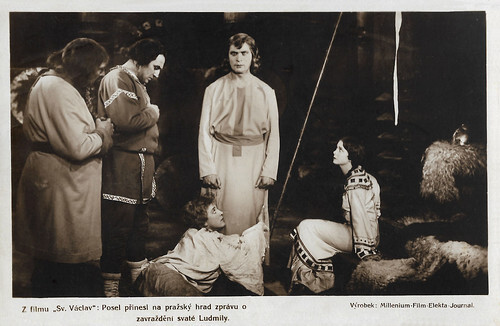
Czechoslovakian postcard by Nákladem K & P, Praha, no. c. 777, 1930. Photo: Millenium-Film-Elekta-Journal. Zdenek Stepánek as St. Wenceslas, Duke of Bohemia in Svatý Václav/St. Wenceslas (Jan S. Kolár, 1930). Caption: A messenger brought news of the murder of Saint Ludmilla to Prague Castle. NB Ludmilla was the grandmother of Wenceslas and his brother Boleslaus. She was killed by her own daughter Dragomira, the mother of the two brothers. The man on the left on this card is Boleslaus/Boleslav, played by Jan W. Speerger.
Fratricide
The historical background, which not necessarily was told in the same way in the film, is that the Bohemian nobility appointed Drahomíra Queen Regent for her son Wenceslaus, when her husband Vratislaus, Duke of Bohemia, died in 921.
Yet, she had to share the government with Vratislaus' mother Ludmilla, who take care of the education of Drahomira's son Wenceslaus, heir to the throne. Claiming that the pious Ludmilla, with help of Bavarian missionaries, was turning her grandson into a monk, rather than the future ruler of Bohemia, Drahomira sent two henchmen to strangle Ludmilla to death. The next year, Bavarian troops raided the Duchy. When Wenceslaus became of age and thus became Duke in 922, he sent his mother into exile but called her back three years after.
Upon the murder of her son by his own younger brother Boleslaus in 935 (or 929) she fled the court. Wenceslaus would soon become seen as a martyr and saint, and the model of the pious, vigorous king (Rex Justus). Despite his bad start with a fratricide, Boleslaus would rule for some 30 years, strengthen and expand the duchy and contribute to its economy.
Svatý Václav/St. Wenceslas was planned to be released in 1929, 1000 years after the death of Wenceslaus. Finally, the film was released on 3 April 1930. It wasn't a commercial success, because at that time sound films already replaced silent films in popularity. Another reason was that people were already tired of all the Wenceslaus celebrations that were occurring since 1929.
The majority of the film viewers at the time were students at projections for schools who paid reduced admission fees. The film was reconstructed by František Balšán under the director Kolár's supervision in 1971. The music score, long considered lost, was discovered in Czech Radio archives. The film was screened in Rudolfinum accompanied by a live orchestra on 28 September 2010. The projection was telecasted live by Czech Television. The film was released on DVD in the same year.
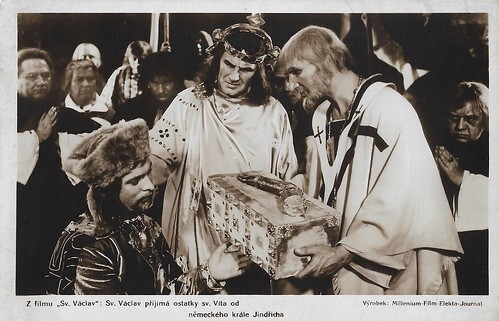
Czechoslovakian postcard by Nákladem K & P, Praha, no. 79, 1930. Photo: Millenium-Film-Elekta-Journal. Zdenek Stepánek as St. Wenceslas, Duke of Bohemia and Václav Vydra as King Heinrich/Henry in Svatý Václav/St. Wenceslas (Jan S. Kolár, 1930). Caption: St. Wenceslas accepts the remains of St. Vitus from the German King Heinrich.
Sources: Czech 2010 brochure on the film (vlada.cz), Wikipedia (English, German and Czech) and IMDb.

Czechoslovakian postcard by Nákladem K & P, Praha, no. c. 600, 1930. Photo: Millenium-Film-Elekta-Journal. Dagny Servaes as Wenceslaus' mother Dragomira in Svatý Václav/St. Wenceslas (Jan S. Kolár, 1930). Caption: The thane Skeř (Josef Loskot) with Princess Drahomira ( Dagny Servaes ).
An all-star cast
Svatý Václav/St. Wenceslas is a 1930 Czechoslovak historical film about Saint Wenceslas by Jan S. Kolár. It was the most expensive Czech film to date, with the largest set constructed in Europe to accommodate an all-star cast of over a hundred including Dagny Servaes as Wenceslaus's plotting mother Dragomira, and Vera Baranovskaya, the heroin of Vsevolod Pudovkin's classic Mat/Mother (1929), as grandmother Ludmila, killed by her own daughter. There were 5,000 extras for the lavish battle scenes.
The film initially received a loan of 1 million crowns from the government of Czechoslovakia — half of the film's original budget. However, the budget has been increased to 4 million crowns due to filming in winter. When the film was on a verge of being terminated the government lent the production another 1 million crowns. Prime minister František Udržal also provided military equipment as well as people from the state services to finish the film.
The shooting started in September 1929. Exteriors were shot in Prokopské údolí, Šumava primeval forest, Křivoklát, Brdy and Unhošť. Sets of Wenceslaus' and Boleslaus' castles were built at the Strahov Stadium based on designs by Ludvík Hradský, who studied historical sources to be historically accurate. Large reflectors needed to be built for shooting the night scenes. The generators and planes were provided by the Ministry of Defence. Some scenes were filmed using five cameras.
In December the production moved to Vinohrady's A-B Ateliers for interior scenes. The last big battle scene with Radslav was shot in March 1930. The whole film was shot over 82 filming days. Orchestral music was composed by Oskar Nedbal and Jaroslav Křička. It was originally thought that the music would be synchronised with the film, but the lack of funds proved this impossible. A 40-piece orchestra accompanied Svatý Václav/St. Wenceslas at its premiere. Some of the later screenings were with non-original music.
Wenceslaus was played by Czech actor, playwright, director and screenwriter Zdeněk Štěpánek, considered one of the most prominent and well-known Czech stage and screen actors of the 20th century. In cinema, he portrayed several characters from Czech history, such as Jan Hus in the trilogy Jan Hus (1954), Jan Žižka (1956) and Proti všem/Against All (1957) by Otakar Vávra.
In addition to Vávra, Štěpánek played in many films by Martin Frič and Hugo Haas, from the 1930s onward. Memorable were his parts in the comedy Cech panen kutnohorských/The Merry Wives (Otakar Vávra, 1938), Bomba (Jaroslav Balík, 1958), Dnes naposled/Today for the Last Time (Martin Fric, 1958), Transport z ráje/ Transport from Paradise (Zbynek Brynych, 1963), and Ikaria XB 1/Voyage to the End of the Universe (Jindrich Polák, 1963). He appeared in 65 films between 1922 and 1968.
Wenceslaus's brother Boleslav is played by Czech film actor and film director Jan Wenceslaus Speerger, originally Jan Sperger. He appeared in over 270 - mostly Czech - films between 1919 and his death in 1950. He started as a cinema projectionist and later worked as a technician and assistant director for Wetebfilm. He acted mostly in supporting roles and also directed three films.

Czechoslovakian postcard by Nákladem K & P, Praha, no. 864, 1930. Photo: Millenium-Film-Elekta-Journal. Jan W. Speerger as Boleslav and Josef Loskot as Sker in Svatý Václav/St. Wencesla(u)s (Jan S. Kolár, 1930). Caption: Boleslav reinforces Sker with a message to Vaclav. It is not entirely clear if this translation is right but Boleslav/ Boleslaus, the younger brother of Wenceslaus, had his brother assassinated in the year 935. After conspiring nobles had stabbed Wenceslaus, Boleslav ran his lance through him. Immediately after his death, Wenceslaus became a martyr and saint.
Martyr and Saint
The beginning of Svatý Václav/St. Wencesla(u)s (Jan S. Kolár, 1930) is set in pagan Bohemia. The Přemyslid duke Bořivoj and his wife Ludmila are baptised by the missionary Methodius. When hunting, their son Vratislav meets a pagan girl, Drahomíra, and, after she is baptised, he marries her. First, their son Wenceslas (Václav) is born, then Boleslav.
Wenceslas is raised by his grandmother, Ludmila, in the spirit of Christianity, culture, and humanity. Since his childhood, he has felt that his view of the meaning of life is very different from what he sees in the pagan surroundings. Radmila, a daughter of a significant thane, Skeř, falls in love with Wenceslas, but he doesn’t return her love, because he has decided to dedicate his life to God.
After Vratislav dies, Ludmila and Drahomíra start fighting for the throne. Wenceslas ascends the throne, but the plotter Skeř incites Boleslav, Drahomíra, and Radslav, Duke of Zlič, to oppose Ludmila and Wenceslas. Instead of a violent fight, Wenceslas challenges Radslav to a duel which ends with Radslav being subjugated. Warlike Boleslav refuses this bloodless solution, behaving in the same way later, in the battle with German troops.
Meanwhile, Ludmila is killed at the suggestion of Skeř and Drahomíra, and, therefore, Drahomíra is banished by Wenceslas. After Radslav is subjugated and Drahomíra is banished, Skeř finds the last chance to gain power – Boleslav. At first, Boleslav refuses the idea of fratricide, but he gradually succumbs to it. Pretending that a chapel will be consecrated, Boleslav invites Wenceslas to his castle.
He gets his company drunk in order to find Wenceslas in prayers alone in the morning. Boleslav starts a fight in the courtyard, but he is knocked down. The members of his company come in a hurry and kill the escaping Wenceslas in front of the church door. The penitent mother, Drahomíra, comes to the place of the murder, Boleslav regrets his deed, and Skeř, hit by Wenceslas’s heavenly greatness, falls from the castle ramparts, into the swamp.

Czechoslovakian postcard by Nákladem K & P, Praha, no. c. 777, 1930. Photo: Millenium-Film-Elekta-Journal. Zdenek Stepánek as St. Wenceslas, Duke of Bohemia in Svatý Václav/St. Wenceslas (Jan S. Kolár, 1930). Caption: A messenger brought news of the murder of Saint Ludmilla to Prague Castle. NB Ludmilla was the grandmother of Wenceslas and his brother Boleslaus. She was killed by her own daughter Dragomira, the mother of the two brothers. The man on the left on this card is Boleslaus/Boleslav, played by Jan W. Speerger.
Fratricide
The historical background, which not necessarily was told in the same way in the film, is that the Bohemian nobility appointed Drahomíra Queen Regent for her son Wenceslaus, when her husband Vratislaus, Duke of Bohemia, died in 921.
Yet, she had to share the government with Vratislaus' mother Ludmilla, who take care of the education of Drahomira's son Wenceslaus, heir to the throne. Claiming that the pious Ludmilla, with help of Bavarian missionaries, was turning her grandson into a monk, rather than the future ruler of Bohemia, Drahomira sent two henchmen to strangle Ludmilla to death. The next year, Bavarian troops raided the Duchy. When Wenceslaus became of age and thus became Duke in 922, he sent his mother into exile but called her back three years after.
Upon the murder of her son by his own younger brother Boleslaus in 935 (or 929) she fled the court. Wenceslaus would soon become seen as a martyr and saint, and the model of the pious, vigorous king (Rex Justus). Despite his bad start with a fratricide, Boleslaus would rule for some 30 years, strengthen and expand the duchy and contribute to its economy.
Svatý Václav/St. Wenceslas was planned to be released in 1929, 1000 years after the death of Wenceslaus. Finally, the film was released on 3 April 1930. It wasn't a commercial success, because at that time sound films already replaced silent films in popularity. Another reason was that people were already tired of all the Wenceslaus celebrations that were occurring since 1929.
The majority of the film viewers at the time were students at projections for schools who paid reduced admission fees. The film was reconstructed by František Balšán under the director Kolár's supervision in 1971. The music score, long considered lost, was discovered in Czech Radio archives. The film was screened in Rudolfinum accompanied by a live orchestra on 28 September 2010. The projection was telecasted live by Czech Television. The film was released on DVD in the same year.

Czechoslovakian postcard by Nákladem K & P, Praha, no. 79, 1930. Photo: Millenium-Film-Elekta-Journal. Zdenek Stepánek as St. Wenceslas, Duke of Bohemia and Václav Vydra as King Heinrich/Henry in Svatý Václav/St. Wenceslas (Jan S. Kolár, 1930). Caption: St. Wenceslas accepts the remains of St. Vitus from the German King Heinrich.
Sources: Czech 2010 brochure on the film (vlada.cz), Wikipedia (English, German and Czech) and IMDb.
Published on January 17, 2023 22:00
January 16, 2023
Gina Lollobrigida (1927-2023)
Yesterday, 16 January 2023, Italian actress and photojournalist Gina Lollobrigida (1927-2023) passed away in Rome at the age of 95. She was one of Europe’s most prominent film stars of the 1950s. ‘La Lollo’ was the first European sex symbol of the post-war years and she paved the way in Hollywood for her younger colleagues Sophia Loren, Claudia Cardinale and Monica Bellucci.
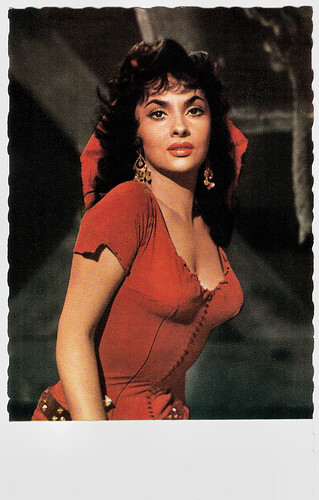
German postcard by Kolibri-Verlag G.m.b.H., Minden (Westf.), no. F 18. Photo: Constantin. Publicity still for Notre Dame de Paris (Jean Delannoy, 1956).
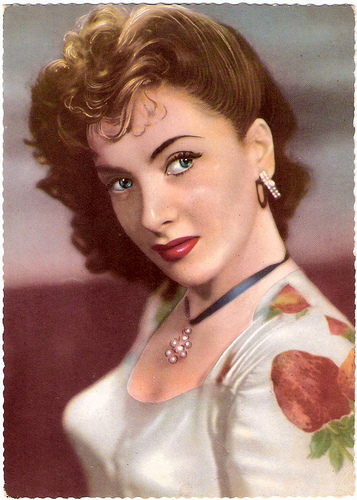
I.F.P.A. postcard, no. 15.
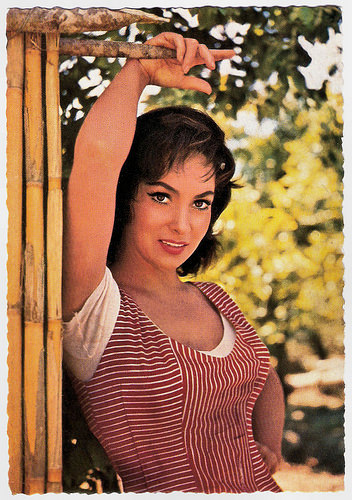
German postcard by Terra-Color, no. F 130. Photo: Morris, Rome.
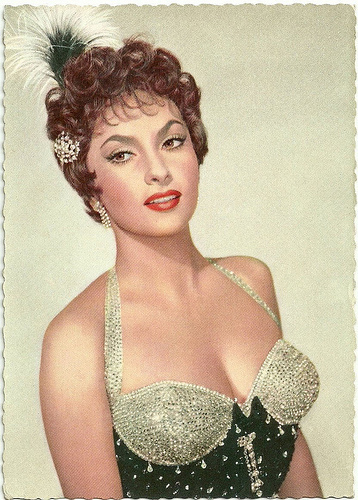
German postcard by Ufa, no. CK 67. Photo: Raymond Vainquel. Publicity still for Trapeze (Carol Reed, 1956).
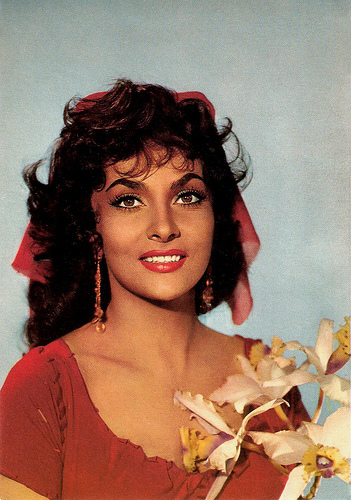
French postcard by E.D.U.G., no. 10. Photo: publicity still for Notre-Dame de Paris/The Hunchback of Notre Dame (Jean Delannoy, 1956).
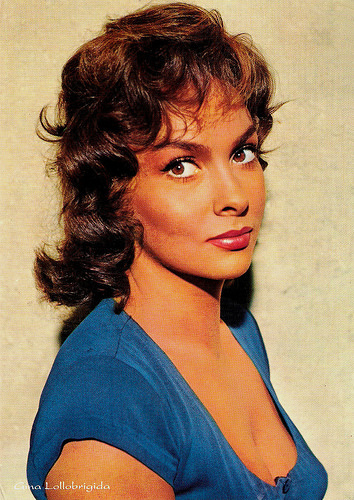
Italian postcard by Rotalfoto in the Artisti di Sempre series, no. 294.
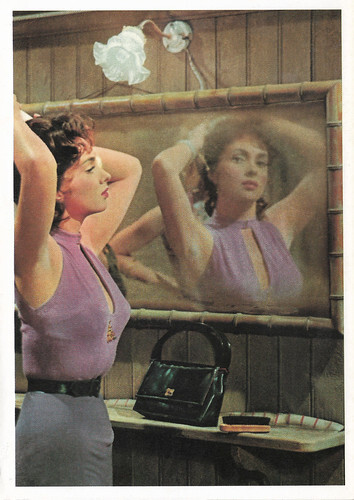
French postcard in the collection Cinéma Couleur by Editions La Malibran, Nancy, no. MC 37, 1990. Photo: Gina Lollobrigida in Le grand jeu/Card of Fate (Robert Siodmak, 1954).
The most beautiful toddler in Italy
Luigina Lollobrigida was born in the picturesque Italian mountain village of Subiaco in 1927, as one of four daughters of a furniture manufacturer. At the age of 3, Luigina was already selected as the most beautiful toddler in Italy and in her youth, she started to model.
She became an art student and made her film debut in an uncredited bit role in the adventure film Aquila nera/The Black Eagle Returns (Riccardo Freda, 1946) starring Rossano Brazzi . In 1947, she entered the Miss Italia pageant and came in third. The contest was won by Lucia Bosé and the second was Gianna Maria Canale . Both also became film actresses, though not nearly as successful as Lollobrigida.
Gina Lollobrigida was discovered by director Mario Costa who gave her a small part as a girlfriend of Adina ( Nelly Corradi ) in the opera adaptation L’elisir d’amore/Elixir of Love (Mario Costa, 1946). Lollobrigida started to model as Diana Loris for the Fotoromanzi, the popular Italian photo novel.
She got her first bigger film part in another opera film, Pagliacci/Love of a Clown - Pagliacci (Mario Costa, 1948), co-starring with one of the greatest Italian baritones, Tito Gobbi. The film, based on Ruggero Leoncavallo's opera Pagliacci recounts the tragedy of Canio (Afro Poli), the lead clown (or pagliaccio in Italian) in a Commedia dell'arte troupe, his wife Nedda (Lollobrigida), and her lover, Silvio (Gobbi).
When Nedda spurns the advances of Tonio (also Gobbi), another player in the troupe, he tells Canio about Nedda's betrayal. In a jealous rage, Canio murders both Nedda and Silvio. Lollobrigida's singing in this film was dubbed.
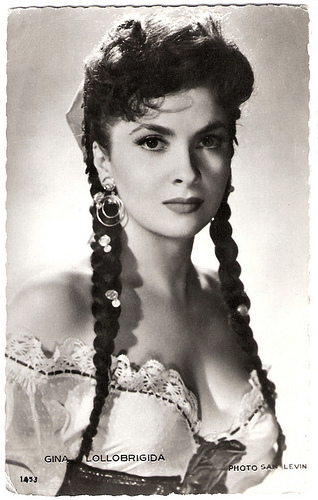
French postcard by Editions P.I., Paris, no. 29 F. Offered by Les Carbones Korès Carboplane. Photo: Sam Lévin. Publicity still for Fanfan la Tulipe/Fan-Fan the Tulip (Christian Jacque, 1952).
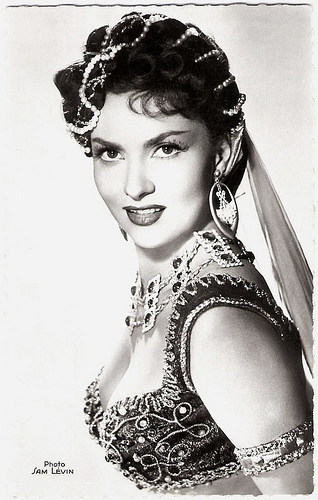
French postcard by Editions du Globe, Paris, no. 325. Photo: Sam Lévin. Publicity still for Les belles de nuit/Beauties of the Night (René Clair, 1952).
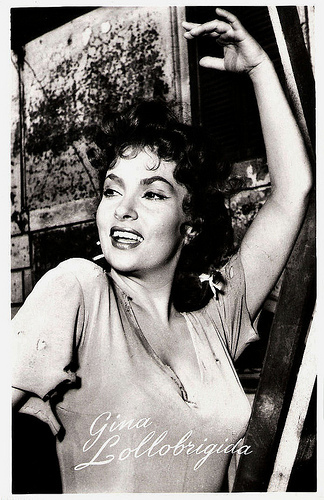
Dutch postcard by Uitg. Takken, Utrecht, no. 1748. Photo: publicity still for Pane, amore e fantasia/Bread, Love and Dreams (Luigi Comencini, 1953).
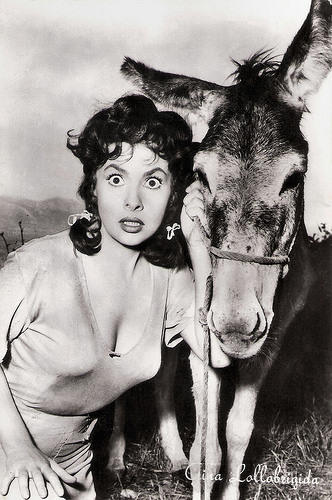
Yugoslavian postcard by NPO, no. G5. Photo: publicity still for Pane, amore e fantasia/Bread, Love and Dreams (Luigi Comencini, 1953).
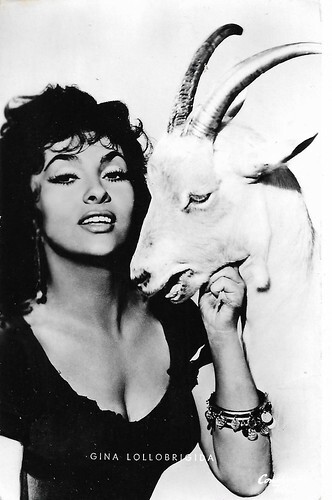
German postcard by Netter's Starverlag, Berlin. The photo may refer to the film Pane, amore e fantasia/Bread, Love and Dreams (Luigi Comencini, 1953).
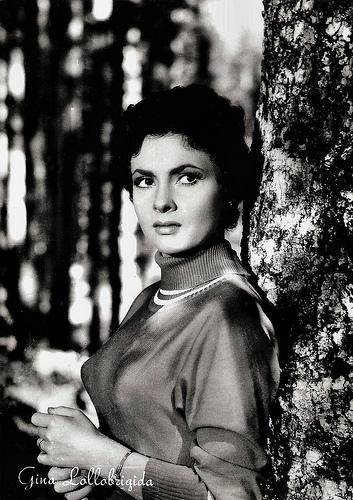
Italian postcard by Rotalfoto, Milano, no. 187. Photo: Ponti / De Laurentiis. Publicity still for La provinciale/The Wayward Wife (Mario Soldati, 1953).
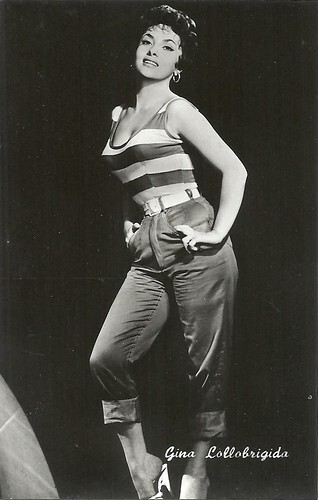
French postcard.
Miss Italia
Gina Lollobtrigida's first major success as a leading lady was in Miss Italia/My Beautiful Daughter (Duilio Coletti, 1950), a backstage drama set at a beauty contest. It was followed by the delightful comedy Vita da cani/A Dog's Life (Mario Monicelli, Steno, 1950) with Aldo Fabrizi , and the award-winning crime drama La città si difende/Four Ways Out (Pietro Germi, 1951), based on a script by Federico Fellini .
In France, she co-starred with Gérard Philipe in the hugely entertaining melange of swash-buckling adventure, comedy and romance Fanfan la Tulipe/Fan-Fan the Tulip (Christian Jacque, 1952) and in Les Belles de Nuit/Beauties of the Night (René Clair, 1952). James Travers at Films de France : "As French matinee idol Gérard Philipe is propelled through history and cardboard Freudian dreamscapes, into the arms of such beauties as Martine Carol and Gina Lollobrigida, (director René) Clair appears to have all but lost his tenuous grip on reality (the scene with the dinosaur confirms it) - but who cares? This is a film which, like Clair’s earlier comic masterpieces, is intended to distract and entertain, and it does that marvellously and unashamedly."
Gina Lollobrigida had her definitive breakthrough with the huge global hit Pane, amore e fantasia/Bread, Love and Dreams (Luigi Comencini, 1953), in which she starred with Vittorio De Sica . This romantic comedy was nominated in the U.S. for an Oscar, and Lollobrigida herself received in Great Britain a nomination at BAFTA. The success led to three sequels, including Pane, amore e gelosia/Bread, Love and Jealousy (Luigi Comencini, 1954).
Her first American film was Beat the Devil (John Huston, 1953). She was at her best as Humphrey Bogart 's wife in this odd but endearing Film Noir comedy. Next, she earned her nickname ‘The World's Most Beautiful Woman’ for her signature film La donna più bella del mondo (Robert Z. Leonard, 1956), in which she played the legendary actress Lina Cavalieri .
For her role in this film, she received the first David di Donatello for Best Actress. Her earthy looks and short 'tossed salad' hairdo were quite influential, and in fact, there's a type of curly lettuce named 'Lollo' in honour of her cute hairdo. (In France 'Lollo's' were a nickname for breasts).
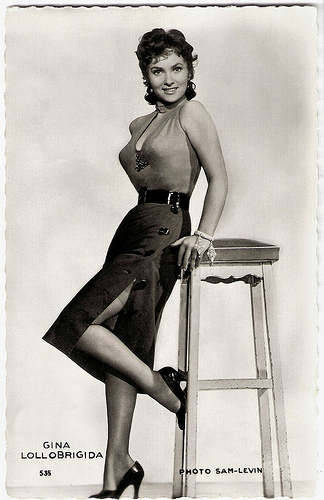
French postcard by Editions P.I., Paris, no. 29 F. Offered by Les Carbones Korès Carboplane. Photo: Sam Lévin.
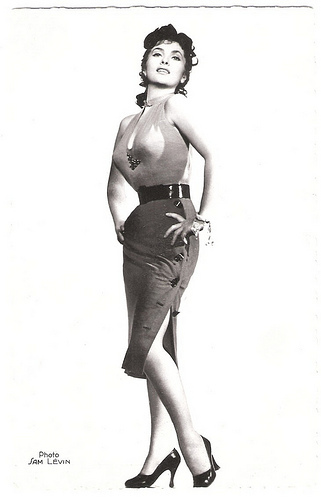
French postcard by Editions du Globe (E.D.U.G.), Paris, no. 360. Photo: Sam Lévin.
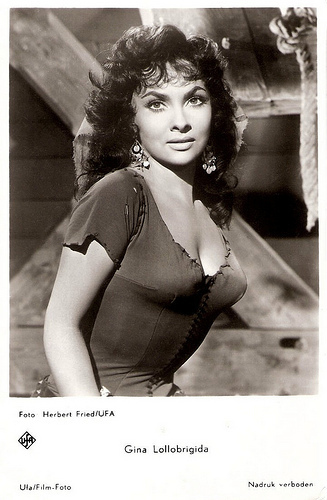
Dutch postcard by Gebr. Spanjersberg, no. 354. Photo: Herbert Fried / Ufa. Publicity still for Notre Dame de Paris (1956).
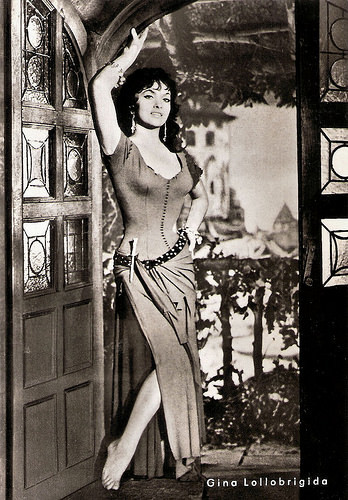
East-German postcard by VEB Progress Film-Vertrieb, Berlin, no. 2/72. Photo: publicity still for Notre-Dame de Paris/The Hunchback of Notre Dame (Jean Delannoy, 1956).
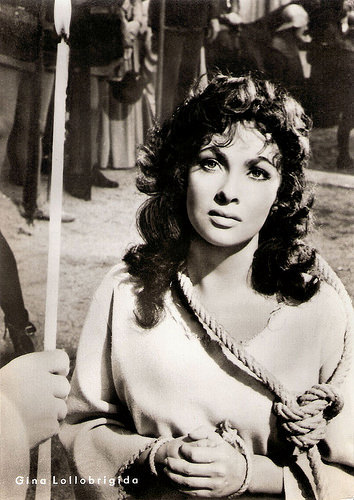
East-German postcard by VEB Progress Film-Vertrieb, Berlin, no. 56/72. Photo: publicity still for Notre-Dame de Paris/The Hunchback of Notre Dame (Jean Delannoy, 1956).
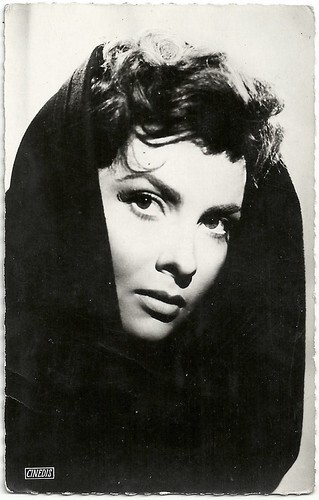
French postcard by Editions du Globe, Paris, no. 230. Photo: Cinedis.
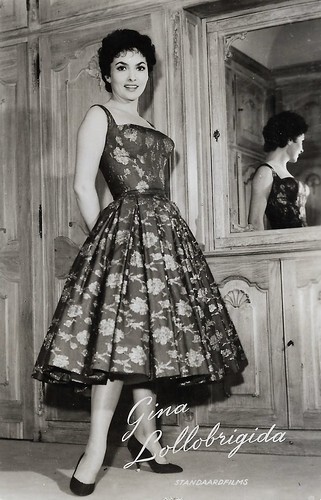
Dutch postcard by Uitg. Takken, Utrecht, no. AX 3210. Photo: N.V. Standaardfilms.
Esmeralda
Gina Lollobrigida made another Hollywood appearance in the circus melodrama Trapeze (Carol Reed, 1956) between Burt Lancaster and Tony Curtis . Next, she starred as Esmeralda in Notre Dame de Paris/The Hunchback of Notre Dame (Jean Delannoy, 1956) opposite Anthony Quinn as Quasimodo. In 1959 she lured Yul Brynner in the Biblical epic Solomon and Sheba (King Vidor, 1959).
One of her most popular Hollywood films was Come September (Robert Mulligan, 1961), in which she played the never-contented mistress of Rock Hudson . For this lightweight comedy, she won the Golden Globe as 'World Film Favorite'. She co-starred again with Hudson in Strange Bedfellows (Melvin Frank, 1965) and in 1968 she starred in the enjoyable screwball comedy Buona Sera, Mrs. Campbell (Melvin Frank, 1968), for which she was again nominated for a Golden Globe and won a David di Donatello award, the Italian Oscar.
On TV, Gina Lollobrigida was seen in the mini-series Le Avventure di Pinocchio/The Adventures of Pinocchio (Luigi Comencini, 1972). She retired from acting in the mid-1970s but has occasionally returned for the camera, including in a regular role in the American soap opera Falcon Crest (1984). She has used her celebrity to sell cosmetics, published two books of her photography, Italia (My Italy, 1973) and Wonder of Innocence (1994), and created sculptures.
In the mid-1970s she wrote, directed and produced Ritratto di Fidel/Portrait of Fidel, a very personal 50-minute documentary about Fidel Castro that included a rare interview with the Cuban dictator, fuelling persistent rumours that a romance was sparked. In 1986, she was the head of the jury at the Berlin International Film Festival, and in 1999 she ran for a seat in the European Union Parliament, stressing humanitarian issues, but she lost the election. Gina Lollobrigida made her last film appearance in XXXL (Ariel Zeitoun, 1997) with Gérard Depardieu .
Gina Lollobrigida was married once, to Slovenian physician Milko Skofic, in 1949. Skofic gave up his practice to become her manager. They had one child, Milko Skofic, Jr., born in 1957, and the couple divorced in 1971. In 1993 her grandson Dimitri was born. Lollobrigida lived since 1949 at her home ranch and gardens in Sicily. The property contains her personal museum. In addition, she regularly stayed at her house on Via Appia Antica in Rome and at a villa in Monte Carlo. In 2013, Lollobrigida sold her jewellery collection through Sotheby's. She donated nearly $5 million to benefit stem cell therapy.
Next to her Golden Globe, Lollobrigida won 6 David di Donatello, 2 Nastro d'Argento, and 6 Bambi Awards. In 1985 she was nominated as an Officier of the Ordre des Arts et des Lettres by the French Minister of Culture, Jack Lang for her achievements in sculpture and in photography. In 1992 she was awarded the Légion d'Honneur by president François Mitterrand.
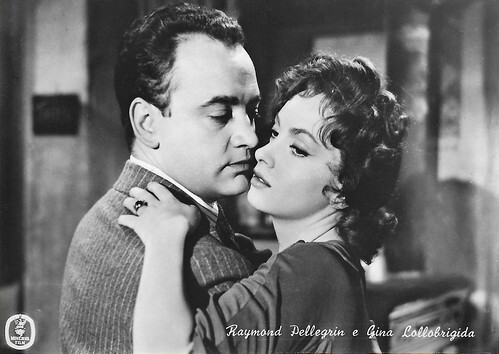
Italian postcard by Bromofoto, Milano, no. 839. Photo: Minerva Film. Gina Lollobrigida and Raymond Pellegrin in La romana/ Woman of Rome (Luigi Zampa, 1954).
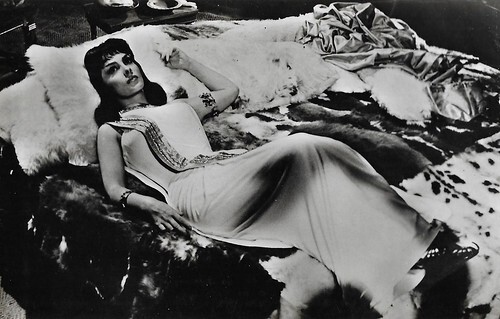
Spanish postcard by Ed. Raker, Barcelona. Gina Lollobrigida in Solomon and Sheba (King Vidor, 1959).
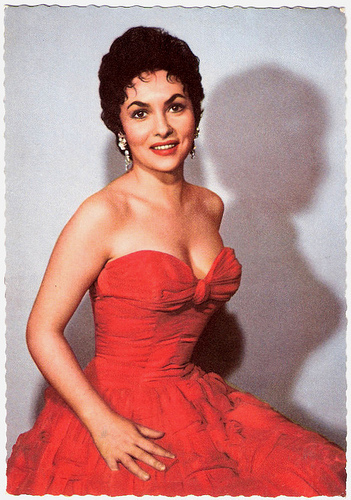
German postcard by Universum-Film Aktiengesellschaft, Berlin-Tempelhof (Ufa), no. CK-157. Retail price: 30 Pfg. Photo: Camerapress.
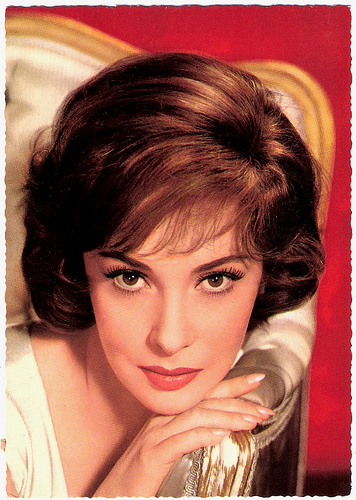
German postcard by Krüger, no. 902/135. Photo: Universal / Ufa.
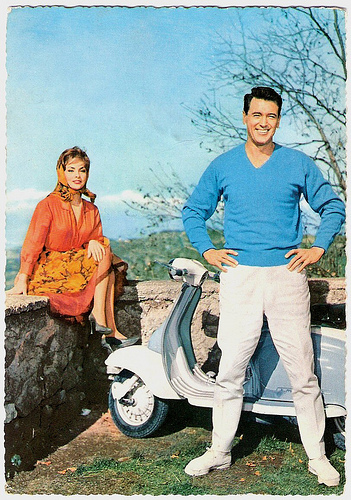
German postcard by Krüger, no. 902/129. Photo: Terb Agency / Ufa. Publicity still for Come September (Robert Mulligan, 1961) with Rock Hudson.
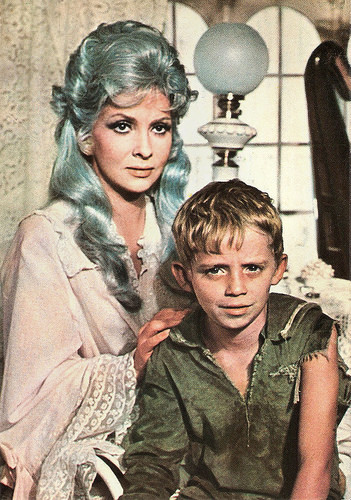
Italian postcard by Edizioni Panini, Modena (EPM). Photo: Sampaolofilm / Cinepat. Publicity still for Le avventure di Pinocchio/The Adventures of Pinocchio (Luigi Comencini, 1972) with Andrea Balestri. Caption: The Fairy and the boy Pinocchio.
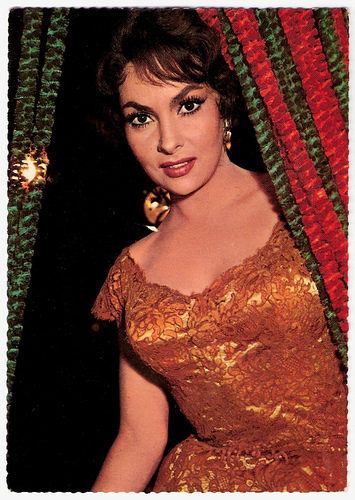
German postcard by Krüger, no. 902/56. Photo: Farabola.
Sources: James Travers (Film de France), NNDB, Andrea LeVasseur (AllMovie), (IMDb), Wikipedia, and .

German postcard by Kolibri-Verlag G.m.b.H., Minden (Westf.), no. F 18. Photo: Constantin. Publicity still for Notre Dame de Paris (Jean Delannoy, 1956).

I.F.P.A. postcard, no. 15.

German postcard by Terra-Color, no. F 130. Photo: Morris, Rome.

German postcard by Ufa, no. CK 67. Photo: Raymond Vainquel. Publicity still for Trapeze (Carol Reed, 1956).

French postcard by E.D.U.G., no. 10. Photo: publicity still for Notre-Dame de Paris/The Hunchback of Notre Dame (Jean Delannoy, 1956).

Italian postcard by Rotalfoto in the Artisti di Sempre series, no. 294.

French postcard in the collection Cinéma Couleur by Editions La Malibran, Nancy, no. MC 37, 1990. Photo: Gina Lollobrigida in Le grand jeu/Card of Fate (Robert Siodmak, 1954).
The most beautiful toddler in Italy
Luigina Lollobrigida was born in the picturesque Italian mountain village of Subiaco in 1927, as one of four daughters of a furniture manufacturer. At the age of 3, Luigina was already selected as the most beautiful toddler in Italy and in her youth, she started to model.
She became an art student and made her film debut in an uncredited bit role in the adventure film Aquila nera/The Black Eagle Returns (Riccardo Freda, 1946) starring Rossano Brazzi . In 1947, she entered the Miss Italia pageant and came in third. The contest was won by Lucia Bosé and the second was Gianna Maria Canale . Both also became film actresses, though not nearly as successful as Lollobrigida.
Gina Lollobrigida was discovered by director Mario Costa who gave her a small part as a girlfriend of Adina ( Nelly Corradi ) in the opera adaptation L’elisir d’amore/Elixir of Love (Mario Costa, 1946). Lollobrigida started to model as Diana Loris for the Fotoromanzi, the popular Italian photo novel.
She got her first bigger film part in another opera film, Pagliacci/Love of a Clown - Pagliacci (Mario Costa, 1948), co-starring with one of the greatest Italian baritones, Tito Gobbi. The film, based on Ruggero Leoncavallo's opera Pagliacci recounts the tragedy of Canio (Afro Poli), the lead clown (or pagliaccio in Italian) in a Commedia dell'arte troupe, his wife Nedda (Lollobrigida), and her lover, Silvio (Gobbi).
When Nedda spurns the advances of Tonio (also Gobbi), another player in the troupe, he tells Canio about Nedda's betrayal. In a jealous rage, Canio murders both Nedda and Silvio. Lollobrigida's singing in this film was dubbed.

French postcard by Editions P.I., Paris, no. 29 F. Offered by Les Carbones Korès Carboplane. Photo: Sam Lévin. Publicity still for Fanfan la Tulipe/Fan-Fan the Tulip (Christian Jacque, 1952).

French postcard by Editions du Globe, Paris, no. 325. Photo: Sam Lévin. Publicity still for Les belles de nuit/Beauties of the Night (René Clair, 1952).

Dutch postcard by Uitg. Takken, Utrecht, no. 1748. Photo: publicity still for Pane, amore e fantasia/Bread, Love and Dreams (Luigi Comencini, 1953).

Yugoslavian postcard by NPO, no. G5. Photo: publicity still for Pane, amore e fantasia/Bread, Love and Dreams (Luigi Comencini, 1953).

German postcard by Netter's Starverlag, Berlin. The photo may refer to the film Pane, amore e fantasia/Bread, Love and Dreams (Luigi Comencini, 1953).

Italian postcard by Rotalfoto, Milano, no. 187. Photo: Ponti / De Laurentiis. Publicity still for La provinciale/The Wayward Wife (Mario Soldati, 1953).

French postcard.
Miss Italia
Gina Lollobtrigida's first major success as a leading lady was in Miss Italia/My Beautiful Daughter (Duilio Coletti, 1950), a backstage drama set at a beauty contest. It was followed by the delightful comedy Vita da cani/A Dog's Life (Mario Monicelli, Steno, 1950) with Aldo Fabrizi , and the award-winning crime drama La città si difende/Four Ways Out (Pietro Germi, 1951), based on a script by Federico Fellini .
In France, she co-starred with Gérard Philipe in the hugely entertaining melange of swash-buckling adventure, comedy and romance Fanfan la Tulipe/Fan-Fan the Tulip (Christian Jacque, 1952) and in Les Belles de Nuit/Beauties of the Night (René Clair, 1952). James Travers at Films de France : "As French matinee idol Gérard Philipe is propelled through history and cardboard Freudian dreamscapes, into the arms of such beauties as Martine Carol and Gina Lollobrigida, (director René) Clair appears to have all but lost his tenuous grip on reality (the scene with the dinosaur confirms it) - but who cares? This is a film which, like Clair’s earlier comic masterpieces, is intended to distract and entertain, and it does that marvellously and unashamedly."
Gina Lollobrigida had her definitive breakthrough with the huge global hit Pane, amore e fantasia/Bread, Love and Dreams (Luigi Comencini, 1953), in which she starred with Vittorio De Sica . This romantic comedy was nominated in the U.S. for an Oscar, and Lollobrigida herself received in Great Britain a nomination at BAFTA. The success led to three sequels, including Pane, amore e gelosia/Bread, Love and Jealousy (Luigi Comencini, 1954).
Her first American film was Beat the Devil (John Huston, 1953). She was at her best as Humphrey Bogart 's wife in this odd but endearing Film Noir comedy. Next, she earned her nickname ‘The World's Most Beautiful Woman’ for her signature film La donna più bella del mondo (Robert Z. Leonard, 1956), in which she played the legendary actress Lina Cavalieri .
For her role in this film, she received the first David di Donatello for Best Actress. Her earthy looks and short 'tossed salad' hairdo were quite influential, and in fact, there's a type of curly lettuce named 'Lollo' in honour of her cute hairdo. (In France 'Lollo's' were a nickname for breasts).

French postcard by Editions P.I., Paris, no. 29 F. Offered by Les Carbones Korès Carboplane. Photo: Sam Lévin.

French postcard by Editions du Globe (E.D.U.G.), Paris, no. 360. Photo: Sam Lévin.

Dutch postcard by Gebr. Spanjersberg, no. 354. Photo: Herbert Fried / Ufa. Publicity still for Notre Dame de Paris (1956).

East-German postcard by VEB Progress Film-Vertrieb, Berlin, no. 2/72. Photo: publicity still for Notre-Dame de Paris/The Hunchback of Notre Dame (Jean Delannoy, 1956).

East-German postcard by VEB Progress Film-Vertrieb, Berlin, no. 56/72. Photo: publicity still for Notre-Dame de Paris/The Hunchback of Notre Dame (Jean Delannoy, 1956).

French postcard by Editions du Globe, Paris, no. 230. Photo: Cinedis.

Dutch postcard by Uitg. Takken, Utrecht, no. AX 3210. Photo: N.V. Standaardfilms.
Esmeralda
Gina Lollobrigida made another Hollywood appearance in the circus melodrama Trapeze (Carol Reed, 1956) between Burt Lancaster and Tony Curtis . Next, she starred as Esmeralda in Notre Dame de Paris/The Hunchback of Notre Dame (Jean Delannoy, 1956) opposite Anthony Quinn as Quasimodo. In 1959 she lured Yul Brynner in the Biblical epic Solomon and Sheba (King Vidor, 1959).
One of her most popular Hollywood films was Come September (Robert Mulligan, 1961), in which she played the never-contented mistress of Rock Hudson . For this lightweight comedy, she won the Golden Globe as 'World Film Favorite'. She co-starred again with Hudson in Strange Bedfellows (Melvin Frank, 1965) and in 1968 she starred in the enjoyable screwball comedy Buona Sera, Mrs. Campbell (Melvin Frank, 1968), for which she was again nominated for a Golden Globe and won a David di Donatello award, the Italian Oscar.
On TV, Gina Lollobrigida was seen in the mini-series Le Avventure di Pinocchio/The Adventures of Pinocchio (Luigi Comencini, 1972). She retired from acting in the mid-1970s but has occasionally returned for the camera, including in a regular role in the American soap opera Falcon Crest (1984). She has used her celebrity to sell cosmetics, published two books of her photography, Italia (My Italy, 1973) and Wonder of Innocence (1994), and created sculptures.
In the mid-1970s she wrote, directed and produced Ritratto di Fidel/Portrait of Fidel, a very personal 50-minute documentary about Fidel Castro that included a rare interview with the Cuban dictator, fuelling persistent rumours that a romance was sparked. In 1986, she was the head of the jury at the Berlin International Film Festival, and in 1999 she ran for a seat in the European Union Parliament, stressing humanitarian issues, but she lost the election. Gina Lollobrigida made her last film appearance in XXXL (Ariel Zeitoun, 1997) with Gérard Depardieu .
Gina Lollobrigida was married once, to Slovenian physician Milko Skofic, in 1949. Skofic gave up his practice to become her manager. They had one child, Milko Skofic, Jr., born in 1957, and the couple divorced in 1971. In 1993 her grandson Dimitri was born. Lollobrigida lived since 1949 at her home ranch and gardens in Sicily. The property contains her personal museum. In addition, she regularly stayed at her house on Via Appia Antica in Rome and at a villa in Monte Carlo. In 2013, Lollobrigida sold her jewellery collection through Sotheby's. She donated nearly $5 million to benefit stem cell therapy.
Next to her Golden Globe, Lollobrigida won 6 David di Donatello, 2 Nastro d'Argento, and 6 Bambi Awards. In 1985 she was nominated as an Officier of the Ordre des Arts et des Lettres by the French Minister of Culture, Jack Lang for her achievements in sculpture and in photography. In 1992 she was awarded the Légion d'Honneur by president François Mitterrand.

Italian postcard by Bromofoto, Milano, no. 839. Photo: Minerva Film. Gina Lollobrigida and Raymond Pellegrin in La romana/ Woman of Rome (Luigi Zampa, 1954).

Spanish postcard by Ed. Raker, Barcelona. Gina Lollobrigida in Solomon and Sheba (King Vidor, 1959).

German postcard by Universum-Film Aktiengesellschaft, Berlin-Tempelhof (Ufa), no. CK-157. Retail price: 30 Pfg. Photo: Camerapress.

German postcard by Krüger, no. 902/135. Photo: Universal / Ufa.

German postcard by Krüger, no. 902/129. Photo: Terb Agency / Ufa. Publicity still for Come September (Robert Mulligan, 1961) with Rock Hudson.

Italian postcard by Edizioni Panini, Modena (EPM). Photo: Sampaolofilm / Cinepat. Publicity still for Le avventure di Pinocchio/The Adventures of Pinocchio (Luigi Comencini, 1972) with Andrea Balestri. Caption: The Fairy and the boy Pinocchio.

German postcard by Krüger, no. 902/56. Photo: Farabola.
Sources: James Travers (Film de France), NNDB, Andrea LeVasseur (AllMovie), (IMDb), Wikipedia, and .
Published on January 16, 2023 22:00
January 15, 2023
George Sanders
English actor George Sanders (1906-1972) had a career that spanned over 40 years which he divided between the UK and the US. His heavy, upper-class English accent and smooth, bass voice often led him to be cast as a sophisticated but villainous character. He had a rare heroic part in Hitchcock's Foreign Correspondent (1940). He is also remembered for his roles as Jack Favell in Rebecca (1940), Addison DeWitt in All About Eve (1950), for which he won an Oscar, and the voice of Shere Khan in Disney's The Jungle Book (1967). Sanders was married four times, including to Zsa Zsa Gabor and her sister Magda. In his final years, he suffered from severe depression and committed suicide in a Spanish hotel.
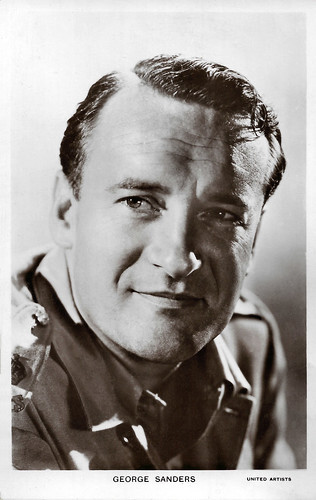
British postcard in the Picturegoer Series, London, no. W 78. Photo: United Artists.
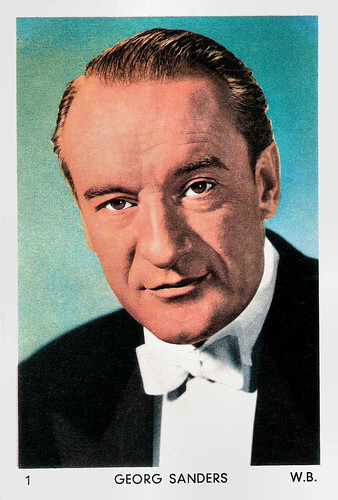
Vintage card, no. 1. Photo: Warner Brothers.
Memorable villains
George Sanders was born in 1906 in Saint Petersburg, Russian Empire. He was the second of three children. His parents, Henry and Margaret Sanders were British. In 1917, when the Russian Revolution broke out, George was eleven years old and the family returned to England.
After his education at Bedales School in Hampshire, Sanders began studying at Brighton College and later at Manchester Technical College. The studies prepared him to follow his father into the textile business. As a businessman, he worked first in textiles and later in tobacco. After a brief sojourn in South America, he returned to the UK.
In the early 1930s, he worked in an advertising agency, where Greer Garson , an aspiring secretary and actress, suggested he become an actor. He took on a small role in the revue 'Ballyhoo'. From chorus boy, he moved to cabaret, radio and theatrical understudy. He made his film debut in Find the Lady (Roland Grillette, 1936). He played one of the leading roles in his second feature film, Strange Cargo (Lawrence Huntington, 1936).
George Sanders tried his luck in Hollywood. He made his first American film Lloyds of London (Henry King, 1936) for 20th Century Fox. The stars were Tyrone Power and Madeleine Carroll . He quickly made a name for himself in adventure hero roles. He was able to increase his popularity with memorable portrayals of villains such as in The House of the Seven Gables (Joe May, 1940).
His elegant figure, deep voice, discreet yet mocking smile and perfect diction - at least by the standards of the time for a well-bred Briton, i.e. in no way identifiable with a region, but reflecting his membership of the upper social classes - naturally led George Sanders to roles as a seducer, often unscrupulous and rather snobbish and cynical.
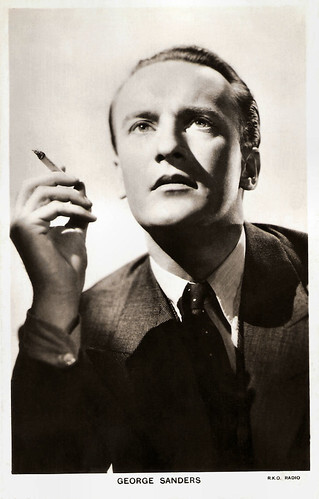
British postcard in the Picturegoer Series, London, no. 1241a. Photo: R.K.O. Radio.
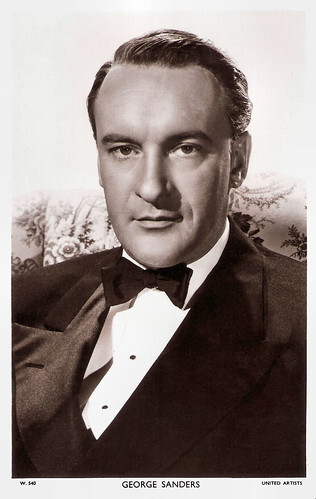
British postcard in the Picturegoer Series, London, no. W 540. Photo: United Artists.
The Saint and the Falcon
Alfred Hitchcock cast George Sanders in his first Hollywood films, Rebecca (1940) and The Foreign Correspondent (1940). Sanders starred in Rebecca as Jack Favell, Laurence Olivier 's devious adversary. In Foreign Correspondent, he had an infinitely more sympathetic role as a clever secret agent.
His physical appearance predestined him not only for portrayals of aristocrats such as in Forever Amber (Otto Preminger, John M. Stahl, 1947) but also for roles in the popular crime film series of the time. Thus, from The Saint Strikes Back (John Farrow, 1939) onwards, he played Simon Templar (The Saint) in a film series, and with The Gay Falcon (Irving Reis, 1941), a similar series around The Falcon was started.
During the Second World War, George also appeared in propaganda films, such as Confessions of a Nazi Spy (Anatole Litvak, 1939) and Man Hunt (Fritz Lang, 1941). Increasingly committed to one type of role, George Sanders said goodbye to the Falcon, leaving it to his brother Thomas Charles Sanders, who also worked as an actor under the pseudonym Tom Conway. Tom succeeded him as The Falcon in The Falcon's Brother (Stanley Logan, 1942).
After the war, Sanders devoted himself more to character roles. Albert Lewin gave him his most significant roles: that of Lord Henry Wotton, a friend of Dorian Gray's painter (Hurd Hatfield) in The Portrait of Dorian Gray (Albert Lewin, 1945), an American fantasy drama based on Oscar Wilde's novel, and then that of the cynical Bel-Ami in The Private Affairs of Bel Ami (Albert Lewin, 1947) after Guy de Maupassant. He particularly often played eloquent and sophisticated, yet seemingly shady characters from the British upper class - for example as the secretly married suitor of Gene Tierney in The Ghost and Mrs. Muir (Joseph L. Mankiewicz, 1947).
Sanders won the Academy Award for Best Supporting Actor for portraying the sophisticated and sarcastic theatre critic Addison DeWitt in the satirical film All About Eve (Joseph L. Mankiewicz, 1950) starring Bette Davis . In England, Sanders starred alongside Robert Taylor in the literary adaptation Ivanhoe (Richard Thorpe, 1953). In 1954 he travelled to Naples where he played the male lead alongside Ingrid Bergman under Roberto Rossellini's direction in the marriage drama Viaggio in Italia/Journey in Italy (1954). Back in the United States, he played an aristocratic villain in the adventure film Moonfleet (Fritz Lang, 1955).
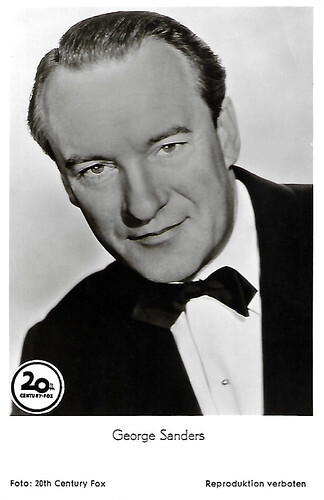
West German postcard by Film-Postkartenverlag, Hambrug-Bergedorf, no. 161. Photo: 20th Century Fox.
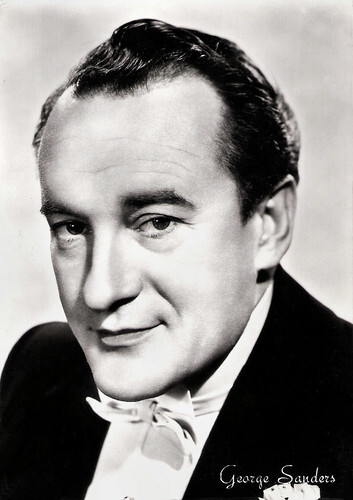
Italian postcard by Rotalfoto, Milano, no. 461.
A fatal cocktail of Nembutal and vodka
After 1955, George Sanders began to appear regularly in television series including The George Sanders Mystery Theater (1957), The Man from U.N.C.L.E. (1965) and Batman (1966) as Mr. Freeze. In the classic Science Fiction horror film The Village of the Damned (Wolf Rilla, 1960), the actor took on the role of retired physicist Gordon Zellaby opposite Barbara Shelley.
Sanders also provided the voice of Shere Khan the tiger in the original version of the Disney animated classic The Jungle Book (Wolfgang Reitherman, 1967). In the British horror film Psychomania (Don Sharp, 1973), starring Nicky Henson, Sanders played his last film role, a servant.
George Sanders committed suicide in 1972 in Catalonia in his hotel room in Castelldefels, south of Barcelona, by drinking a cocktail of Nembutal and vodka to ease the pain of a long illness. He was 65 and was married four times.
Sanders married Susan Larson in 1940. The marriage lasted until 1949. He then married Hungarian actress Zsa Zsa Gabor in 1949. The marriage lasted until 1957. His third wife became the actress Benita Hume in 1959, to whom he was married until her death in 1967. His 1970 marriage to Zsa Zsa Gabor 's older sister Magda lasted only six weeks.
It was at this time that Sanders began to indulge in alcohol. He wrote an autobiography, 'Memoirs of a Professional Cad' (1960), in which he commented very ironically on the course of his life, and also summed up his marriage to Zsa Zsa Gabor .
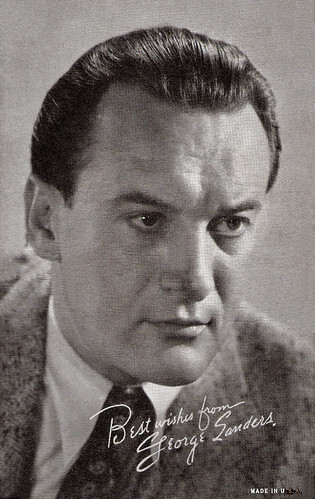
American Arcade card.
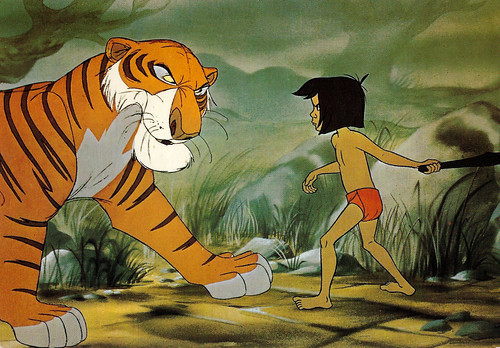
French postcard by Editions G. Picard, Paris, no. WD 8/42. Image: Walt Disney Productions. Shere Khan and Mowgli in The Jungle Book (Wolfgang Reitherman, 1967).
Sources: Wikipedia (English, German and Dutch) and .

British postcard in the Picturegoer Series, London, no. W 78. Photo: United Artists.

Vintage card, no. 1. Photo: Warner Brothers.
Memorable villains
George Sanders was born in 1906 in Saint Petersburg, Russian Empire. He was the second of three children. His parents, Henry and Margaret Sanders were British. In 1917, when the Russian Revolution broke out, George was eleven years old and the family returned to England.
After his education at Bedales School in Hampshire, Sanders began studying at Brighton College and later at Manchester Technical College. The studies prepared him to follow his father into the textile business. As a businessman, he worked first in textiles and later in tobacco. After a brief sojourn in South America, he returned to the UK.
In the early 1930s, he worked in an advertising agency, where Greer Garson , an aspiring secretary and actress, suggested he become an actor. He took on a small role in the revue 'Ballyhoo'. From chorus boy, he moved to cabaret, radio and theatrical understudy. He made his film debut in Find the Lady (Roland Grillette, 1936). He played one of the leading roles in his second feature film, Strange Cargo (Lawrence Huntington, 1936).
George Sanders tried his luck in Hollywood. He made his first American film Lloyds of London (Henry King, 1936) for 20th Century Fox. The stars were Tyrone Power and Madeleine Carroll . He quickly made a name for himself in adventure hero roles. He was able to increase his popularity with memorable portrayals of villains such as in The House of the Seven Gables (Joe May, 1940).
His elegant figure, deep voice, discreet yet mocking smile and perfect diction - at least by the standards of the time for a well-bred Briton, i.e. in no way identifiable with a region, but reflecting his membership of the upper social classes - naturally led George Sanders to roles as a seducer, often unscrupulous and rather snobbish and cynical.

British postcard in the Picturegoer Series, London, no. 1241a. Photo: R.K.O. Radio.

British postcard in the Picturegoer Series, London, no. W 540. Photo: United Artists.
The Saint and the Falcon
Alfred Hitchcock cast George Sanders in his first Hollywood films, Rebecca (1940) and The Foreign Correspondent (1940). Sanders starred in Rebecca as Jack Favell, Laurence Olivier 's devious adversary. In Foreign Correspondent, he had an infinitely more sympathetic role as a clever secret agent.
His physical appearance predestined him not only for portrayals of aristocrats such as in Forever Amber (Otto Preminger, John M. Stahl, 1947) but also for roles in the popular crime film series of the time. Thus, from The Saint Strikes Back (John Farrow, 1939) onwards, he played Simon Templar (The Saint) in a film series, and with The Gay Falcon (Irving Reis, 1941), a similar series around The Falcon was started.
During the Second World War, George also appeared in propaganda films, such as Confessions of a Nazi Spy (Anatole Litvak, 1939) and Man Hunt (Fritz Lang, 1941). Increasingly committed to one type of role, George Sanders said goodbye to the Falcon, leaving it to his brother Thomas Charles Sanders, who also worked as an actor under the pseudonym Tom Conway. Tom succeeded him as The Falcon in The Falcon's Brother (Stanley Logan, 1942).
After the war, Sanders devoted himself more to character roles. Albert Lewin gave him his most significant roles: that of Lord Henry Wotton, a friend of Dorian Gray's painter (Hurd Hatfield) in The Portrait of Dorian Gray (Albert Lewin, 1945), an American fantasy drama based on Oscar Wilde's novel, and then that of the cynical Bel-Ami in The Private Affairs of Bel Ami (Albert Lewin, 1947) after Guy de Maupassant. He particularly often played eloquent and sophisticated, yet seemingly shady characters from the British upper class - for example as the secretly married suitor of Gene Tierney in The Ghost and Mrs. Muir (Joseph L. Mankiewicz, 1947).
Sanders won the Academy Award for Best Supporting Actor for portraying the sophisticated and sarcastic theatre critic Addison DeWitt in the satirical film All About Eve (Joseph L. Mankiewicz, 1950) starring Bette Davis . In England, Sanders starred alongside Robert Taylor in the literary adaptation Ivanhoe (Richard Thorpe, 1953). In 1954 he travelled to Naples where he played the male lead alongside Ingrid Bergman under Roberto Rossellini's direction in the marriage drama Viaggio in Italia/Journey in Italy (1954). Back in the United States, he played an aristocratic villain in the adventure film Moonfleet (Fritz Lang, 1955).

West German postcard by Film-Postkartenverlag, Hambrug-Bergedorf, no. 161. Photo: 20th Century Fox.

Italian postcard by Rotalfoto, Milano, no. 461.
A fatal cocktail of Nembutal and vodka
After 1955, George Sanders began to appear regularly in television series including The George Sanders Mystery Theater (1957), The Man from U.N.C.L.E. (1965) and Batman (1966) as Mr. Freeze. In the classic Science Fiction horror film The Village of the Damned (Wolf Rilla, 1960), the actor took on the role of retired physicist Gordon Zellaby opposite Barbara Shelley.
Sanders also provided the voice of Shere Khan the tiger in the original version of the Disney animated classic The Jungle Book (Wolfgang Reitherman, 1967). In the British horror film Psychomania (Don Sharp, 1973), starring Nicky Henson, Sanders played his last film role, a servant.
George Sanders committed suicide in 1972 in Catalonia in his hotel room in Castelldefels, south of Barcelona, by drinking a cocktail of Nembutal and vodka to ease the pain of a long illness. He was 65 and was married four times.
Sanders married Susan Larson in 1940. The marriage lasted until 1949. He then married Hungarian actress Zsa Zsa Gabor in 1949. The marriage lasted until 1957. His third wife became the actress Benita Hume in 1959, to whom he was married until her death in 1967. His 1970 marriage to Zsa Zsa Gabor 's older sister Magda lasted only six weeks.
It was at this time that Sanders began to indulge in alcohol. He wrote an autobiography, 'Memoirs of a Professional Cad' (1960), in which he commented very ironically on the course of his life, and also summed up his marriage to Zsa Zsa Gabor .

American Arcade card.

French postcard by Editions G. Picard, Paris, no. WD 8/42. Image: Walt Disney Productions. Shere Khan and Mowgli in The Jungle Book (Wolfgang Reitherman, 1967).
Sources: Wikipedia (English, German and Dutch) and .
Published on January 15, 2023 22:00
January 14, 2023
Hans Jaray
Hans Jaray (1906–1990) was an Austrian actor and playwright who starred as a leading man in a number of 1930s films, such as the Schubert biopic Leise flehen meine Lieder/Gently My Songs Entreat (1933). The Czech film Pán na roztrhání/Man in Demand on All Sides (1934) with Lida Baarová was based on one of his plays. Following the Anschluss of 1938, Jaray emigrated to the United States but returned to Vienna after the Second World War. He also wrote and directed several television films.
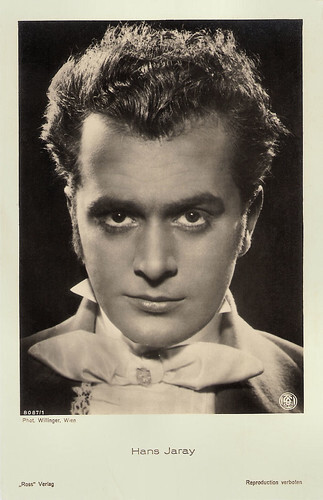
German postcard by Ross Verlag, no. 8087/1, 1933-1934. Photo: Willinger, Vienna. Hans Jaray, probably in the Franz Schubert biopic Leise fliehen meine Lieder/Gently My Songs Entreat (Willi Forst, 1933), while in 1934 an alternative language version was released in English, also with Jaray: Unfinished Symphony (Willi Forst, Anthony Asquith, 1934).
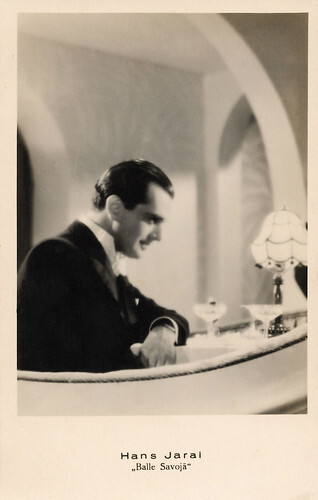
Latvian postcard by Argenta, sent by mail in 1935. Hans Jaray in Ball im Savoy/Ball at the Savoy (István Székely a.k.a. Steve Sekely, 1935).
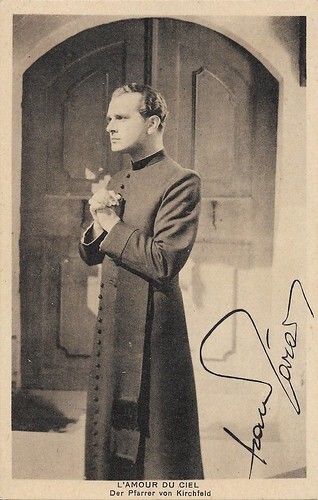
Luxembourgish postcard. Hans Jaray in the title role of the Austrian film Der Pfarrer von Kirchfeld/L'Amour du ciel/The Priest of Kirchfeld (Jakob & Luise Fleck, 1937). Postcard with inkstamp for the Cinema Capitole, Luxembourg.
Playing Franz Schubert
Johann Alexander Jaray was born in 1906 in Vienna, Austria-Hungary. He was the son of the interior designer Karl Hans Jaray and his wife, Valerie Jaray. His parents divorced during his childhood, so the future actor grew up partly in the care of his God-fearing Jewish grandmother in Gmunden.
He attended the Friedberg Institute boarding school in Dresden during the First World War and later the Theresianum in his home town, where his acting talent was first discovered. Against his father's resistance, but with the support of his mother and stepmother Lili Marberg, Jaray successfully applied to the Academy of Music and Performing Arts in Vienna. His class included Paula Wessely , Käthe Gold , Karl Paryla, Albin Skoda and Siegfried Breuer .
His stage debut was in 1923 in the Wiener Volkstheater. Here, Jaray also played his first leading role as a student alongside Albert Bassermann in 'Traumulus' by Arno Holz and Oskar Jeschke. He was engaged at the Neuen Wiener Bühne and then from 1925 to 1930 at the Volkstheater.
From 1930 to 1938, he played at the Theater in der Josefstadt under Max Reinhardt . His comedy 'Ist Geraldine ein Engel?' (Is Geraldine an Angel?) was performed under the pseudonym Hans Honneg with Jaray and Paula Wessely in the leading roles as a Christmas premiere at the Josefstadt.
His two first films were the comedy Schwiegersöhne/Sons in law (Hans Steinhoff, 1926) starring Pat & Patachon and the drama Die Liebe der Jeanne Ney/The Love of Jeanne Ney (Georg Wilhelm Pabst, 1927) with Édith Jéhanne . In 1933, he played Franz Schubert in Leise flehen meine Lieder/Unfinished Symphony (Willi Forst, 1933) with Mártha Eggerth . Through this role, Hans Jaray became one of the best-known film actors in Germany and Austria.
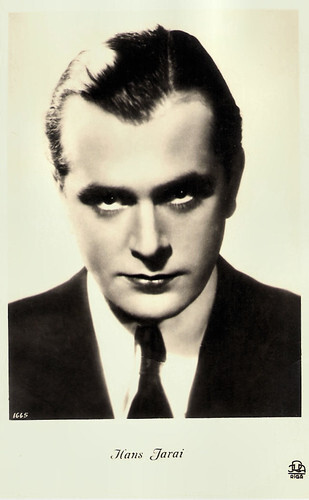
Latvian postcard by JDA, Riga, no. 1665.
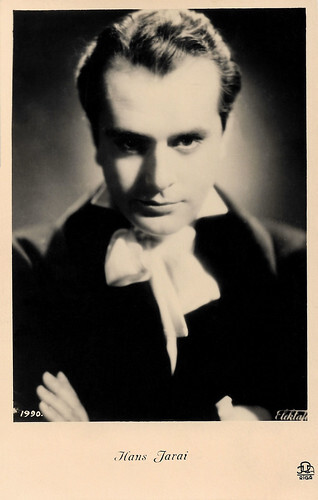
Latvian postcard by JDA, Riga, no. 1990. Photo: Elektafilm.
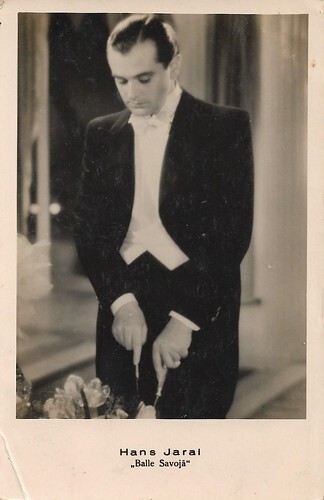
Latvian postcard. Hans Jaray in Ball im Savoy/The Ball at the Savoy (Steve Székely, 1935), scripted by Hermann Kosterlitz (Henry Koster) and Géza von Cziffra.
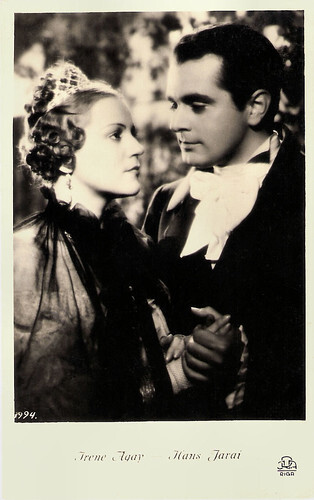
Latvian postcard by JDA, Riga, no. 994. Iren Agay and Hans Jaray in Hoheit tanzt Walzer/Her Highness Dances the Waltz (Max Neufeld, 1935).
A love affair withg Dietrich
After that, Hans Jaray went back to Austria to flee the Nazis. He was in a relationship with Paula Wessely at the time he entered into a love affair with Marlene Dietrich around 1934.
He played parish priest Peter Hell in the film Der Pfarrer von Kirchfeld/The Priest from Kirchfeld (Jacob Fleck and Luise Fleck, 1937), based on the novel by Austrian playwright Ludwig Anzengruber. Being a Jew, he emigrated after the Anschluss (the occupation of Austria by Nazi Germany in 1938) to the USA via Zurich and Paris with his partner at the time, Lili Darvas.
In New York, he played on Broadway. In 1942 he was one of the co-founders of the troupe The Players from Abroad, which consisted mainly of actors who had fled. His two Hollywood films were Lydia (Julien Duvivier, 1941) starring Merle Oberon and Carnegie Hall (Edgar G. Ulmer, 1947), credited as Hans Yaray.
In 1948, he returned to Vienna and joined the Volkstheater. From 1951 he was a member of the Theater in der Josefstadt and in 1986, he became an honorary member. Among his last films were Frühlingsstimmen/Voices of Spring (Hans Thimig, 1952) and after a long absence from the screen, Fedora (Billy Wilder, 1978) with Marthe Keller and Hildegard Knef . In 1960 he became head of the school of dramatic art, the Max Reinhardt Seminar.
He wrote eight plays and several books. In 1948, he, published in the USA the novel 'One Day Missing'. His life story 'Was ich kaum erträumen konnte...' (What I could hardly dream...), written shortly before his death, was published posthumously in 1990. Hans Jaray passed away in 1990 in Vienna. His honorary grave is in the Hietzinger Friedhof (Hietzing cemetery) in Vienna.

Dutch photo. Front of the Rembrandt Theater in Amsterdam, The Netherlands. On show was Leise flehen meine Lieder (Willi Forst, 1933), starring Marta Eggerth , Hans Jaray and Hans Moser . A gift by Roloff de Jeu.
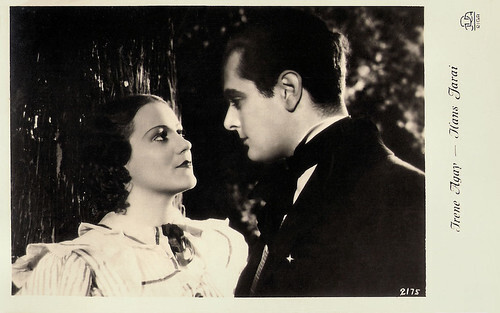
Latvian postcard by JDA, Riga, no. 2175. Iren Agay and Hans Jaray in Hoheit tanzt Walzer/Her Highness Dances the Waltz (Max Neufeld, 1935).
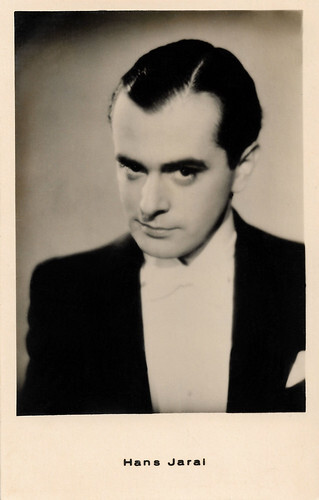
Latvian postcard by Argenta.
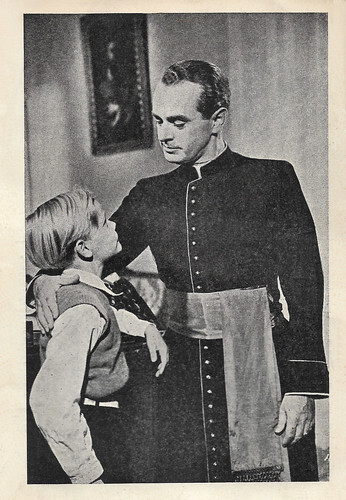
Dutch promotion postcard for Capitol Theater. Hans Jaray in Frühlingsstimmen/Voices of Spring (Hans Thimig, 1952).
Sources: (IMDb), CSFD (Czech), Wikipedia (German and English) and.

German postcard by Ross Verlag, no. 8087/1, 1933-1934. Photo: Willinger, Vienna. Hans Jaray, probably in the Franz Schubert biopic Leise fliehen meine Lieder/Gently My Songs Entreat (Willi Forst, 1933), while in 1934 an alternative language version was released in English, also with Jaray: Unfinished Symphony (Willi Forst, Anthony Asquith, 1934).

Latvian postcard by Argenta, sent by mail in 1935. Hans Jaray in Ball im Savoy/Ball at the Savoy (István Székely a.k.a. Steve Sekely, 1935).

Luxembourgish postcard. Hans Jaray in the title role of the Austrian film Der Pfarrer von Kirchfeld/L'Amour du ciel/The Priest of Kirchfeld (Jakob & Luise Fleck, 1937). Postcard with inkstamp for the Cinema Capitole, Luxembourg.
Playing Franz Schubert
Johann Alexander Jaray was born in 1906 in Vienna, Austria-Hungary. He was the son of the interior designer Karl Hans Jaray and his wife, Valerie Jaray. His parents divorced during his childhood, so the future actor grew up partly in the care of his God-fearing Jewish grandmother in Gmunden.
He attended the Friedberg Institute boarding school in Dresden during the First World War and later the Theresianum in his home town, where his acting talent was first discovered. Against his father's resistance, but with the support of his mother and stepmother Lili Marberg, Jaray successfully applied to the Academy of Music and Performing Arts in Vienna. His class included Paula Wessely , Käthe Gold , Karl Paryla, Albin Skoda and Siegfried Breuer .
His stage debut was in 1923 in the Wiener Volkstheater. Here, Jaray also played his first leading role as a student alongside Albert Bassermann in 'Traumulus' by Arno Holz and Oskar Jeschke. He was engaged at the Neuen Wiener Bühne and then from 1925 to 1930 at the Volkstheater.
From 1930 to 1938, he played at the Theater in der Josefstadt under Max Reinhardt . His comedy 'Ist Geraldine ein Engel?' (Is Geraldine an Angel?) was performed under the pseudonym Hans Honneg with Jaray and Paula Wessely in the leading roles as a Christmas premiere at the Josefstadt.
His two first films were the comedy Schwiegersöhne/Sons in law (Hans Steinhoff, 1926) starring Pat & Patachon and the drama Die Liebe der Jeanne Ney/The Love of Jeanne Ney (Georg Wilhelm Pabst, 1927) with Édith Jéhanne . In 1933, he played Franz Schubert in Leise flehen meine Lieder/Unfinished Symphony (Willi Forst, 1933) with Mártha Eggerth . Through this role, Hans Jaray became one of the best-known film actors in Germany and Austria.

Latvian postcard by JDA, Riga, no. 1665.

Latvian postcard by JDA, Riga, no. 1990. Photo: Elektafilm.

Latvian postcard. Hans Jaray in Ball im Savoy/The Ball at the Savoy (Steve Székely, 1935), scripted by Hermann Kosterlitz (Henry Koster) and Géza von Cziffra.

Latvian postcard by JDA, Riga, no. 994. Iren Agay and Hans Jaray in Hoheit tanzt Walzer/Her Highness Dances the Waltz (Max Neufeld, 1935).
A love affair withg Dietrich
After that, Hans Jaray went back to Austria to flee the Nazis. He was in a relationship with Paula Wessely at the time he entered into a love affair with Marlene Dietrich around 1934.
He played parish priest Peter Hell in the film Der Pfarrer von Kirchfeld/The Priest from Kirchfeld (Jacob Fleck and Luise Fleck, 1937), based on the novel by Austrian playwright Ludwig Anzengruber. Being a Jew, he emigrated after the Anschluss (the occupation of Austria by Nazi Germany in 1938) to the USA via Zurich and Paris with his partner at the time, Lili Darvas.
In New York, he played on Broadway. In 1942 he was one of the co-founders of the troupe The Players from Abroad, which consisted mainly of actors who had fled. His two Hollywood films were Lydia (Julien Duvivier, 1941) starring Merle Oberon and Carnegie Hall (Edgar G. Ulmer, 1947), credited as Hans Yaray.
In 1948, he returned to Vienna and joined the Volkstheater. From 1951 he was a member of the Theater in der Josefstadt and in 1986, he became an honorary member. Among his last films were Frühlingsstimmen/Voices of Spring (Hans Thimig, 1952) and after a long absence from the screen, Fedora (Billy Wilder, 1978) with Marthe Keller and Hildegard Knef . In 1960 he became head of the school of dramatic art, the Max Reinhardt Seminar.
He wrote eight plays and several books. In 1948, he, published in the USA the novel 'One Day Missing'. His life story 'Was ich kaum erträumen konnte...' (What I could hardly dream...), written shortly before his death, was published posthumously in 1990. Hans Jaray passed away in 1990 in Vienna. His honorary grave is in the Hietzinger Friedhof (Hietzing cemetery) in Vienna.

Dutch photo. Front of the Rembrandt Theater in Amsterdam, The Netherlands. On show was Leise flehen meine Lieder (Willi Forst, 1933), starring Marta Eggerth , Hans Jaray and Hans Moser . A gift by Roloff de Jeu.

Latvian postcard by JDA, Riga, no. 2175. Iren Agay and Hans Jaray in Hoheit tanzt Walzer/Her Highness Dances the Waltz (Max Neufeld, 1935).

Latvian postcard by Argenta.

Dutch promotion postcard for Capitol Theater. Hans Jaray in Frühlingsstimmen/Voices of Spring (Hans Thimig, 1952).
Sources: (IMDb), CSFD (Czech), Wikipedia (German and English) and.
Published on January 14, 2023 22:00
January 13, 2023
Three films starring Bruno Kastner: Die goldene Lüge (1919), La bodega de Los Cuerros (1919) and Artistentreue (1919)
German actor Bruno Kastner (1890-1932) was the heartthrob of German silent cinema. His parts as the elegant and charming dandy made him one of the most beloved stars of the 1910s and 1920s. In this film special, we present three of his films from 1919: Die goldene Lüge/The Golden Lie, Artistentreue/Devoted Artists and La bodega de Los Cuerros/The Bodega of Los Cuerros, all directed by Erik Lind.
Die goldene Lüge (1919)
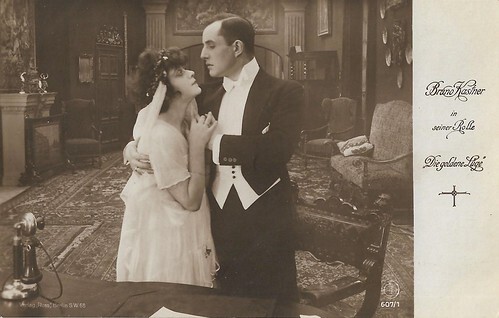
German postcard by Ross Verlag, no. 607/1. Photo: Ring-Film. Bruno Kastner and Ria Jende in the German silent film Die goldene Lüge/The Golden Lie (Erik Lund, 1919).
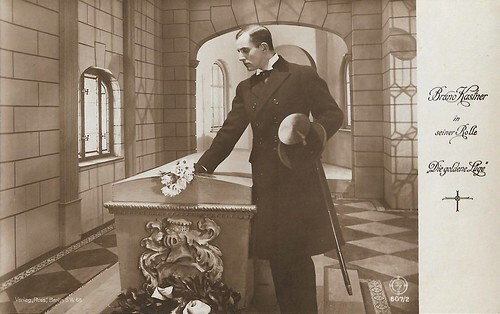
German postcard by Ross Verlag, no. 607/2. Photo: Ring-Film. Bruno Kastner in Die goldene Lüge/The Golden Lie (Erik Lund, 1919).
Die goldene Lüge/The Golden Lie (1919) Bruno Kastner plays Ralf Sporeck, the son of a count in great debt. He marries a banker's daughter ( Ria Jende ). When he finds out he isn't a count at all, he wants to leave.
The film was scripted by Georg Kaiser and cinematographed by Curt Courant. Sets may have been by Siegfried Wroblewsky. Leopold von Ledebur played either the old count or the banker. In April 1919 the film was screened at the Berlin Tauentzienpalast.
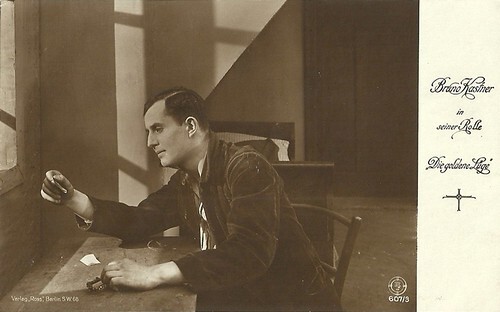
German postcard by Ross Verlag, no. 607/3. Photo: Ring-Film. Bruno Kastner in Die goldene Lüge/The Golden Lie (Erik Lund, 1919).
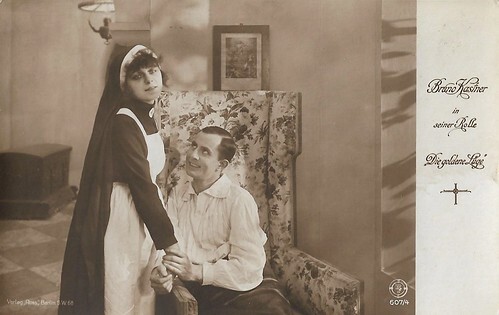
German postcard by Ross Verlag, no. 607/4. Photo: Ring-Film. Bruno Kastner and Ria Jende in the German silent film Die goldene Lüge/The Golden Lie (Erik Lund, 1919).
Die Bodega von Los Cuerros (1919)
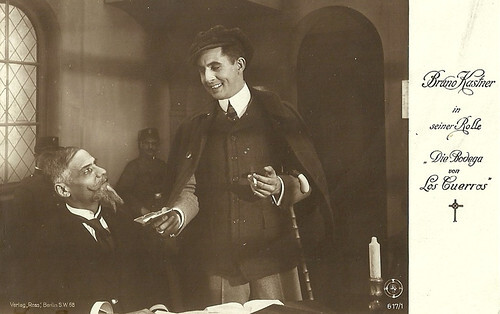
German postcard by Ross Verlag, no. 617/1. Photo: Ring Film. Bruno Kastner in Die Bodega von Los Cuerros/The Bodega of Los Cuerros (Erik Lund, 1919).
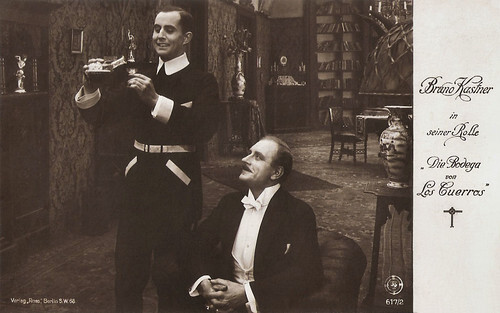
German postcard by Ross Verlag, no. 617/2. Photo: Ring Film. Bruno Kastner (left) in Die Bodega von Los Cuerros/The Bodega of Los Cuerros (Erik Lund, 1919).
Die Bodega von Los Cuerros/The Bodega of Los Cuerros (1919) was directed by Erik Lund, scripted by Ruth Goetz and cinematographed by Curt Courant. Little is known about this film, starring Bruno Kastner and costarring Ria Jende, Leopold von Ledebur, Rosa Liechtenstein , Paul Biensfeldt, Hermann Picha and others, must have been a crime and adventure film, possibly with Kastner as a detective. The film premiered in Berlin on 2 August 1919, so half a year after the armistice that ended the First World War.
Director Erik Lund was born Manfred Liebenau in Berlin in 1893. He began his career as an architect before being engaged by director-producer Joe May as manager. In 1918 he founded the company Ring-Film GmbH and became its producer. In the same year, Lund married May's daughter Eva May and also became film director at Ring-Film. The first films of Ring-Film such as Erträumtes (1918) with Eva May were still directed by Adolf Gärtner, but quite soon Lund became co-director or sole director.
Ring Film flourished in the years 1918-1921. From 1918 Lund directed many films with his wife Eva May , such as Sadja (1918), Staatsanwalt Jordan (1919), Die verwunschene Prinzessin (1919), Das törichte Herz (1919), and Die Fee von Saint Ménard (1919). From 1919 many of the scripts for Ring-Film were written by Ruth Goetz, while Curt Courant was the regular cinematographer.
From 1919 Lund also directed the beloved male star Bruno Kastner in many films, such as Die Bodega von Los Cuerros (1919), Die goldene Lüge (1919), and Das Herz des Casanova (1919). For many of those films, he was also responsible as the producer, and for a few of them, he also wrote the screenplay. In the early 1920s, he made his last films as director, e.g. Präsident Barrada (1920) with Michael Bohnen, but most were with Bruno Kastner in the lead, such as Weisse Rosen (1920), the serial film Der Silberkönig (1921), Der bekannte Unbekannte (1922), and Das Geheimnis von Schloss Ronay (1922). The latter two were produced by Kastner's own film company Kastner Film.
From 1921, Lund worked for Delta Film, Kastner Film, and Ring-Film AG, not to be confused with Lund's former company. Ring-Film AG is mostly known for the Harry Piel films of 1927-1928. Apart from a last producer's job with Ring-Film AG, the period piece Götz von Berlingen (1925) starring Eugen Klöpfer, Lund did not work in film after 1922. From 1930 Lund retook his work in the German - by now sound - film industry, but now as production manager and under his original name, e.g. for Das Land des Lächelns (Max Reichmann, 1930) and Die große Attraktion (Max Reichmann, 1931). After 1931 Lund definitely left the German film world. It is unknown where and when he died.
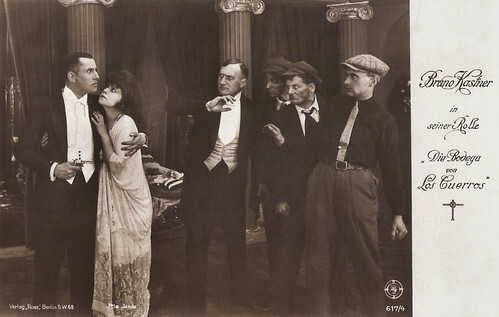
German postcard by Ross Verlag, no. 617/4. Photo: Ring Film. Bruno Kastner and Ria Jende in Die Bodega von Los Cuerros/The Bodega of Los Cuerros (Erik Lund, 1919). The man in the middle could well be Leopold von Ledebur.
Artistentreue (1919)
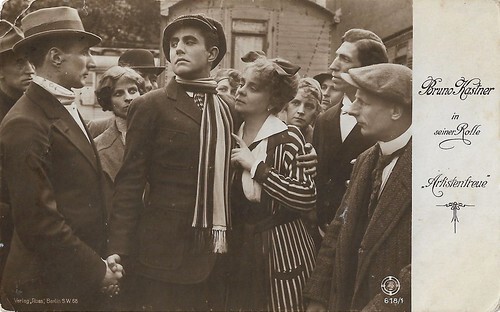
German postcard by Ross Verlag, no. 618/1. Photo: Ring-Film. Bruno Kastner in Artistentreue/Devoted Artists (Erik Lund, 1919).
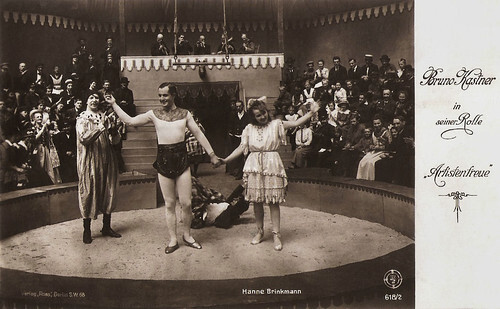
German postcard by Ross Verlag, no. 618/2. Photo: Ring-Film. Bruno Kastner and Hanne Brinkmann in Artistentreue/Devoted Artists (Erik Lund, 1919).
John Lind, a presumed cousin (Leopold von Ledebur) of a count (Karl von Platen), abducts the count's daughter (Hanne Brinkmann), but he is unmasked by circus artist James ( Bruno Kastner ). The hero gets the girl as a reward.
Artistentreue (1919) was scripted by Georg Kaiser, cinematographed by Curt Courant, while sets were (probably) by Siegfried Wroblewsky. The film premiered at the Berlin cinema Biophon in December 1919.
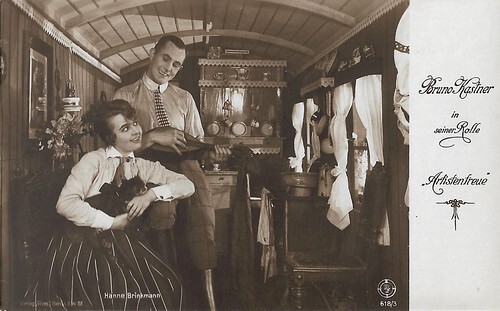
German postcard by Ross Verlag, no. 618/3. Photo: Ring-Film. Bruno Kastner and Hanne Brinkmann in Artistentreue/Devoted Artists (Erik Lund, 1919).
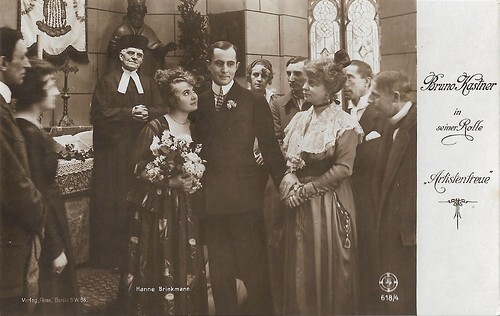
German postcard by Ross Verlag, no. 618/4. Photo: Ring-Film. Bruno Kastner and Hanne Brinkmann in Artistentreue/Devoted Artists (Erik Lund, 1919).
Sources: Early Cinema, Wikipedia (German and English) and IMDb.
Die goldene Lüge (1919)

German postcard by Ross Verlag, no. 607/1. Photo: Ring-Film. Bruno Kastner and Ria Jende in the German silent film Die goldene Lüge/The Golden Lie (Erik Lund, 1919).

German postcard by Ross Verlag, no. 607/2. Photo: Ring-Film. Bruno Kastner in Die goldene Lüge/The Golden Lie (Erik Lund, 1919).
Die goldene Lüge/The Golden Lie (1919) Bruno Kastner plays Ralf Sporeck, the son of a count in great debt. He marries a banker's daughter ( Ria Jende ). When he finds out he isn't a count at all, he wants to leave.
The film was scripted by Georg Kaiser and cinematographed by Curt Courant. Sets may have been by Siegfried Wroblewsky. Leopold von Ledebur played either the old count or the banker. In April 1919 the film was screened at the Berlin Tauentzienpalast.

German postcard by Ross Verlag, no. 607/3. Photo: Ring-Film. Bruno Kastner in Die goldene Lüge/The Golden Lie (Erik Lund, 1919).

German postcard by Ross Verlag, no. 607/4. Photo: Ring-Film. Bruno Kastner and Ria Jende in the German silent film Die goldene Lüge/The Golden Lie (Erik Lund, 1919).
Die Bodega von Los Cuerros (1919)

German postcard by Ross Verlag, no. 617/1. Photo: Ring Film. Bruno Kastner in Die Bodega von Los Cuerros/The Bodega of Los Cuerros (Erik Lund, 1919).

German postcard by Ross Verlag, no. 617/2. Photo: Ring Film. Bruno Kastner (left) in Die Bodega von Los Cuerros/The Bodega of Los Cuerros (Erik Lund, 1919).
Die Bodega von Los Cuerros/The Bodega of Los Cuerros (1919) was directed by Erik Lund, scripted by Ruth Goetz and cinematographed by Curt Courant. Little is known about this film, starring Bruno Kastner and costarring Ria Jende, Leopold von Ledebur, Rosa Liechtenstein , Paul Biensfeldt, Hermann Picha and others, must have been a crime and adventure film, possibly with Kastner as a detective. The film premiered in Berlin on 2 August 1919, so half a year after the armistice that ended the First World War.
Director Erik Lund was born Manfred Liebenau in Berlin in 1893. He began his career as an architect before being engaged by director-producer Joe May as manager. In 1918 he founded the company Ring-Film GmbH and became its producer. In the same year, Lund married May's daughter Eva May and also became film director at Ring-Film. The first films of Ring-Film such as Erträumtes (1918) with Eva May were still directed by Adolf Gärtner, but quite soon Lund became co-director or sole director.
Ring Film flourished in the years 1918-1921. From 1918 Lund directed many films with his wife Eva May , such as Sadja (1918), Staatsanwalt Jordan (1919), Die verwunschene Prinzessin (1919), Das törichte Herz (1919), and Die Fee von Saint Ménard (1919). From 1919 many of the scripts for Ring-Film were written by Ruth Goetz, while Curt Courant was the regular cinematographer.
From 1919 Lund also directed the beloved male star Bruno Kastner in many films, such as Die Bodega von Los Cuerros (1919), Die goldene Lüge (1919), and Das Herz des Casanova (1919). For many of those films, he was also responsible as the producer, and for a few of them, he also wrote the screenplay. In the early 1920s, he made his last films as director, e.g. Präsident Barrada (1920) with Michael Bohnen, but most were with Bruno Kastner in the lead, such as Weisse Rosen (1920), the serial film Der Silberkönig (1921), Der bekannte Unbekannte (1922), and Das Geheimnis von Schloss Ronay (1922). The latter two were produced by Kastner's own film company Kastner Film.
From 1921, Lund worked for Delta Film, Kastner Film, and Ring-Film AG, not to be confused with Lund's former company. Ring-Film AG is mostly known for the Harry Piel films of 1927-1928. Apart from a last producer's job with Ring-Film AG, the period piece Götz von Berlingen (1925) starring Eugen Klöpfer, Lund did not work in film after 1922. From 1930 Lund retook his work in the German - by now sound - film industry, but now as production manager and under his original name, e.g. for Das Land des Lächelns (Max Reichmann, 1930) and Die große Attraktion (Max Reichmann, 1931). After 1931 Lund definitely left the German film world. It is unknown where and when he died.

German postcard by Ross Verlag, no. 617/4. Photo: Ring Film. Bruno Kastner and Ria Jende in Die Bodega von Los Cuerros/The Bodega of Los Cuerros (Erik Lund, 1919). The man in the middle could well be Leopold von Ledebur.
Artistentreue (1919)

German postcard by Ross Verlag, no. 618/1. Photo: Ring-Film. Bruno Kastner in Artistentreue/Devoted Artists (Erik Lund, 1919).

German postcard by Ross Verlag, no. 618/2. Photo: Ring-Film. Bruno Kastner and Hanne Brinkmann in Artistentreue/Devoted Artists (Erik Lund, 1919).
John Lind, a presumed cousin (Leopold von Ledebur) of a count (Karl von Platen), abducts the count's daughter (Hanne Brinkmann), but he is unmasked by circus artist James ( Bruno Kastner ). The hero gets the girl as a reward.
Artistentreue (1919) was scripted by Georg Kaiser, cinematographed by Curt Courant, while sets were (probably) by Siegfried Wroblewsky. The film premiered at the Berlin cinema Biophon in December 1919.

German postcard by Ross Verlag, no. 618/3. Photo: Ring-Film. Bruno Kastner and Hanne Brinkmann in Artistentreue/Devoted Artists (Erik Lund, 1919).

German postcard by Ross Verlag, no. 618/4. Photo: Ring-Film. Bruno Kastner and Hanne Brinkmann in Artistentreue/Devoted Artists (Erik Lund, 1919).
Sources: Early Cinema, Wikipedia (German and English) and IMDb.
Published on January 13, 2023 22:00
January 12, 2023
Lucille Ball
American red-haired actress Lucille Ball (1911-1989) was well-known as the crazy, accident-prone, lovable Lucy Ricardo in the television series I Love Lucy (1951-1957). She appeared in numerous films in Hollywood in the 1930s and 1940s before becoming one of America's most popular television comedians in 1951. She was also a producer on I Love Lucy and subsequent television series featuring the character of "Lucy" with her company Desilu Productions, making her the first head of a major film studio in the American show business.
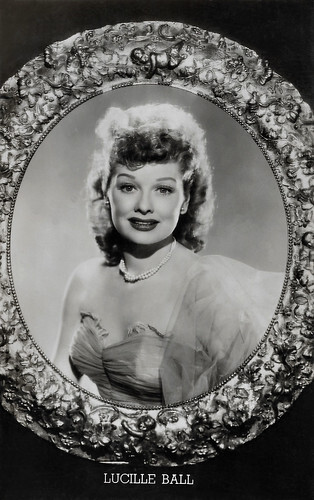
Vintage postcard, no. 451. Photo: Paramount Films.
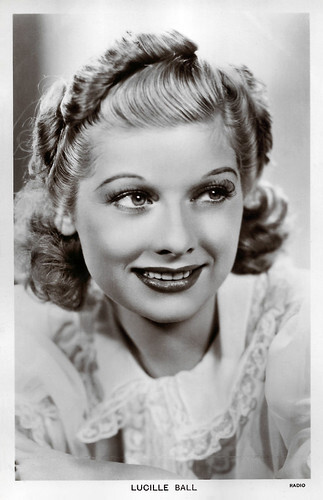
British postcard in the Picturegoer Series, London, no. 1283. Photo: Radio.
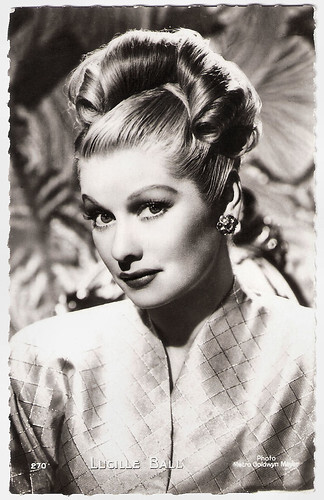
French postcard by Editions P.I., Paris, offered by Les Carbones Multiplane, no. 270. Photo: Clarence Sinclair Bull / Metro-Goldwyn-Mayer, 1945.
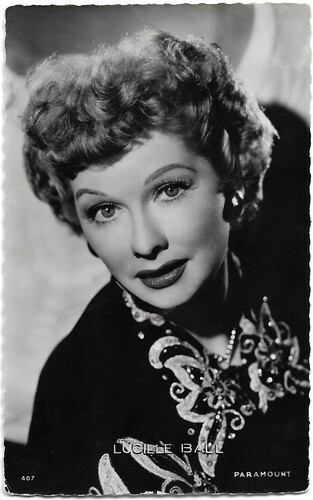
French postcard by Editions P.I., Paris, no. 407. Photo: Paramount Pictures Inc., 1948.
Yearning to make some noice
Lucille Désirée Ball was born in Jamestown, New York, in 1911. Her father was Henry Durrell Ball and her mother Desiree Eve Hunt. Her father died in 1915 before she was four. Lucille and her younger brother Fred were raised by their grandparents while their mother worked several jobs.
Her grandfather was an avid supporter of the theatre and encouraged Lucy to participate in plays at school. Always willing to take responsibility for her brother and young cousins, she was a restless teenager who yearned to "make some noise". She enrolled in the John Murray Anderson School for the Dramatic Arts. There, however, she had a tough competitor who trumped her, Bette Davis . The teachers said she was 'too shy' and had no future and Ball returned home.
In 1932, she moved to New York to become an actress and had success there as a mannequin and revue dancer. But her acting career did not take off till she was chosen to be a "Goldwyn Girl" and appeared in the film Roman Scandals (Frank Tuttle, 1933) starring Eddie Cantor. She was put under contract with RKO Radio Pictures and several bit roles, including one in Top Hat (Mark Sandrich, 1935). She became friends with Ginger Rogers .
In the 1930s she was under contract to RKO and Columbia Pictures and slowly worked her way up from small roles, unnamed in the credits, to more substantial parts. One of her first supporting roles was in Chatterbox (George Nichols Jr., 1936) in which she plays a temperamental actress. It was one of the first times her name was mentioned in the credits. She also got a good role in the A-picture Stage Door (Gregory La Cava, 1937) with Katharine Hepburn and Ginger Rogers . She played more supporting roles, including in Room Service (William A. Seiter, 1938) with the Marx Brothers, but she rarely got leading roles in major films, however, and usually when all the major film stars at RKO had already turned down the part.
In 1940, Lucille Ball met Cuban bandleader-actor, Desi Arnaz, while filming the musical Too Many Girls (George Abbott, 1940). Despite different personalities, lifestyles, religions and ages (he was six years younger), he fell hard, too, and after a passionate romance, they eloped and were married in November 1940. The couple received a lot of media attention. Two years later, Arnaz had to join the army and was unfaithful. A knee injury allowed him to leave the army. In 1944, Ball filed for divorce but later recanted.
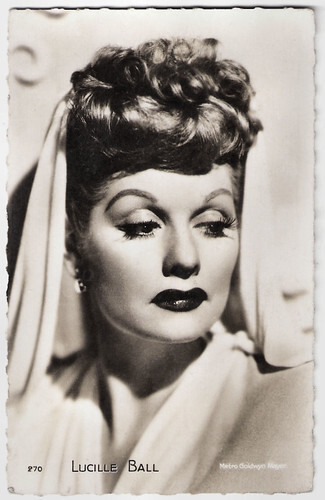
French postcard by Editions P.I., Paris, offered by Victoria, Bruxelles/Brussel, no. 270. Photo: Metro-Goldwyn-Mayer. Publicity still for Lured (Douglas Sirk, 1947).
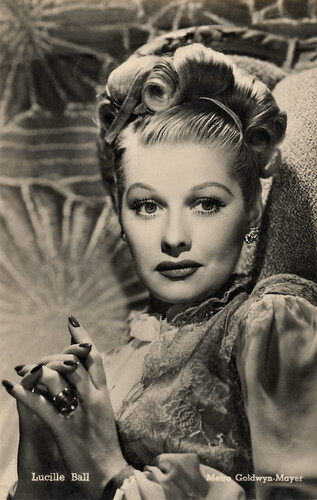
Dutch postcard by MPEA. Sent by mail in 1948. Photo: Clarence Sinclair Bull / Metro-Goldwyn-Mayer.
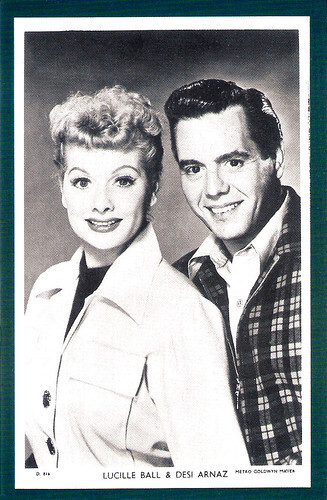
British postcard in the Nostalgia Postcard series by Irish Publishing Ltd, 1981, Set 28, no. D. 816. Photo: Metro Goldwyn Mayer. Lucille Ball and Desi Arnaz.
The most popular and universally beloved sitcom of all time
In the 1940s Lucille Ball moved to Metro-Goldwyn-Mayer, where she got better roles in films such as Du Barry Was a Lady (Roy Del Ruth, 1943) with Red Skelton and Gene Kelly , Best Foot Forward (Edward Buzzell, 1943) and the Katharine Hepburn -Spencer Tracy vehicle Without Love (Harold S. Bucquet, 1945). She failed to achieve major film success there either and returned to Columbia.
She was known in Hollywood circles as the "B-movie queen" with Macdonald Carey as her "king". In 1948, she got a role in the radio comedy 'My Favorite Husband', in which she played the scatterbrained wife of a Midwestern banker. The show became a success and CBS asked her to turn it into a television series. She only wanted to do this if she could work with her husband, and they had creative control over the series. Ball wanted to work with Arnaz to save her marriage.
So I Love Lucy was born, the most popular and universally beloved sitcom of all time. The couple had started their own production company: Desilu Productions. CBS, however, was not impressed with the TV pilot episode, but after Ball and Arnaz toured vaudeville theatre with great success, the series came to television. As a side effect, she practically invented the sitcom and was one of the first stars to film with a live audience.
The show was shot directly to film stock, unlike most other television shows of the time, which used the low-quality kinescope process to film images from a television monitor. The better quality of the Lucy show allowed it to be repeated via syndication (on independent television stations not affiliated with one of the major television networks ABC, CBS or NBC). During the production of I Love Lucy, German-born cameraman Karl Freund invented the "3-camera setup", now standard in television. Another unusual technique used on the Lucy show was to paint over unwanted shadows and hide lighting defects with paint that was kept in the studio in various shades from white to medium grey for this purpose.
In 1951 her first child was born, Lucie Arnaz, followed a year later by Desi Arnaz Jr. The pregnancy was also supposed to be televised but CBS was not in favour of that, eventually, they were allowed to do it but they were not allowed to use the word "pregnant" but had to say "expecting". In 1953, Ball had to appear before the House Committee on Un-American Activities because, at the insistence of her socialist grandfather, she had registered as a supporter of the Communist Party for the 1936 primaries. In 1956, Desilu bought the RKO lot and moved there. In 1957, the last episode of I Love Lucy was aired and was followed by its sequels The Lucy-Desi Comedy Hour (1957-1960) and The Lucy Show (1962-1968), which was later renamed Here's Lucy (1968-1974).
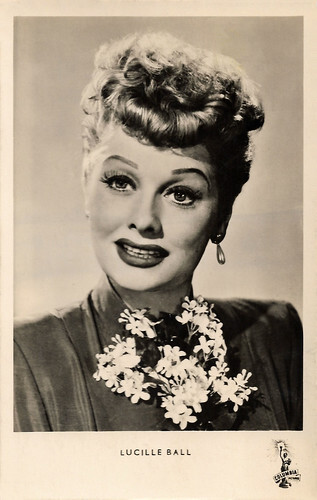
West German postcard by Kunst und Bild, Berlin, no. A 110. Photo: Columbia.
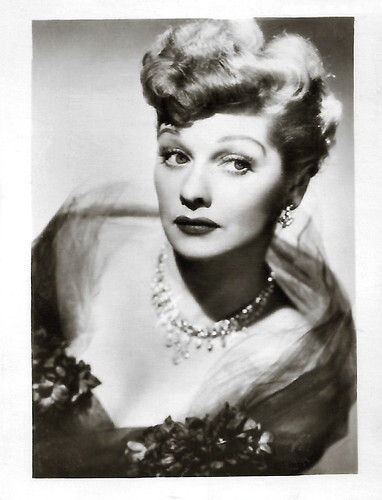
Small German collectors card in the 'Film Stars der Welt ' series by Greiling-Sammelbilder, series C, nr. 111. Photo: Paramount.
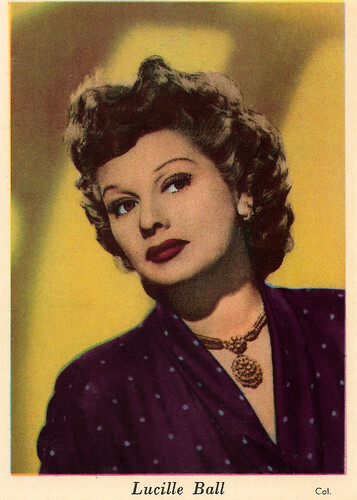
Vintage collectors card. Photo: Columbia.
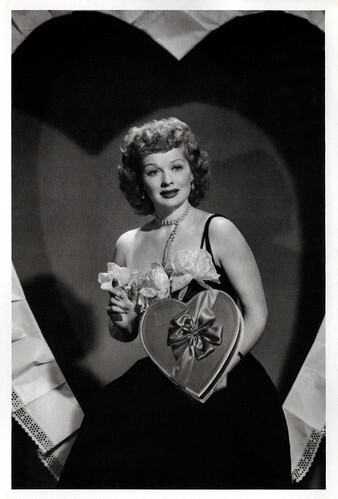
American postcard by The American Postcard Co. Inc., no. 781, 1983.
The sole owner of the studio
In 1960, Lucille Ball and Desi Arnaz's marriage was divorced after problems Arnaz had with alcohol, drugs and other women. Lucille bought his share in Desilu, making her the sole owner of the studio. In the following years, Desilu developed such popular television series as The Untouchables (1959-1963), Star Trek (1966-1969), Mission: Impossible (1966-1973) and Mannix (1967-1975).
In 1967, Desilu was sold to Gulf and Western Industries, which merged Desilu with Paramount Studios, located on the property next door. Arnaz and Ball remained good friends until his death in 1986. In 1961, Ball married stand-up comedy actor Gary Morton who was 12 years younger. He had never seen her on television because he himself performed on primetime when Lucy was on TV. He got a job at Desilu.
After The Lucy-Desi Comedy Hour, Lucille got a series of her own, The Lucy Show (1962-1968) with Gale Gordon and Vivian Vance. It was again a success. Vivian Vance was given the name Viv, which she got because she was tired of being addressed as Ethel on the street. In 1968, after Lucille sold Desilu, she founded Lucille Ball Production. Lucille's third sitcom was Here's Lucy (1968-1974), played with her real children, Lucie Arnaz and Desi Arnaz Jr. Also in this series, Gale Gordon was her co-star.
After I Love Lucy, Lucille starred in several more films including Yours, Mine, and Ours (Melville Shavelson, 1968) with Henry Fonda , the musical Mame (Gene Saks, 1974) and the TV movie Stone Pillow (George Schaefer, 1985). In 1986, she made a comeback with the series Life with Lucy, but it flopped with critics and viewers alike. After playing for less than two months, the series was cancelled by ABC.
Lucille Ball was a guest on several shows. In 1989 at the 61st Academy Awards, she presented the Academy Awards with Bob Hope, she then received a standing ovation. A month later in 1989, Lucille Ball died of aortic dissection at the age of 77. She was buried in Forest Lawn - Hollywood Hills Cemetery in Los Angeles but was later moved by her children, Desi Arnaz Jr. and Lucie Arnaz, to Lake View Cemetery in her native Jamestown.
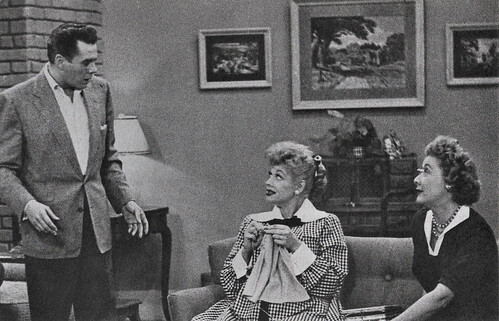
American postcard by Bizzaro, Greenville, RI, no. 02828, 1990. Lucille Ball, Desi Arnaz and Vivian Vance in the TV series I Love Lucy (1951-1957).
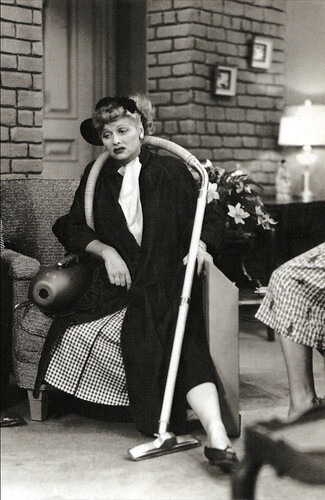
American postcard by the American Postcard Company Inc. (AP), no. 723, 1983. Photo: CBS. Lucille Ball in the episode Sales resistance #45 (1953) of the TV series I Love Lucy (1951-1957).
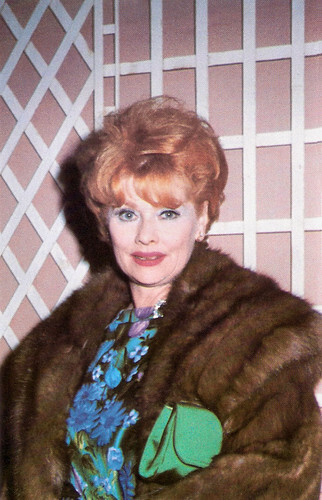
American postcard by Coral-Lee, Rancho Cordova, CA, no. CL-Personality # 59-1980 C33289. Photo: Luke Juhasz.
Source: Wikipedia (Dutch, German and English) and .

Vintage postcard, no. 451. Photo: Paramount Films.

British postcard in the Picturegoer Series, London, no. 1283. Photo: Radio.

French postcard by Editions P.I., Paris, offered by Les Carbones Multiplane, no. 270. Photo: Clarence Sinclair Bull / Metro-Goldwyn-Mayer, 1945.

French postcard by Editions P.I., Paris, no. 407. Photo: Paramount Pictures Inc., 1948.
Yearning to make some noice
Lucille Désirée Ball was born in Jamestown, New York, in 1911. Her father was Henry Durrell Ball and her mother Desiree Eve Hunt. Her father died in 1915 before she was four. Lucille and her younger brother Fred were raised by their grandparents while their mother worked several jobs.
Her grandfather was an avid supporter of the theatre and encouraged Lucy to participate in plays at school. Always willing to take responsibility for her brother and young cousins, she was a restless teenager who yearned to "make some noise". She enrolled in the John Murray Anderson School for the Dramatic Arts. There, however, she had a tough competitor who trumped her, Bette Davis . The teachers said she was 'too shy' and had no future and Ball returned home.
In 1932, she moved to New York to become an actress and had success there as a mannequin and revue dancer. But her acting career did not take off till she was chosen to be a "Goldwyn Girl" and appeared in the film Roman Scandals (Frank Tuttle, 1933) starring Eddie Cantor. She was put under contract with RKO Radio Pictures and several bit roles, including one in Top Hat (Mark Sandrich, 1935). She became friends with Ginger Rogers .
In the 1930s she was under contract to RKO and Columbia Pictures and slowly worked her way up from small roles, unnamed in the credits, to more substantial parts. One of her first supporting roles was in Chatterbox (George Nichols Jr., 1936) in which she plays a temperamental actress. It was one of the first times her name was mentioned in the credits. She also got a good role in the A-picture Stage Door (Gregory La Cava, 1937) with Katharine Hepburn and Ginger Rogers . She played more supporting roles, including in Room Service (William A. Seiter, 1938) with the Marx Brothers, but she rarely got leading roles in major films, however, and usually when all the major film stars at RKO had already turned down the part.
In 1940, Lucille Ball met Cuban bandleader-actor, Desi Arnaz, while filming the musical Too Many Girls (George Abbott, 1940). Despite different personalities, lifestyles, religions and ages (he was six years younger), he fell hard, too, and after a passionate romance, they eloped and were married in November 1940. The couple received a lot of media attention. Two years later, Arnaz had to join the army and was unfaithful. A knee injury allowed him to leave the army. In 1944, Ball filed for divorce but later recanted.

French postcard by Editions P.I., Paris, offered by Victoria, Bruxelles/Brussel, no. 270. Photo: Metro-Goldwyn-Mayer. Publicity still for Lured (Douglas Sirk, 1947).

Dutch postcard by MPEA. Sent by mail in 1948. Photo: Clarence Sinclair Bull / Metro-Goldwyn-Mayer.

British postcard in the Nostalgia Postcard series by Irish Publishing Ltd, 1981, Set 28, no. D. 816. Photo: Metro Goldwyn Mayer. Lucille Ball and Desi Arnaz.
The most popular and universally beloved sitcom of all time
In the 1940s Lucille Ball moved to Metro-Goldwyn-Mayer, where she got better roles in films such as Du Barry Was a Lady (Roy Del Ruth, 1943) with Red Skelton and Gene Kelly , Best Foot Forward (Edward Buzzell, 1943) and the Katharine Hepburn -Spencer Tracy vehicle Without Love (Harold S. Bucquet, 1945). She failed to achieve major film success there either and returned to Columbia.
She was known in Hollywood circles as the "B-movie queen" with Macdonald Carey as her "king". In 1948, she got a role in the radio comedy 'My Favorite Husband', in which she played the scatterbrained wife of a Midwestern banker. The show became a success and CBS asked her to turn it into a television series. She only wanted to do this if she could work with her husband, and they had creative control over the series. Ball wanted to work with Arnaz to save her marriage.
So I Love Lucy was born, the most popular and universally beloved sitcom of all time. The couple had started their own production company: Desilu Productions. CBS, however, was not impressed with the TV pilot episode, but after Ball and Arnaz toured vaudeville theatre with great success, the series came to television. As a side effect, she practically invented the sitcom and was one of the first stars to film with a live audience.
The show was shot directly to film stock, unlike most other television shows of the time, which used the low-quality kinescope process to film images from a television monitor. The better quality of the Lucy show allowed it to be repeated via syndication (on independent television stations not affiliated with one of the major television networks ABC, CBS or NBC). During the production of I Love Lucy, German-born cameraman Karl Freund invented the "3-camera setup", now standard in television. Another unusual technique used on the Lucy show was to paint over unwanted shadows and hide lighting defects with paint that was kept in the studio in various shades from white to medium grey for this purpose.
In 1951 her first child was born, Lucie Arnaz, followed a year later by Desi Arnaz Jr. The pregnancy was also supposed to be televised but CBS was not in favour of that, eventually, they were allowed to do it but they were not allowed to use the word "pregnant" but had to say "expecting". In 1953, Ball had to appear before the House Committee on Un-American Activities because, at the insistence of her socialist grandfather, she had registered as a supporter of the Communist Party for the 1936 primaries. In 1956, Desilu bought the RKO lot and moved there. In 1957, the last episode of I Love Lucy was aired and was followed by its sequels The Lucy-Desi Comedy Hour (1957-1960) and The Lucy Show (1962-1968), which was later renamed Here's Lucy (1968-1974).

West German postcard by Kunst und Bild, Berlin, no. A 110. Photo: Columbia.

Small German collectors card in the 'Film Stars der Welt ' series by Greiling-Sammelbilder, series C, nr. 111. Photo: Paramount.

Vintage collectors card. Photo: Columbia.

American postcard by The American Postcard Co. Inc., no. 781, 1983.
The sole owner of the studio
In 1960, Lucille Ball and Desi Arnaz's marriage was divorced after problems Arnaz had with alcohol, drugs and other women. Lucille bought his share in Desilu, making her the sole owner of the studio. In the following years, Desilu developed such popular television series as The Untouchables (1959-1963), Star Trek (1966-1969), Mission: Impossible (1966-1973) and Mannix (1967-1975).
In 1967, Desilu was sold to Gulf and Western Industries, which merged Desilu with Paramount Studios, located on the property next door. Arnaz and Ball remained good friends until his death in 1986. In 1961, Ball married stand-up comedy actor Gary Morton who was 12 years younger. He had never seen her on television because he himself performed on primetime when Lucy was on TV. He got a job at Desilu.
After The Lucy-Desi Comedy Hour, Lucille got a series of her own, The Lucy Show (1962-1968) with Gale Gordon and Vivian Vance. It was again a success. Vivian Vance was given the name Viv, which she got because she was tired of being addressed as Ethel on the street. In 1968, after Lucille sold Desilu, she founded Lucille Ball Production. Lucille's third sitcom was Here's Lucy (1968-1974), played with her real children, Lucie Arnaz and Desi Arnaz Jr. Also in this series, Gale Gordon was her co-star.
After I Love Lucy, Lucille starred in several more films including Yours, Mine, and Ours (Melville Shavelson, 1968) with Henry Fonda , the musical Mame (Gene Saks, 1974) and the TV movie Stone Pillow (George Schaefer, 1985). In 1986, she made a comeback with the series Life with Lucy, but it flopped with critics and viewers alike. After playing for less than two months, the series was cancelled by ABC.
Lucille Ball was a guest on several shows. In 1989 at the 61st Academy Awards, she presented the Academy Awards with Bob Hope, she then received a standing ovation. A month later in 1989, Lucille Ball died of aortic dissection at the age of 77. She was buried in Forest Lawn - Hollywood Hills Cemetery in Los Angeles but was later moved by her children, Desi Arnaz Jr. and Lucie Arnaz, to Lake View Cemetery in her native Jamestown.

American postcard by Bizzaro, Greenville, RI, no. 02828, 1990. Lucille Ball, Desi Arnaz and Vivian Vance in the TV series I Love Lucy (1951-1957).

American postcard by the American Postcard Company Inc. (AP), no. 723, 1983. Photo: CBS. Lucille Ball in the episode Sales resistance #45 (1953) of the TV series I Love Lucy (1951-1957).

American postcard by Coral-Lee, Rancho Cordova, CA, no. CL-Personality # 59-1980 C33289. Photo: Luke Juhasz.
Source: Wikipedia (Dutch, German and English) and .
Published on January 12, 2023 22:00
January 11, 2023
Maximilian Schell
Austrian-born Swiss actor Maximilian Schell (1930-2014) won an Oscar for his role as a defence attorney in Judgment at Nuremberg (1961). Many international films and awards would follow. Schell was also a respected writer, director and producer of several films, including intimate portraits of Marlene Dietrich and of his sister Maria Schell.
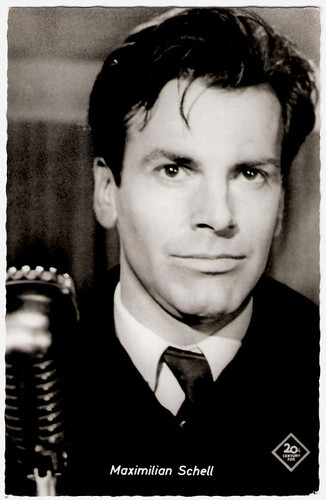
German postcard by Friedr. W. Sander-Verlag, Minden/Kolbri-Karte, no. 2005. Photo: 20th Century Fox. Publicity still for Judgment at Nuremberg (Stanley Kramer, 1961).
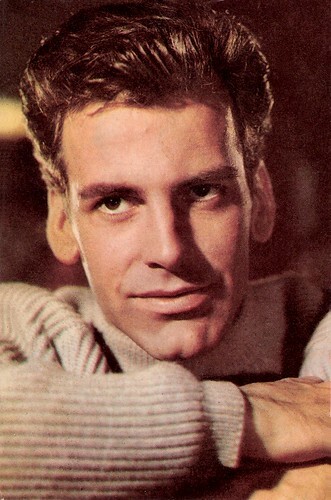
Belgian postcard by Cox, no. 7.
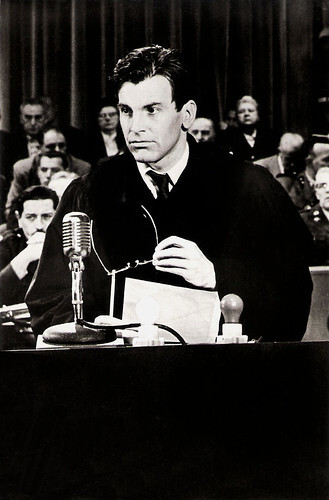
Spanish card by Ediciones Raker, Barcelona, no. 194. Photo: 20th Century Fox. Publicity still for Judgment at Nuremberg (Stanley Kramer, 1961).
An Accidental Hollywood Career
Maximilian Schell was born in Vienna, Austria in 1930. He was the son of Margarethe Schell née Noe von Nordberg, an actress who ran an acting school, and Hermann Ferdinand Schell, a Swiss poet, novelist, playwright, and owner of a pharmacy. Schell's late elder sister, Maria Schell , was also an actress; as were their two other siblings, Carl and Immy (Immaculata) Schell.
When Austria became part of Nazi-Germany after the ‘anschluss’ of 1938, the Schell family moved to Zurich, Switzerland. Maximilian's interest in acting began at early age. When 11, he appeared in a professional production of 'William Tell' and in the same year he wrote a play which was produced by his school. Later he served in the Swiss Army, achieving the rank of corporal.
In 1952, he began acting at the Basel Theatre. He played a small role as a desperate deserter in the war film Kinder, Mütter und ein General/Children, Mother, and the General (László Benedek, 1955) starring Hilde Krahl . That year he also played parts in Der 20. Juli/The Plot to Assassinate Hitler (Falk Harnack, 1955), Reifende Jugend/Ripening Youth (Ulrich Erfurth, 1955) and Ein Mädchen aus Flandern/The Girl from Flanders (Helmut Käutner, 1956) with Nicole Berger .
His breakthrough in the cinema was the German crime film Die Letzten werden die Ersten sein/The Last Ones Shall Be First (Rolf Hansen, 1957). The film, which starred O.E. Hasse and Ulla Jacobsson , was entered into the 7th Berlin International Film Festival.
Schell made his Hollywood debut as a Nazi officer in the World War II film The Young Lions (Edward Dmytryk, 1958) starring Marlon Brando and Montgomery Clift. According to Jon C. Hopwood at IMDb “quite by accident, as the producers had wanted to hire his sister Maria Schell , but lines of communication got crossed, and he was the one hired.”
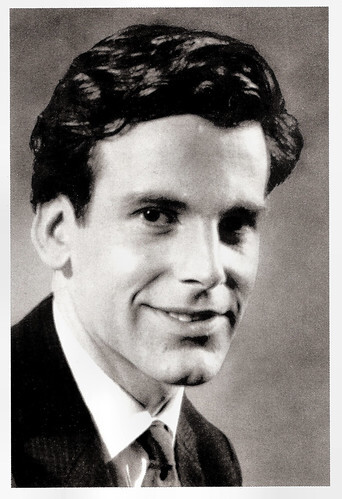
West-German collectors card in the Unsere Filmlieblinge series by Kauvit, München (Munich). Photo: Real-Film / Europa.
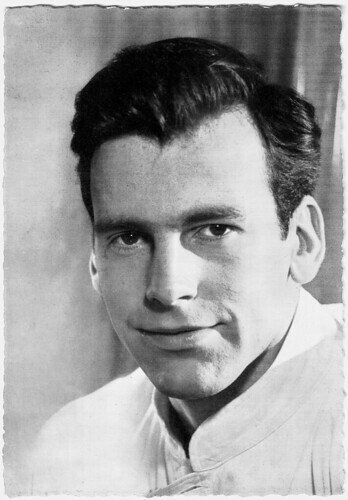
German postcard by WS-Druck, Wanne-Eickel, no. 241. Photo: Real-Film.
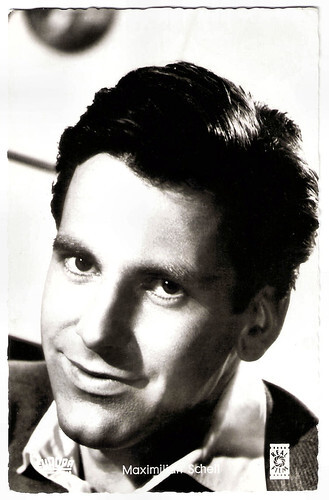
German postcard by Kolibri-Verlag, Minden/Westf.no. 2275. Photo: Real / Europa / Gabriele. Publicity still for Ein Herz kehrt heim/A Heart returns home (Eugen York, 1956).
Oscar
Maximilian Schell stayed in America and in 1959, he appeared as Hans Rolfe, an enigmatic defense attorney, in a live Playhouse 90 television production of Judgment at Nuremberg (George Roy Hill, 1959). In 1961, Schell reprised the role for the big screen remake Judgement at Nuremberg (Stanley Kramer, 1961) with an all star cast including Spencer Tracy, Burt Lancaster , and Marlene Dietrich .
As the first German speaking actor after World War II, Schell won the Academy Award for Best Actor. He also won a Golden Globe and the New York Film Critics Circle Award for the role.
In the following years, he starred in international productions like the Italian-French drama I sequestrati di Altona/The Condemned of Altona (Vittorio De Sica, 1962) opposite Sophia Loren , the heist film Topkapi (Jules Dassin, 1964) with Melina Mercouri , the British drama Return from the Ashes (J. Lee Thompson, 1965) with Ingrid Thulin, and the British espionage–thriller The Deadly Affair (Sidney Lumet, 1966) based on John le Carré's first novel Call for the Dead.
In Hollywood, he was often top billed in Third Reich themed films, such as Counterpoint (Ralph Nelson, 1968), The Man in the Glass Booth (Arthur Hiller, 1975) – a role for which he was nominated for an Academy Award, Cross of Iron (Sam Peckinpah, 1977), Julia (Fred Zinnemann, 1977) – for which he got another Oscar nomination, and A Bridge Too Far (Richard Attenborough, 1977).
However, he also played in various films with different subjects, including the historical disaster film Krakatoa, East of Java (Bernard L. Kowalski, 1969), the Science Fiction film The Black Hole (Gary Nelson, 1979), and the crime comedy The Freshman (Andrew Bergman, 1990) starring Marlon Brando and Matthew Broderick.
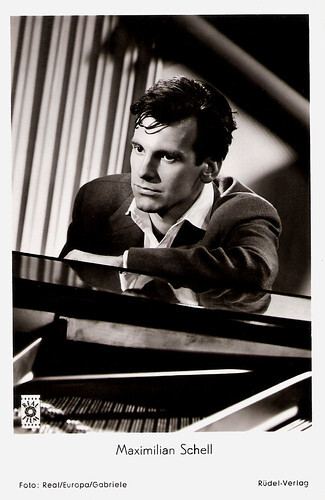
German postcard by Rüdel-Verlag, Hamburg-Bergedorf., no. 1868. Photo: Gabriele / Real / Europa. Publicity still for Ein Herz kehrt heim/A Heart Goes Home (Eugen York, 1956).
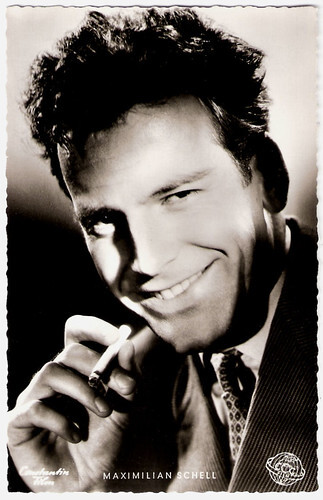
German postcard by Kunst und Bild, Berlin-Charlottenburg, no. V 128. Photo: CCC / Constantin / Arthur Grimm. Publicity still for Die Letzten werden die Ersten sein/The Last Ones Shall Be First (Rolf Hansen, 1957).
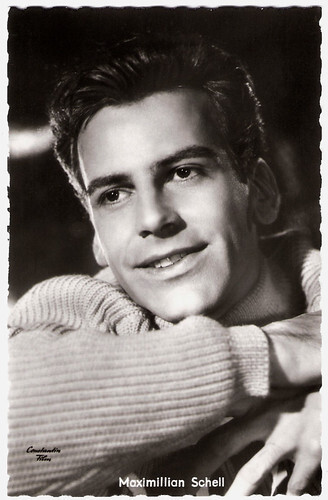
German postcard by Kolibri-Verlag G.m.b.H, Minden-Westf., no. 2445. Photo: Arthur Grimm / CCC / Constantin. Publicity still for Die Letzten werden die Ersten sein/The Last Ones Shall Be First (Rolf Hansen, 1957).
Marlene and Maria
Maximilian Schell has also served as a writer, producer and director for a variety of films. In 1968, Schell produced and starred in the adaptation of Kafka's novel Das Schloss/The Castle. Two years later, Erste Liebe/First Love (1970) - written, directed, produced, and starred in by Schell - was hailed by the critics. His Der Fußgänger/The Pedestrian (1974), in which he also starred, was nominated for the Oscar for Best Foreign Language Film and won a Golden Globe. His documentary on Marlene Dietrich , Marlene (1984) was based on the audio tape recordings of his 17-hours-long interview session with Dietrich. Using original footage, documentary material and interview passages, he managed to present an intimate portrait of her, which won also several awards.
18 years later, he made a documentary about his late sister Maria Schell , Meine Schwester Maria/My Sister Maria (2002). Connor McMadden at AllMovie : "Using excerpts of her feature films along with home movie footage, Schell explores the high points his sister's career throughout the 1950s, as well as the personal problems that cast her into obscurity only a decade later. The film offers quite a few emotional peaks, especially when an elderly Maria Schell goes before her brother's camera to speak candidly about her life, and a suicide attempt which she refers to as her 'first death.'"
In addition to his film career, Maximilian Schell has also been active as director, writer and actor in the European theatre. In 1958, he made his Broadway debut in Ira Levin’s 'Interlock'. In 1965, he starred in John Osborne’s groundbreaking 'A Patriot for Me', first at London’s Royal Court Theatre and later on Broadway. He has twice played 'Hamlet' on stage, originally under the direction of the legendary Gustaf Gründgens and later under his own direction. In 1972 he starred in Peter Hall's German language première of Harold Pinter's 'Old Times' at the Burgtheater in Vienna. In 1977 he directed 'Tales from the Vienna Woods' at the National Theatre in London.
In later life he also began directing operatic productions, starting with Giuseppe Verdi's La Traviata. This passion was triggered when he was performing in the play 'Jedermann' (Everyman) in Salzburg, Austria from 1978-1982, and he came into contact with several musical conductors including Leonard Bernstein, James Levine and Claudio Abbado. In 2006 he appeared in Arthur Miller's 'Resurrection Blues' directed by Robert Altman at the Old Vic in London.
He also often appeared on television, such as in the miniseries Peter the Great (Marvin J. Chomsky, Lawrence Schiller, 1986), with Vanessa Redgrave and Laurence Olivier . He was twice been nominated for an Emmy for his TV work, and in 1993, he won a Golden Globe for his part as Vladimir Lenin in the HBO miniseries Stalin (Ivan Passer, 1992). In 1990, he had refused to receive the Honorary German Film Award because he felt too young to be awarded with an award for lifetime achievement. For German television, he played in the television miniseries The Return of the Dancing Master (Urs Egger, 2004), which was based on Henning Mankell's crime novel.
Through the decades he continued to star in international film productions, such as The Rose Garden (Fons Rademakers, 1986), Left Luggage (Jeroen Krabbé, 1998), Deep Impact (Mimi Leder, 1998), Vampires (John Carpenter, 1998), and the American comedy The Brothers Bloom (Rian Johnson, 2008) with Adrien Brody and Mark Ruffalo. At IMDb , Jon C. Hopwood writes: “with the exception of Maurice Chevalier and Marcello Mastroianni , Schell is undoubtedly the most successful non-Anglophone foreign actor in the history of American cinema.”
Maximilian Schell was married to actress Natalya Andreychenko (1985-2005). Their daughter is actress Nastassja Schell (born in 1989). He was also the godfather of actress Angelina Jolie . Atb the end of his life, Maximilian Schell could be seen in two films, Les brigands (Pol Cruchten, Frank Hoffmann, 2013) opposite Tchéky Karyo, and An Artist's Emblem (Michael J. Narvaez, 2013) with Harry Dean Stanton.
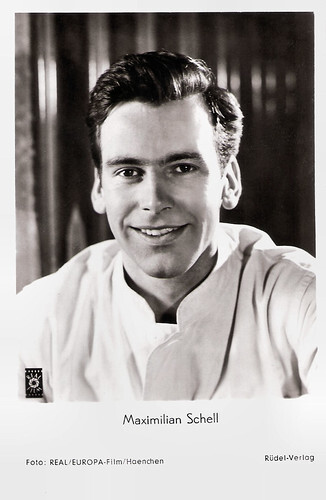
West-German postcard by Rüdel-Verlag. Photo: Real-Film / Europa-Film / Haenchen. Maximilian Schell in Die Ehe der Dr. med. Donwitz/Marriage of Dr. Danwitz (Arthur Maria Rabenalt, 1956).
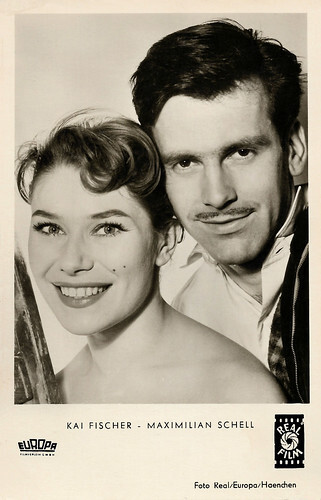
West-German postcard by Kunst und Bild, Berlin, no. I 471. Photo: Real / Europa / Haenchen. Kai Fischer and Maximilian Schell in Die Ehe des Dr. med. Danwitz/Marriage of Dr. Danwitz (Arthur Maria Rabenalt, 1956).
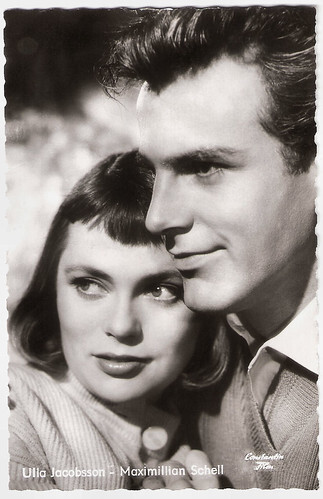
West-German postcard by Kolibri-Verlag G.m.b.H, Minden/Westf, no. I 471. Photo: Grimm / CCC / Constantin Film. Ulla Jacobsson and Maximilian Schell in Die Letzten werden die Ersten sein/The Last Ones Shall Be First (Rolf Hansen, 1957).
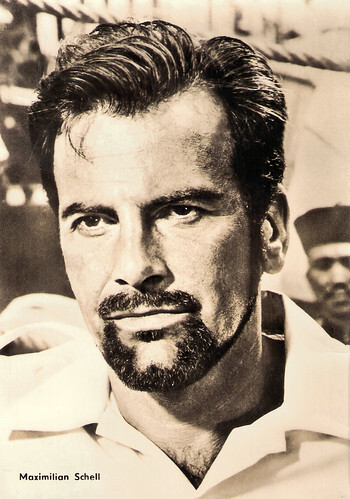
East-German postcard by VEB Progress Film-Vertrieb, Berlin, no. 26/70. Maximilian Schell in Krakatoa: East of Java (Bernard L. Kowalski, 1968).
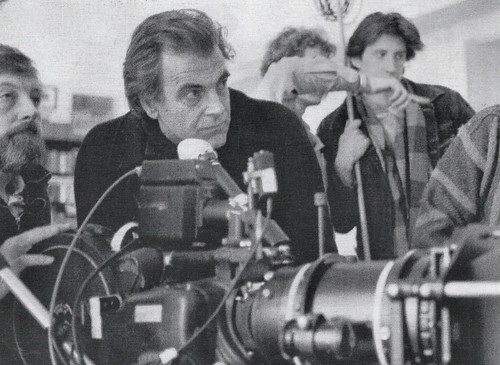
West-German postcard by Kunst und Ausstellungshalledes Bundesrepublik Deutschland, Bonn. Photo: Stiftung Deutsche Kinemathek, Berlin. Maximilian Schell at the set of Marlene (Maximilian Schell, 1983).
Sources: Sandra Brennan (AllMovie), (IMDb), Connor McMadden (AllMovie), Filmportal.de, Wikipedia, and .

German postcard by Friedr. W. Sander-Verlag, Minden/Kolbri-Karte, no. 2005. Photo: 20th Century Fox. Publicity still for Judgment at Nuremberg (Stanley Kramer, 1961).

Belgian postcard by Cox, no. 7.

Spanish card by Ediciones Raker, Barcelona, no. 194. Photo: 20th Century Fox. Publicity still for Judgment at Nuremberg (Stanley Kramer, 1961).
An Accidental Hollywood Career
Maximilian Schell was born in Vienna, Austria in 1930. He was the son of Margarethe Schell née Noe von Nordberg, an actress who ran an acting school, and Hermann Ferdinand Schell, a Swiss poet, novelist, playwright, and owner of a pharmacy. Schell's late elder sister, Maria Schell , was also an actress; as were their two other siblings, Carl and Immy (Immaculata) Schell.
When Austria became part of Nazi-Germany after the ‘anschluss’ of 1938, the Schell family moved to Zurich, Switzerland. Maximilian's interest in acting began at early age. When 11, he appeared in a professional production of 'William Tell' and in the same year he wrote a play which was produced by his school. Later he served in the Swiss Army, achieving the rank of corporal.
In 1952, he began acting at the Basel Theatre. He played a small role as a desperate deserter in the war film Kinder, Mütter und ein General/Children, Mother, and the General (László Benedek, 1955) starring Hilde Krahl . That year he also played parts in Der 20. Juli/The Plot to Assassinate Hitler (Falk Harnack, 1955), Reifende Jugend/Ripening Youth (Ulrich Erfurth, 1955) and Ein Mädchen aus Flandern/The Girl from Flanders (Helmut Käutner, 1956) with Nicole Berger .
His breakthrough in the cinema was the German crime film Die Letzten werden die Ersten sein/The Last Ones Shall Be First (Rolf Hansen, 1957). The film, which starred O.E. Hasse and Ulla Jacobsson , was entered into the 7th Berlin International Film Festival.
Schell made his Hollywood debut as a Nazi officer in the World War II film The Young Lions (Edward Dmytryk, 1958) starring Marlon Brando and Montgomery Clift. According to Jon C. Hopwood at IMDb “quite by accident, as the producers had wanted to hire his sister Maria Schell , but lines of communication got crossed, and he was the one hired.”

West-German collectors card in the Unsere Filmlieblinge series by Kauvit, München (Munich). Photo: Real-Film / Europa.

German postcard by WS-Druck, Wanne-Eickel, no. 241. Photo: Real-Film.

German postcard by Kolibri-Verlag, Minden/Westf.no. 2275. Photo: Real / Europa / Gabriele. Publicity still for Ein Herz kehrt heim/A Heart returns home (Eugen York, 1956).
Oscar
Maximilian Schell stayed in America and in 1959, he appeared as Hans Rolfe, an enigmatic defense attorney, in a live Playhouse 90 television production of Judgment at Nuremberg (George Roy Hill, 1959). In 1961, Schell reprised the role for the big screen remake Judgement at Nuremberg (Stanley Kramer, 1961) with an all star cast including Spencer Tracy, Burt Lancaster , and Marlene Dietrich .
As the first German speaking actor after World War II, Schell won the Academy Award for Best Actor. He also won a Golden Globe and the New York Film Critics Circle Award for the role.
In the following years, he starred in international productions like the Italian-French drama I sequestrati di Altona/The Condemned of Altona (Vittorio De Sica, 1962) opposite Sophia Loren , the heist film Topkapi (Jules Dassin, 1964) with Melina Mercouri , the British drama Return from the Ashes (J. Lee Thompson, 1965) with Ingrid Thulin, and the British espionage–thriller The Deadly Affair (Sidney Lumet, 1966) based on John le Carré's first novel Call for the Dead.
In Hollywood, he was often top billed in Third Reich themed films, such as Counterpoint (Ralph Nelson, 1968), The Man in the Glass Booth (Arthur Hiller, 1975) – a role for which he was nominated for an Academy Award, Cross of Iron (Sam Peckinpah, 1977), Julia (Fred Zinnemann, 1977) – for which he got another Oscar nomination, and A Bridge Too Far (Richard Attenborough, 1977).
However, he also played in various films with different subjects, including the historical disaster film Krakatoa, East of Java (Bernard L. Kowalski, 1969), the Science Fiction film The Black Hole (Gary Nelson, 1979), and the crime comedy The Freshman (Andrew Bergman, 1990) starring Marlon Brando and Matthew Broderick.

German postcard by Rüdel-Verlag, Hamburg-Bergedorf., no. 1868. Photo: Gabriele / Real / Europa. Publicity still for Ein Herz kehrt heim/A Heart Goes Home (Eugen York, 1956).

German postcard by Kunst und Bild, Berlin-Charlottenburg, no. V 128. Photo: CCC / Constantin / Arthur Grimm. Publicity still for Die Letzten werden die Ersten sein/The Last Ones Shall Be First (Rolf Hansen, 1957).

German postcard by Kolibri-Verlag G.m.b.H, Minden-Westf., no. 2445. Photo: Arthur Grimm / CCC / Constantin. Publicity still for Die Letzten werden die Ersten sein/The Last Ones Shall Be First (Rolf Hansen, 1957).
Marlene and Maria
Maximilian Schell has also served as a writer, producer and director for a variety of films. In 1968, Schell produced and starred in the adaptation of Kafka's novel Das Schloss/The Castle. Two years later, Erste Liebe/First Love (1970) - written, directed, produced, and starred in by Schell - was hailed by the critics. His Der Fußgänger/The Pedestrian (1974), in which he also starred, was nominated for the Oscar for Best Foreign Language Film and won a Golden Globe. His documentary on Marlene Dietrich , Marlene (1984) was based on the audio tape recordings of his 17-hours-long interview session with Dietrich. Using original footage, documentary material and interview passages, he managed to present an intimate portrait of her, which won also several awards.
18 years later, he made a documentary about his late sister Maria Schell , Meine Schwester Maria/My Sister Maria (2002). Connor McMadden at AllMovie : "Using excerpts of her feature films along with home movie footage, Schell explores the high points his sister's career throughout the 1950s, as well as the personal problems that cast her into obscurity only a decade later. The film offers quite a few emotional peaks, especially when an elderly Maria Schell goes before her brother's camera to speak candidly about her life, and a suicide attempt which she refers to as her 'first death.'"
In addition to his film career, Maximilian Schell has also been active as director, writer and actor in the European theatre. In 1958, he made his Broadway debut in Ira Levin’s 'Interlock'. In 1965, he starred in John Osborne’s groundbreaking 'A Patriot for Me', first at London’s Royal Court Theatre and later on Broadway. He has twice played 'Hamlet' on stage, originally under the direction of the legendary Gustaf Gründgens and later under his own direction. In 1972 he starred in Peter Hall's German language première of Harold Pinter's 'Old Times' at the Burgtheater in Vienna. In 1977 he directed 'Tales from the Vienna Woods' at the National Theatre in London.
In later life he also began directing operatic productions, starting with Giuseppe Verdi's La Traviata. This passion was triggered when he was performing in the play 'Jedermann' (Everyman) in Salzburg, Austria from 1978-1982, and he came into contact with several musical conductors including Leonard Bernstein, James Levine and Claudio Abbado. In 2006 he appeared in Arthur Miller's 'Resurrection Blues' directed by Robert Altman at the Old Vic in London.
He also often appeared on television, such as in the miniseries Peter the Great (Marvin J. Chomsky, Lawrence Schiller, 1986), with Vanessa Redgrave and Laurence Olivier . He was twice been nominated for an Emmy for his TV work, and in 1993, he won a Golden Globe for his part as Vladimir Lenin in the HBO miniseries Stalin (Ivan Passer, 1992). In 1990, he had refused to receive the Honorary German Film Award because he felt too young to be awarded with an award for lifetime achievement. For German television, he played in the television miniseries The Return of the Dancing Master (Urs Egger, 2004), which was based on Henning Mankell's crime novel.
Through the decades he continued to star in international film productions, such as The Rose Garden (Fons Rademakers, 1986), Left Luggage (Jeroen Krabbé, 1998), Deep Impact (Mimi Leder, 1998), Vampires (John Carpenter, 1998), and the American comedy The Brothers Bloom (Rian Johnson, 2008) with Adrien Brody and Mark Ruffalo. At IMDb , Jon C. Hopwood writes: “with the exception of Maurice Chevalier and Marcello Mastroianni , Schell is undoubtedly the most successful non-Anglophone foreign actor in the history of American cinema.”
Maximilian Schell was married to actress Natalya Andreychenko (1985-2005). Their daughter is actress Nastassja Schell (born in 1989). He was also the godfather of actress Angelina Jolie . Atb the end of his life, Maximilian Schell could be seen in two films, Les brigands (Pol Cruchten, Frank Hoffmann, 2013) opposite Tchéky Karyo, and An Artist's Emblem (Michael J. Narvaez, 2013) with Harry Dean Stanton.

West-German postcard by Rüdel-Verlag. Photo: Real-Film / Europa-Film / Haenchen. Maximilian Schell in Die Ehe der Dr. med. Donwitz/Marriage of Dr. Danwitz (Arthur Maria Rabenalt, 1956).

West-German postcard by Kunst und Bild, Berlin, no. I 471. Photo: Real / Europa / Haenchen. Kai Fischer and Maximilian Schell in Die Ehe des Dr. med. Danwitz/Marriage of Dr. Danwitz (Arthur Maria Rabenalt, 1956).

West-German postcard by Kolibri-Verlag G.m.b.H, Minden/Westf, no. I 471. Photo: Grimm / CCC / Constantin Film. Ulla Jacobsson and Maximilian Schell in Die Letzten werden die Ersten sein/The Last Ones Shall Be First (Rolf Hansen, 1957).

East-German postcard by VEB Progress Film-Vertrieb, Berlin, no. 26/70. Maximilian Schell in Krakatoa: East of Java (Bernard L. Kowalski, 1968).

West-German postcard by Kunst und Ausstellungshalledes Bundesrepublik Deutschland, Bonn. Photo: Stiftung Deutsche Kinemathek, Berlin. Maximilian Schell at the set of Marlene (Maximilian Schell, 1983).
Sources: Sandra Brennan (AllMovie), (IMDb), Connor McMadden (AllMovie), Filmportal.de, Wikipedia, and .
Published on January 11, 2023 22:00
January 10, 2023
The Birdcage (1996)
The American comedy The Birdcage (Mike Nichols, 1996) is the American remake of the French-Italian film La Cage aux Folles/Birds of a Feather) (Édouard Molinaro, 1978) which was based on actor-playwright Jean Poiret's play 'La Cage Aux Folles' (1973). Director Mike Nichols teamed up with his former partner/screenwriter Elaine May for the first time in many years and for the first time together in films to create this sophisticated, remake of the phenomenally popular French musical farce. The film stars Robin Williams, Gene Hackman, Nathan Lane, and Dianne Wiest. Dan Futterman, Calista Flockhart - pre-Ally McBeal, Hank Azaria, and Christine Baranski appear in supporting roles.
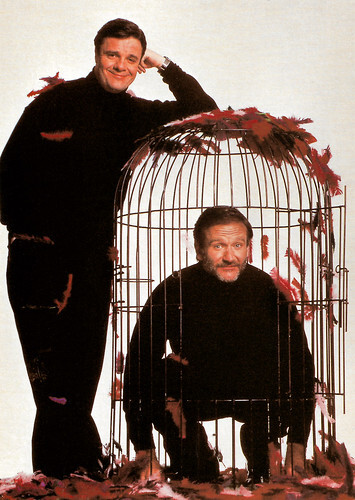
British postcard by Boomerang. Photo: UIP. Nathan Lane and Robin Williams in The Birdcage (Mike Nichols, 1996).
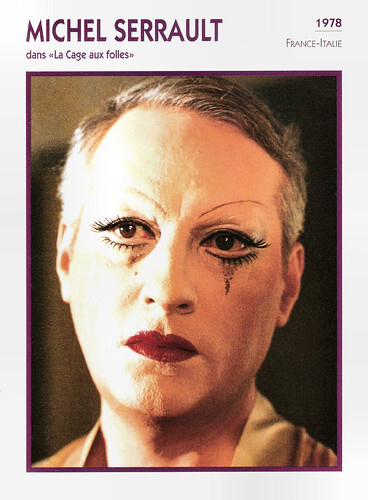
French collectors card in the series 'Portrait de Stars; L'encyclopédie du Cinéma' by Edito Service, 1994. Photo: the Kobal Collection. Michel Serrault as Zaza Napoli in La Cage aux Folles (Edouard Molinaro, 1978).
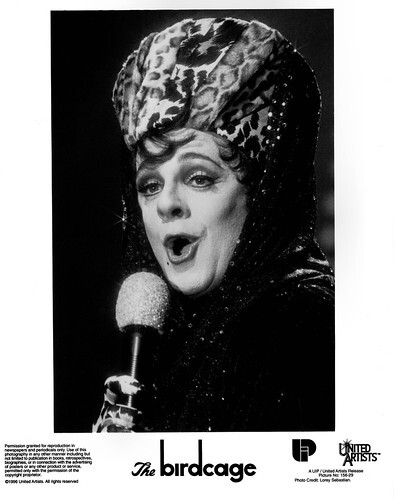
Vintage press photo by UIP / United Artists, no. 156/29. Photo: Lorey Sebastian. Nathan Lane as Starina in The Birdcage (Mike Nichols, 1996).
One of the highest-grossing foreign-language films
Jean Poiret's original play 'La Cage aux Folles', starring Poiret and Michel Serrault , ran for almost 1,800 performances, from 1973 to 1978, at the Théâtre du Palais-Royal in Paris.
The French-Italian film version, La Cage aux folles/Birds of a Feather (Édouard Molinaro, 1978) starring Ugo Tognazzi and Michel Serrault , was also a considerable commercial success.
It became one of the highest-grossing foreign-language films released in the United States of all time. It won the Golden Globe Award for Best Foreign Language Film and was nominated for three Oscars: Best Director (Molinaro), Best Adapted Screenplay, and Best Costume Design. Michel Serrault won the César Award for Best Actor. The film was followed by two sequels: La Cage aux Folles II/Birds of a Feather 2 (1980), also directed by Edouard Molinaro, and La Cage aux folles 3 - 'Elles' se marient/La Cage aux Folles 3: The Wedding (1985), directed by Georges Lautner.
The 1983 Broadway musical 'La Cage aux Folles' with music and lyrics by Jerry Herman and a book by Harvey Fierstein based on the play and the film, was also successful. It was directed by Arthur Laurents and the cast included Gene Barry as Georges and George Hearn as Albin. Opening on Broadway in 1983 'La Cage' broke barriers for gay representation by becoming the first hit Broadway musical centered on a homosexual relationship. The original production ran for more than four years (1,761 performances), and won six Tony Awards, including Best Musical, Best Score and Best Book.
In 1996, an American film remake titled The Birdcage was released and relocated to South Beach. It was the first time Mike Nichols and Elaine May, who helped define improvisational comedy in the 1950s, worked together on a film. The stars were Robin Williams and Nathan Lane.
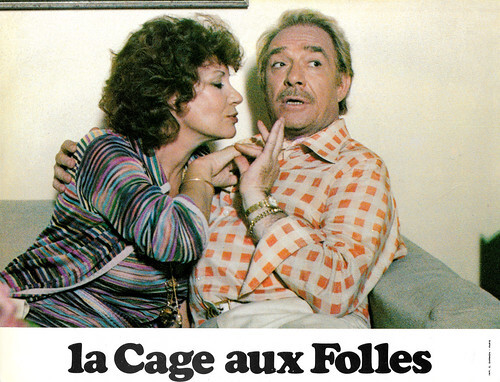
French lobby card by C. Darmon, Paris. Ugo Tognazzi and Claire Maurier in La Cage aux Folles/Birds of a Feather (Edouard Molinaro, 1978).
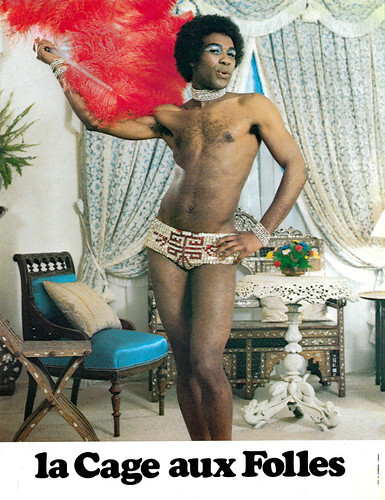
French lobby card by C. Darmon, Paris. Benny Luke as Jakob 'the maid' in La Cage aux Folles/Birds of a Feather (Edouard Molinaro, 1978).
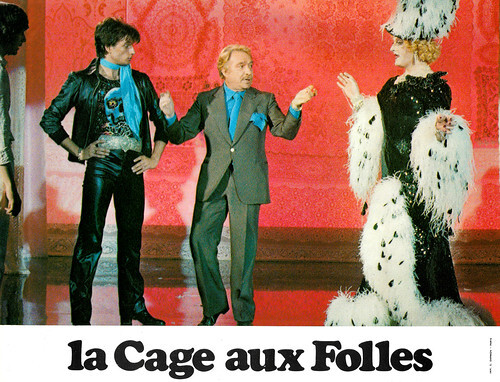
French lobby card by C. Darmon, Paris. Ugo Tognazzi and Michel Serrault in La Cage aux Folles/Birds of a Feather (Edouard Molinaro, 1978).
Comic chaos
Val (Dan Futterman) and Barbara (Calista Flockhart) are engaged to be married. For a long time, they have wanted to avoid their parents' meeting but now it really has to happen. However, this does not seem very simple.
Val's father, Armand Goldman (Robin Williams) owns a gay nightclub called The Birdcage in South Miami Beach. He lives upstairs in his nightclub with Albert (Nathan Lane), who has been his lover for some 20 years and is as Starina the star of the show. Albert is a basket case, threatened by encroaching age and insecurity. He functions only because Agador (Hank Azaria), the flamboyant houseboy, tranquillizes him with Pirin tablets. ("They're just aspirin with the `as' scraped off," Agador confides to Armand.)
Barbara's father (Gene Hackman) is an ultra-conservative senator from the Republican Party and co-founder of the Committee for Moral Order. The Senator and family descend upon South Beach to meet Val, his father, but not "Auntie Albert." Albert is devastated that the boy he raised like his own son is turning his back on him. Armand is upset, too, but goes along with a masquerade in which Val's mother (Christine Baranski), who had Val after a one-night stand with Armand, will pretend to be Mrs. Goldman. What ensues is comic chaos.
Three songs written by Stephen Sondheim were adapted and arranged for the film by composer Jonathan Tunick. Albert's first song (as Starina) is 'Can That Boy Foxtrot,' cut from Sondheim's 'Follies'. 'Little Dream' was written specifically for the film, and ultimately used during Albert's rehearsal with the gum-chewing dancer. While Armand and Katharine dance in her office, they sing 'Love Is in the Air', cut from 'A Funny Thing Happened on the Way to the Forum'.
In addition to the Sondheim songs, Jonathan Tunick utilised dance-style music such as Donna Summer's 'She Works Hard for the Money' and Sister Sledge's 'We Are Family', along with Gloria Estefan & Miami Sound Machine's 'Conga'.
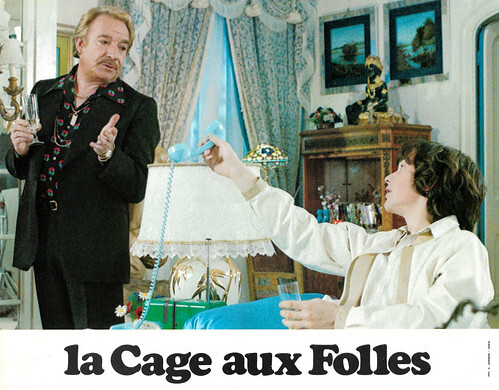
French lobby card by C. Darmon, Paris. Ugo Tognazzi and Rémi Laurent in La Cage aux Folles/Birds of a Feather (Edouard Molinaro, 1978).
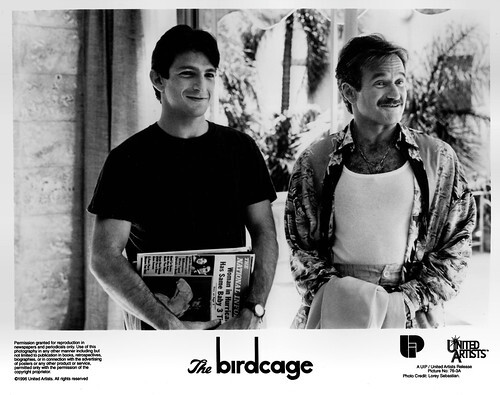
Vintage press photo by UIP / United Artists, no. 76/3A. Photo: Lorey Sebastian. Dan Futterman and Robin Williams in The Birdcage (Mike Nichols, 1996).
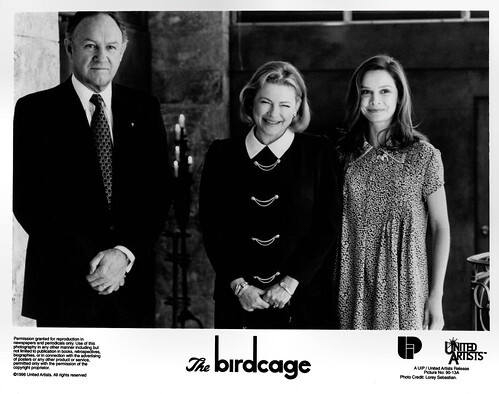
Vintage press photo by UIP / United Artists, no. 90/13A. Photo: Lorey Sebastian. Gene Hackman, Dianne Wiest and Calista Flockhart in The Birdcage (Mike Nichols, 1996).
The twisted logic of screwball comedy
The Birdcage (Mike Nichols, 1998) received positive reviews upon its release. Roger Ebert in the Chicago Sun-Times: "The Birdcage isn't about plot, anyway. It's about character, and about the twisted logic of screwball comedy, in which everybody acts the craziest just when they're trying to make the most sense. What makes Mike Nichols' version more than just a retread is good casting in the key roles, and a wicked screenplay by Elaine May, who keeps the original story but adds little zingers here and there ('Live on Fisher Island and get buried in Palm Beach - that way you'll get the best of Florida!')."
Derek Armstrong at AllMovie: "Mike Nichols' The Birdcage is a funny, slapstick, but ultimately slight farce, notable as a forerunner in the movement to make gay characters mainstream and profitable at the box office. It succeeded big time, winning a broad audience and raking in close to $125 million.
It's rare that another actor gets to upstage Robin Williams, but Nathan Lane does so wonderfully, playing an ungracefully ageing drag queen who performs at the Miami nightclub owned by Williams, his subdued life partner."
The Birdcage was nominated for, among others, an Academy Award for art direction (Bo Welch,Cheryl Caraski) and Golden Globes for best comedy and best comedy actor (Nathan Lane). In addition, the film actually won American Comedy Awards for the funniest lead actor (Lane) and most humorous supporting actress (Dianne Wiest) and a Screen Actors Guild Award for all actors' acting.
The Birdcage grossed $18,275,828 in its opening weekend, topping the box office. It remained at No. 1 for the next three weeks. By the end of its 14-week run, the film had grossed $124,060,553 domestically and $61,200,000 internationally, eventually reaching a total of US$185,260,553 worldwide.
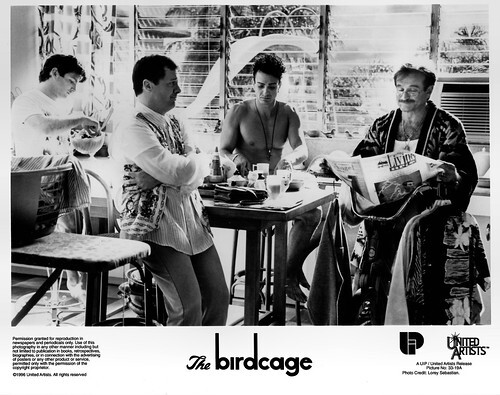
Vintage press photo by UIP / United Artists, no. 33/19A. Photo: Lorey Sebastian. Dan Futterman, Nathan Lane, Hank Azaria and Robin Williams in The Birdcage (Mike Nichols, 1996).
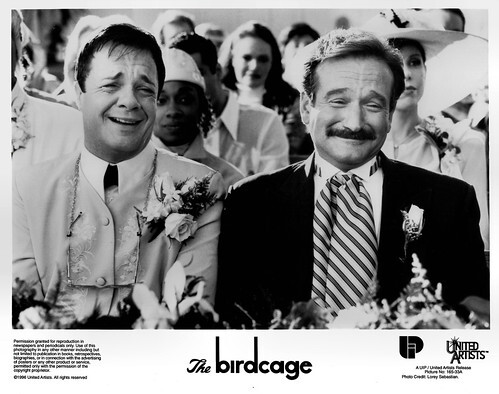
Vintage press photo by UIP / United Artists, no. 165/33A. Photo: Lorey Sebastian. Nathan Lane and Robin Williams in The Birdcage (Mike Nichols, 1996).
Source: Roger Ebert (Roger Ebert.com), Derek Armstrong (AllMovie), Sandra Brennan (AllMovie), Wikipedia (Dutch and English) and IMDb.

British postcard by Boomerang. Photo: UIP. Nathan Lane and Robin Williams in The Birdcage (Mike Nichols, 1996).

French collectors card in the series 'Portrait de Stars; L'encyclopédie du Cinéma' by Edito Service, 1994. Photo: the Kobal Collection. Michel Serrault as Zaza Napoli in La Cage aux Folles (Edouard Molinaro, 1978).

Vintage press photo by UIP / United Artists, no. 156/29. Photo: Lorey Sebastian. Nathan Lane as Starina in The Birdcage (Mike Nichols, 1996).
One of the highest-grossing foreign-language films
Jean Poiret's original play 'La Cage aux Folles', starring Poiret and Michel Serrault , ran for almost 1,800 performances, from 1973 to 1978, at the Théâtre du Palais-Royal in Paris.
The French-Italian film version, La Cage aux folles/Birds of a Feather (Édouard Molinaro, 1978) starring Ugo Tognazzi and Michel Serrault , was also a considerable commercial success.
It became one of the highest-grossing foreign-language films released in the United States of all time. It won the Golden Globe Award for Best Foreign Language Film and was nominated for three Oscars: Best Director (Molinaro), Best Adapted Screenplay, and Best Costume Design. Michel Serrault won the César Award for Best Actor. The film was followed by two sequels: La Cage aux Folles II/Birds of a Feather 2 (1980), also directed by Edouard Molinaro, and La Cage aux folles 3 - 'Elles' se marient/La Cage aux Folles 3: The Wedding (1985), directed by Georges Lautner.
The 1983 Broadway musical 'La Cage aux Folles' with music and lyrics by Jerry Herman and a book by Harvey Fierstein based on the play and the film, was also successful. It was directed by Arthur Laurents and the cast included Gene Barry as Georges and George Hearn as Albin. Opening on Broadway in 1983 'La Cage' broke barriers for gay representation by becoming the first hit Broadway musical centered on a homosexual relationship. The original production ran for more than four years (1,761 performances), and won six Tony Awards, including Best Musical, Best Score and Best Book.
In 1996, an American film remake titled The Birdcage was released and relocated to South Beach. It was the first time Mike Nichols and Elaine May, who helped define improvisational comedy in the 1950s, worked together on a film. The stars were Robin Williams and Nathan Lane.

French lobby card by C. Darmon, Paris. Ugo Tognazzi and Claire Maurier in La Cage aux Folles/Birds of a Feather (Edouard Molinaro, 1978).

French lobby card by C. Darmon, Paris. Benny Luke as Jakob 'the maid' in La Cage aux Folles/Birds of a Feather (Edouard Molinaro, 1978).

French lobby card by C. Darmon, Paris. Ugo Tognazzi and Michel Serrault in La Cage aux Folles/Birds of a Feather (Edouard Molinaro, 1978).
Comic chaos
Val (Dan Futterman) and Barbara (Calista Flockhart) are engaged to be married. For a long time, they have wanted to avoid their parents' meeting but now it really has to happen. However, this does not seem very simple.
Val's father, Armand Goldman (Robin Williams) owns a gay nightclub called The Birdcage in South Miami Beach. He lives upstairs in his nightclub with Albert (Nathan Lane), who has been his lover for some 20 years and is as Starina the star of the show. Albert is a basket case, threatened by encroaching age and insecurity. He functions only because Agador (Hank Azaria), the flamboyant houseboy, tranquillizes him with Pirin tablets. ("They're just aspirin with the `as' scraped off," Agador confides to Armand.)
Barbara's father (Gene Hackman) is an ultra-conservative senator from the Republican Party and co-founder of the Committee for Moral Order. The Senator and family descend upon South Beach to meet Val, his father, but not "Auntie Albert." Albert is devastated that the boy he raised like his own son is turning his back on him. Armand is upset, too, but goes along with a masquerade in which Val's mother (Christine Baranski), who had Val after a one-night stand with Armand, will pretend to be Mrs. Goldman. What ensues is comic chaos.
Three songs written by Stephen Sondheim were adapted and arranged for the film by composer Jonathan Tunick. Albert's first song (as Starina) is 'Can That Boy Foxtrot,' cut from Sondheim's 'Follies'. 'Little Dream' was written specifically for the film, and ultimately used during Albert's rehearsal with the gum-chewing dancer. While Armand and Katharine dance in her office, they sing 'Love Is in the Air', cut from 'A Funny Thing Happened on the Way to the Forum'.
In addition to the Sondheim songs, Jonathan Tunick utilised dance-style music such as Donna Summer's 'She Works Hard for the Money' and Sister Sledge's 'We Are Family', along with Gloria Estefan & Miami Sound Machine's 'Conga'.

French lobby card by C. Darmon, Paris. Ugo Tognazzi and Rémi Laurent in La Cage aux Folles/Birds of a Feather (Edouard Molinaro, 1978).

Vintage press photo by UIP / United Artists, no. 76/3A. Photo: Lorey Sebastian. Dan Futterman and Robin Williams in The Birdcage (Mike Nichols, 1996).

Vintage press photo by UIP / United Artists, no. 90/13A. Photo: Lorey Sebastian. Gene Hackman, Dianne Wiest and Calista Flockhart in The Birdcage (Mike Nichols, 1996).
The twisted logic of screwball comedy
The Birdcage (Mike Nichols, 1998) received positive reviews upon its release. Roger Ebert in the Chicago Sun-Times: "The Birdcage isn't about plot, anyway. It's about character, and about the twisted logic of screwball comedy, in which everybody acts the craziest just when they're trying to make the most sense. What makes Mike Nichols' version more than just a retread is good casting in the key roles, and a wicked screenplay by Elaine May, who keeps the original story but adds little zingers here and there ('Live on Fisher Island and get buried in Palm Beach - that way you'll get the best of Florida!')."
Derek Armstrong at AllMovie: "Mike Nichols' The Birdcage is a funny, slapstick, but ultimately slight farce, notable as a forerunner in the movement to make gay characters mainstream and profitable at the box office. It succeeded big time, winning a broad audience and raking in close to $125 million.
It's rare that another actor gets to upstage Robin Williams, but Nathan Lane does so wonderfully, playing an ungracefully ageing drag queen who performs at the Miami nightclub owned by Williams, his subdued life partner."
The Birdcage was nominated for, among others, an Academy Award for art direction (Bo Welch,Cheryl Caraski) and Golden Globes for best comedy and best comedy actor (Nathan Lane). In addition, the film actually won American Comedy Awards for the funniest lead actor (Lane) and most humorous supporting actress (Dianne Wiest) and a Screen Actors Guild Award for all actors' acting.
The Birdcage grossed $18,275,828 in its opening weekend, topping the box office. It remained at No. 1 for the next three weeks. By the end of its 14-week run, the film had grossed $124,060,553 domestically and $61,200,000 internationally, eventually reaching a total of US$185,260,553 worldwide.

Vintage press photo by UIP / United Artists, no. 33/19A. Photo: Lorey Sebastian. Dan Futterman, Nathan Lane, Hank Azaria and Robin Williams in The Birdcage (Mike Nichols, 1996).

Vintage press photo by UIP / United Artists, no. 165/33A. Photo: Lorey Sebastian. Nathan Lane and Robin Williams in The Birdcage (Mike Nichols, 1996).
Source: Roger Ebert (Roger Ebert.com), Derek Armstrong (AllMovie), Sandra Brennan (AllMovie), Wikipedia (Dutch and English) and IMDb.
Published on January 10, 2023 22:00
January 9, 2023
Jakob Tiedtke
German actor Jakob Tiedtke (1875-1960) transformed from a beloved character actor to a comedy star on stage. From 1906 on, he appeared in many silent films and played in many films by Ernst Lubitsch. In the 1930s, 1940s and 1950s, Jakob Tiedtke remained a well-known and popular actor on the screen. He played in more than 190 films between 1914 and 1955.
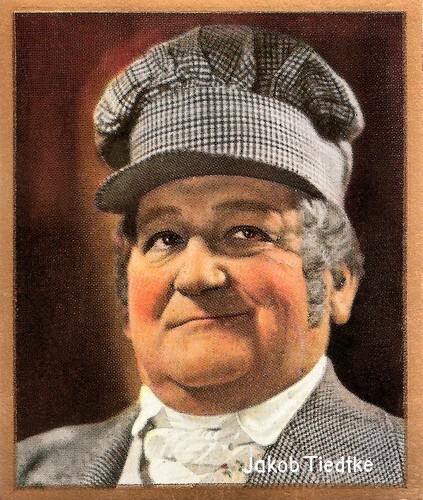
German cigarette card in the series Unsere Bunten Filmbilder by Ross Verlag for Cigarettenfabrik Josetti, Berlin, no. 179. Photo: Ufa.
The corps bird of Max Reinhardt
Jakob Karl Heinrich Wilhelm Tiedtke was born in 1875 in Rixdorf near Berlin, today the district of Berlin-Neukölln. His father was a humorous writer and contributor to the richly illustrated German weekly Fliegende Blätter, Kladderadatsch, and the like. After attending the Köllnisches Gymnasium in his native city, Tiedtke graduated from the Seebach-Schule, which was affiliated with the Berlin Königliches Schauspielhaus.
After completing his studies, the young actor made his debut there in 1899 as Cato in the Shakespeare tragedy 'Julius Caesar' and shortly afterwards went to the Preußisches Hoftheater, where he was a member of the ensemble until 1905. Then he followed a call from Max Reinhardt to the Deutsches Theater for eight years, where he distinguished himself as a hard-working character actor. At Max Reinhardt 's Deutsches Theater Tiedtke became known as the "corpse bird" when he was not playing himself, he sat in the stalls so that he could step in immediately if an actor dropped out.
He had all the possible roles in his head. Thus he became Reinhardt's busiest character actor, portraying mostly old men in over 100 productions, such as the medical councillor Dr. von Brausepulver in the world premiere of Frank Wedekind's children's tragedy 'Frühlings Erwachen' (Spring Awakening, 1906). The transition to comedian came with increasing corpulence. Tiedtke recounts how he was once asked to stand in for an actor who had fallen ill and play old Moor, who is locked in the hunger tower by his own son.
In 1913 Jakob Tiedtke moved to the private Deutsche Künstlertheater Societät and a year later to the Lessingtheater under the direction of Victor Barnowsky. This was followed in 1915 by a three-year engagement at the famous Vienna Burgtheater. Until 1925 Tiedtke made guest appearances at various Berlin theatres and belonged to the ensemble of the Berlin Volksbühne from 1933 to 1945. During the National Socialist era, he was a presidential advisor to the NS leader corps Kameradschaft der deutschen Künstler.
After the end of World War II, Tiedtke founded the Künstlergemeinschaft Bad Ischl together with Theo Lingen , Paul Kemp , Siegfried Breuer and other fellow actors, which toured Austria for two years. Afterwards, the actor was able to perform successfully again in Munich and Berlin, and he also shone in Hamburg, among other places, at the Thalia Theater at the beginning of November 1949, where, on the occasion of his 50th stage anniversary, the comedy 'Der gute Onkel Jan' by Georges Feydeau with Tiedtke in the title role was performed in German for the first time. In addition to important theatre characters such as Iago in Shakespeare's 'Othello', Mephisto in Goethe's 'Faust', or Franz Moor in Schiller's 'Die Räuber', his brilliant roles on stage included above all interpretations in classical comedy plays and farces. Among others, Tiedtke shone as the village judge Adam in Kleist's 'Der zerbrochne Krug', as Theobald Maske in Sternheim's 'Die Hose', or as Falstaff in the Shakespeare comedy 'The Merry Wives of Windsor'.
As a performer of Molière's characters, he impressed the audience as 'Der eingebildete Kranke' (Le malade imaginaire), as 'Tartuffe', and as 'Der Geizige' (L'avare), and he was equally captivating as the smear theatre director Emanuel Striese in the farce 'Der Raub der Sabinerinnen' by Franz and Paul von Schönthan or as Baron Weps in the operetta 'Der Vogelhändler' by Carl Zeller. His Berlin humour and Berlin imperturbability shaped Tiedtke's character, which he also lent to his characters on stage. He was more of a quiet comedian who cared more about the heart than the punch line. Tiedtke always wanted to play as realistically as possible, never elevating himself above his characters or presenting satirical commentary. "I don't want people to see that he is an actor! That is my creed". He avoided exaggeration, strove for moderation and naturalness, and in his private life was proud of the fact that people said to him: "If I didn't know that you were Tiedtke, I would never take you for Tiedtke!" "Ick bin normal". He was proud of that.
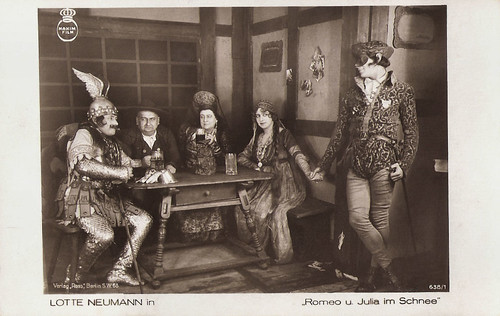
German postcard by Ross Verlag, no. 636/1. Photo: Maxim Film. Lotte Neumann in the comedy Romeo und Julia im Schnee/Romeo and Juliet in the Snow (Ernst Lubitsch, 1920). The man on the left dressed as an antique hero could be Julius Falkenstein as Paris. The others are from left to right Jakob Tiedtke (Herr Capulethofer), Marga Köhler (his wife), Lotte Neumann (Julia) and Gustav von Wangenheim (Romeo Montekugerl).

German postcard. Ross Verlag, no. 638/2. Photo: Maxim Film. Publicity still for Romeo und Julia im Schnee/Romeo and Juliet in the Snow (Ernst Lubitsch, 1920), with Lotte Neumann (Julia Capulethofer) and Gustav von Wangenheim (Romeo Montekugerl). Behind them, Jakob Tiedtke and Marga Köhler as Julia's parents.
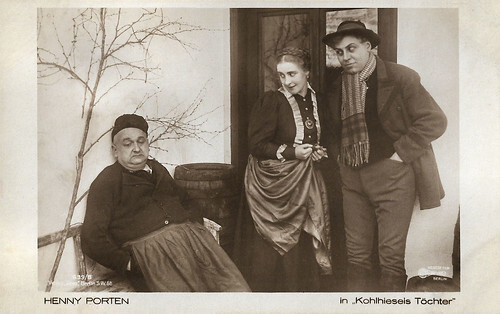
German postcard by Ross Verlag no. 639/8. Photo: Messter-Film. Jakob Tiedtke, Henny Porten and Emil Jannings in Kohlhiesels Töchter/Kohlhiesel's Daughters (Ernst Lubitsch, 1920).
Lubitsch's film daddy Tiedtke
Jakob Tiedtke had already come into contact with the new medium of cinematography at an early age and showed his art in various silent flicks. Since the end of World War I, the actor had firmly committed himself to the EFA-Filmgesellschaft. His first screen appearances are said to date back to 1906, when he starred in one-act plays by the director and film pioneer Oskar Messter, although there is no evidence of this today. The first film with Tiedtke, however, was made in 1913 under the title Schuldig/Guilty (Hans Oberländer, 1913) after the stage drama of the same name by Richard Voss, starring Eduard von Winterstein and produced by Messter.
Two years later Tiedtke appeared alongside Paul Wegener in the latter's classic Der Golem/The Golem (Paul Wegener, Heinrich Galeen, 1915). With Wegener in the lead, he would also act in Der Rattenfänger/The Pied Piper of Hamelin (Paul Wegener, 1918) and Der Galeerensträfling/The Galley Slave (Rochus Gliese, Paul Wegener, 1919). He preferred to work with director Ernst Lubitsch who gave him the nickname "Filmvater Tiedtke" (film daddy Tiedtke) and cast him in his silent productions Die Puppe/The Doll (Ernst Lubitsch, 1919), Kohlhiesels Töchter/Kohlhiesel's Daughters (Ernst Lubitsch, 1920), Romeo und Julia im Schnee/Romeo and Juliet in the Snow (Ernst Lubitsch, 1920), Sumurun (Ernst Lubitsch, 1920) and Die Flamme/The Flame (Ernst Lubitsch, 1922).
The imposing figure of the mime was used by the directors again and again for quirky and droll types, which Tiedtke always knew how to breathe life into. Other major productions in which Tiedtke was involved in the 1920s include the six-part adventure film Der Mann ohne Namen/Peter Voss, Thief of Millions (Georg Jacoby, 1921) with Harry Liedtke , the Henny Porten films Die Fahrt ins Blaue/A Drive into the Blue (Rudolf Biebrach, 1918), Der Kaufmann von Venedig/The Merchant of Venice (Peter Paul Felner, 1923), Das alte Gesetz/The Ancient Law (E.A. Dupont, 1923) and Kammermusik/Chamber Music (Carl Froelich, 1925), and the lost Murnau film Die Austreibung/The Expulsion (Friedrich Wilhelm Murnau, 1923).
Then followed the Lya Mara comedy Auf Befehl der Pompadour/By Order of Pompadour (Friedrich Zelnik, 1924), Ludwig Berger's Ein Walzertraum/A Waltz Dream (1925), the adventure film Pietro der Korsar/Peter the Pirate (Arthur Robison, 1925), Die Mühle von Sanssouci/The Mill of Sanssouci (Friedrich Zelnik, Siegfried Philippi, 1926) starring Otto Gebühr , (Nikolai Malikoff, 1927), Dr. Bessels Verwandlung/The Transformation of Dr. Bessel (Richard Oswald, 1927), Das Spreewaldmädel/When the Guard Marches (Hans Steinhoff, 1928) with Claire Rommer , the Ellen Richter film Moral (Willi Wolff, 1928), and the Käthe von Nagy comedy Mascottchen/Mascots (Felix Basch, 1929).
In Hans Kyser's prominent historical film Luther - Ein Film der deutschen Reformation/Luther (1927), Tiedtke, alongside Eugen Klöpfer in the title role of the reformer Martin Luther, was convincing as the indulgence preacher Johann Tetzel. Tiedtke became a well-known and popular actor on the screen, especially as an interpreter of comic roles and in the role of the older bon vivant.
He remained a busy actor in the 1930s and in the talkies, and knew how to play himself into the hearts of the audience with striking supporting roles and quirky characters in popular comedy plays of the time, but also in productions of other genres. For example, he was seen as landowner and bachelor Philipp Klapproth in the farce Pension Schöller (Georg Jacoby, 1930), or as Uncle Emil in the operetta adaptation Der Vetter aus Dingsda/The Cousin from Nowhere (Georg Zoch, 1934). His extensive filmography, which lists around 200 titles in the Internet Movie Database, includes successful films such as Yorck (Gustav Ucicky, 1931), Saison in Kairo/Season in Cairo (Reinhold Schünzel, 1933), Kleiner Mann - was nun?/Little Man, What Now? (Fritz Wendhausen, 1933), and the Heinz Rühmann films So ein Flegel/Such a Rascal (Robert A. Stemmle, 1934) and Nanu, Sie kennen Korff noch nicht?/So You Don't Know Korff Yet? (Fritz Holl, 1938).
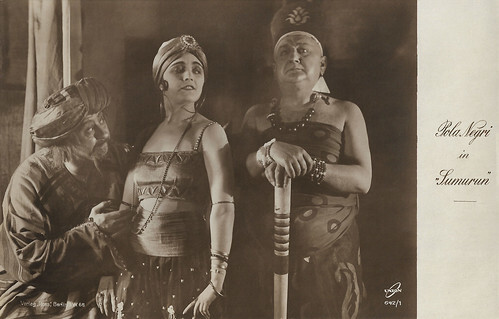
German postcard by Ross Verlag, no. 642/1. Photo: Union-Film. Pola Negri and Jakob Tiedtke in Sumurun (Ernst Lubitsch, 1920).
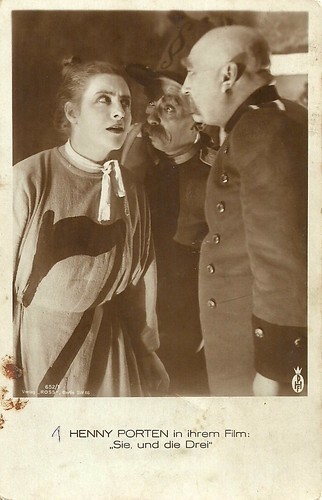
German postcard by Ross Verlag, no. 652/1. Photo: Henny Porten-Film. Henny Porten in the German silent comedy Sie und die Drei (E.A. Dupont, 1922). The man on the right could be Jakob Tiedtke.
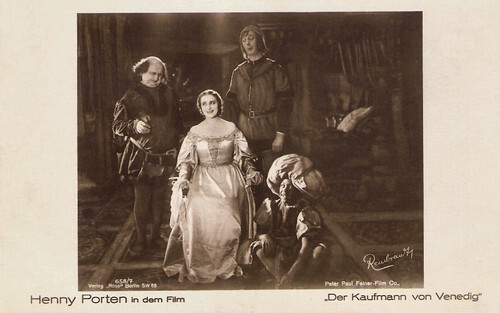
German postcard by Ross Verlag, no. 658/7. Photo: Rembrandt / Peter Paul Felner-Film Co. Henny Porten in Der Kaufmann von Venedig/The Merchant of Venice (Peter Paul Felner, 1923). The man on the left may be Jakob Tiedtke.
Sincerities of a tired liar
In the adventure Verwehte Spuren (1938), Jakob Tiedtke acted for the first time under the direction of Veit Harlan , with whom he realised several other films in the next years such as Das unsterbliche Herz/The Immortal Heart (Veit Harlan, 1939) and Die Reise nach Tilsit/The Journey to Tilsit (Veit Harlan, 1939). However, these also included the unspeakable hate flick Jud Süss/Süss the Jew (Veit Harlan, 1940) as well as the propaganda films Der große König (Veit Harlan, 1942) and Kolberg (Veit Harlan, 1945). In August 1944 propaganda minister Josef Goebbels had put Tiedtke on his so-called Gottbegnadeten-Liste, he was exempt from serving in the war.
The collaboration between Harlan and Tiedtke continued after World War II, Harlan entrusted him with smaller tasks in his films Unsterbliche Geliebte/Immortal Lovers (Veit Harlan, 1951), Hanna Amon (Veit Harlan, 1952) and Die blaue Stunde/The Blue Hour (Veit Harlan, 1953), which he made with his wife Kristina Söderbaum . Tiedtke's other post-war films include Königin einer Nacht/Queen of the Night (Kurt Hoffmann, 1951), Keine Angst vor großen Tieren/Not Afraid of Big Animals (Ulrich Erfurth, 1953), Der Raub der Sabinerinnen/The Abduction of the Sabine Women (Kurt Hoffmann, 1954), Emil und die Detektive/Emil and the Detectives (Robert A. Stemmle, 1954) and finally Urlaub auf Ehrenwort/Leave on Word of Honour (Wolfgang Liebeneiner, 1955).
After that, Tiedtke slowly withdrew from acting and into private life. Until the 1950s he also worked on radio, especially for the Berlin radio station RIAS (Rundfunk im amerikanischen Sektor) and the Nordwestdeutscher Rundfunk (NWDR). After the end of the war, he was seen on stage in 1947 in the Lustspielhaus des Westens in Berlin-Friedenau together with Heli Finkenzeller and her husband Will Dohm in the comedy 'Götterkinder' (Children of the Gods) by F. D. Andam and Werner P. Zibaso.
He celebrated one of his last successes at the Berlin Schillertheater with the role of the aged Theodotus in a performance of the comedy 'Caesar and Cleopatra' by George Bernard Shaw with Walter Franck and Luitgard Im in the title roles. After the performance, he was awarded the Federal Cross of Merit for his life's work, and the Association for the History of Berlin appointed him an honorary member. Tiedtke was a friend and patron of the theatre critic and publicist Siegfried Jacobsohn.
He also had a special artistic friendship with the playwright and author Gerhart Hauptmann. In 1921, Hauptmann wrote a play especially for Tiedtke: 'Peter Brauer', the tragicomedy of an incompetent painter. It was a weak play, but Tiedtke carried it on his broad back over a hundred dangers towards great success. The premiere took place on 1 November 1921 in the Berlin Lustspielhaus, directed by Heinz Saltenburg.
Tiedtke died a few days after his 85th birthday on 30 June 1960 in his cottage in Berlin-Kladow. He had suddenly lapsed into a deep unconsciousness from which he never awoke. He was laid to rest at the Berlin cemetery Heerstraße. He left behind his wife Hanna, who was later buried at her husband's side. As the newspaper Der Zeit wrote, in his house, "Upstairs, in the Salong with a view of the Havel, Mrs. Hanna held coffee chatter, his charming, much younger wife with her at once distinguished and sedate Baltic accent, who served her husband, as he said, as 'Souffleuse and Schofföse', because he memorised his roles with her and because she drove him to the theatre in Berlin". Tiedtke's written estate is at the Staatsbibliothek zu Berlin. He called his memoirs, written in 1951 but never published, 'Aufrichtigkeiten eines ermüdeten Lügners' (Sincerities of a tired liar).
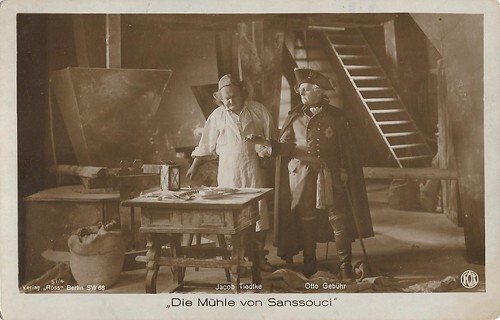
German postcard by Ross Verlag, no. 51/4. Photo: Fox. Otto Gebühr as King Frederick the Great and Jakob Tiedtke in the German silent film Die Mühle von Sanssouci/The Mill of Sanssouci (Friedrich Zelnik, Siegfried Philippi, 1926).
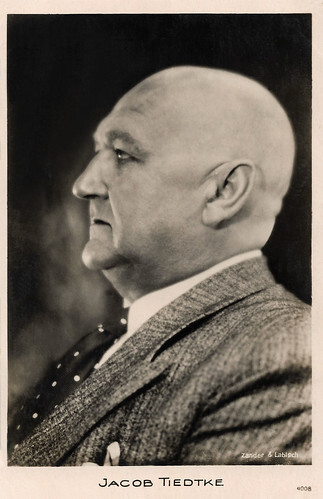
German postcard, no. 4008. Photo: Zander & Labisch.
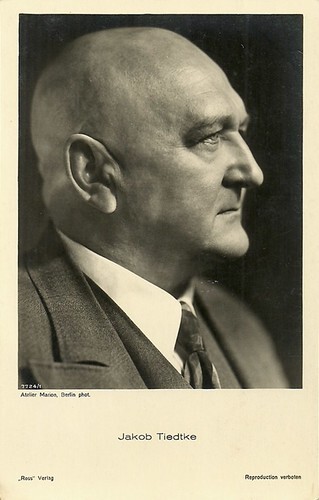
German postcard by Ross Verlag, no. 7724/1, 1932-33. Photo: Atelier Marion.
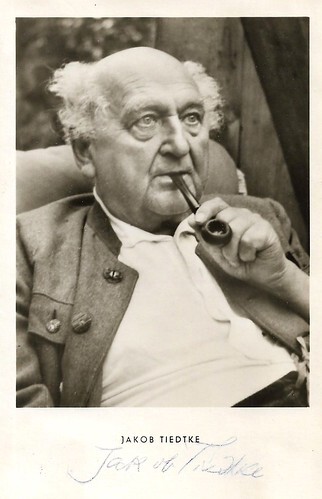
West-German postcard by Kunst und Bild, Berlin. Autographed postcard.
Sources: Stephanie d'Heil (Steffi-Line.de - German), Wikipedia (German), and Filmportal.

German cigarette card in the series Unsere Bunten Filmbilder by Ross Verlag for Cigarettenfabrik Josetti, Berlin, no. 179. Photo: Ufa.
The corps bird of Max Reinhardt
Jakob Karl Heinrich Wilhelm Tiedtke was born in 1875 in Rixdorf near Berlin, today the district of Berlin-Neukölln. His father was a humorous writer and contributor to the richly illustrated German weekly Fliegende Blätter, Kladderadatsch, and the like. After attending the Köllnisches Gymnasium in his native city, Tiedtke graduated from the Seebach-Schule, which was affiliated with the Berlin Königliches Schauspielhaus.
After completing his studies, the young actor made his debut there in 1899 as Cato in the Shakespeare tragedy 'Julius Caesar' and shortly afterwards went to the Preußisches Hoftheater, where he was a member of the ensemble until 1905. Then he followed a call from Max Reinhardt to the Deutsches Theater for eight years, where he distinguished himself as a hard-working character actor. At Max Reinhardt 's Deutsches Theater Tiedtke became known as the "corpse bird" when he was not playing himself, he sat in the stalls so that he could step in immediately if an actor dropped out.
He had all the possible roles in his head. Thus he became Reinhardt's busiest character actor, portraying mostly old men in over 100 productions, such as the medical councillor Dr. von Brausepulver in the world premiere of Frank Wedekind's children's tragedy 'Frühlings Erwachen' (Spring Awakening, 1906). The transition to comedian came with increasing corpulence. Tiedtke recounts how he was once asked to stand in for an actor who had fallen ill and play old Moor, who is locked in the hunger tower by his own son.
In 1913 Jakob Tiedtke moved to the private Deutsche Künstlertheater Societät and a year later to the Lessingtheater under the direction of Victor Barnowsky. This was followed in 1915 by a three-year engagement at the famous Vienna Burgtheater. Until 1925 Tiedtke made guest appearances at various Berlin theatres and belonged to the ensemble of the Berlin Volksbühne from 1933 to 1945. During the National Socialist era, he was a presidential advisor to the NS leader corps Kameradschaft der deutschen Künstler.
After the end of World War II, Tiedtke founded the Künstlergemeinschaft Bad Ischl together with Theo Lingen , Paul Kemp , Siegfried Breuer and other fellow actors, which toured Austria for two years. Afterwards, the actor was able to perform successfully again in Munich and Berlin, and he also shone in Hamburg, among other places, at the Thalia Theater at the beginning of November 1949, where, on the occasion of his 50th stage anniversary, the comedy 'Der gute Onkel Jan' by Georges Feydeau with Tiedtke in the title role was performed in German for the first time. In addition to important theatre characters such as Iago in Shakespeare's 'Othello', Mephisto in Goethe's 'Faust', or Franz Moor in Schiller's 'Die Räuber', his brilliant roles on stage included above all interpretations in classical comedy plays and farces. Among others, Tiedtke shone as the village judge Adam in Kleist's 'Der zerbrochne Krug', as Theobald Maske in Sternheim's 'Die Hose', or as Falstaff in the Shakespeare comedy 'The Merry Wives of Windsor'.
As a performer of Molière's characters, he impressed the audience as 'Der eingebildete Kranke' (Le malade imaginaire), as 'Tartuffe', and as 'Der Geizige' (L'avare), and he was equally captivating as the smear theatre director Emanuel Striese in the farce 'Der Raub der Sabinerinnen' by Franz and Paul von Schönthan or as Baron Weps in the operetta 'Der Vogelhändler' by Carl Zeller. His Berlin humour and Berlin imperturbability shaped Tiedtke's character, which he also lent to his characters on stage. He was more of a quiet comedian who cared more about the heart than the punch line. Tiedtke always wanted to play as realistically as possible, never elevating himself above his characters or presenting satirical commentary. "I don't want people to see that he is an actor! That is my creed". He avoided exaggeration, strove for moderation and naturalness, and in his private life was proud of the fact that people said to him: "If I didn't know that you were Tiedtke, I would never take you for Tiedtke!" "Ick bin normal". He was proud of that.

German postcard by Ross Verlag, no. 636/1. Photo: Maxim Film. Lotte Neumann in the comedy Romeo und Julia im Schnee/Romeo and Juliet in the Snow (Ernst Lubitsch, 1920). The man on the left dressed as an antique hero could be Julius Falkenstein as Paris. The others are from left to right Jakob Tiedtke (Herr Capulethofer), Marga Köhler (his wife), Lotte Neumann (Julia) and Gustav von Wangenheim (Romeo Montekugerl).

German postcard. Ross Verlag, no. 638/2. Photo: Maxim Film. Publicity still for Romeo und Julia im Schnee/Romeo and Juliet in the Snow (Ernst Lubitsch, 1920), with Lotte Neumann (Julia Capulethofer) and Gustav von Wangenheim (Romeo Montekugerl). Behind them, Jakob Tiedtke and Marga Köhler as Julia's parents.

German postcard by Ross Verlag no. 639/8. Photo: Messter-Film. Jakob Tiedtke, Henny Porten and Emil Jannings in Kohlhiesels Töchter/Kohlhiesel's Daughters (Ernst Lubitsch, 1920).
Lubitsch's film daddy Tiedtke
Jakob Tiedtke had already come into contact with the new medium of cinematography at an early age and showed his art in various silent flicks. Since the end of World War I, the actor had firmly committed himself to the EFA-Filmgesellschaft. His first screen appearances are said to date back to 1906, when he starred in one-act plays by the director and film pioneer Oskar Messter, although there is no evidence of this today. The first film with Tiedtke, however, was made in 1913 under the title Schuldig/Guilty (Hans Oberländer, 1913) after the stage drama of the same name by Richard Voss, starring Eduard von Winterstein and produced by Messter.
Two years later Tiedtke appeared alongside Paul Wegener in the latter's classic Der Golem/The Golem (Paul Wegener, Heinrich Galeen, 1915). With Wegener in the lead, he would also act in Der Rattenfänger/The Pied Piper of Hamelin (Paul Wegener, 1918) and Der Galeerensträfling/The Galley Slave (Rochus Gliese, Paul Wegener, 1919). He preferred to work with director Ernst Lubitsch who gave him the nickname "Filmvater Tiedtke" (film daddy Tiedtke) and cast him in his silent productions Die Puppe/The Doll (Ernst Lubitsch, 1919), Kohlhiesels Töchter/Kohlhiesel's Daughters (Ernst Lubitsch, 1920), Romeo und Julia im Schnee/Romeo and Juliet in the Snow (Ernst Lubitsch, 1920), Sumurun (Ernst Lubitsch, 1920) and Die Flamme/The Flame (Ernst Lubitsch, 1922).
The imposing figure of the mime was used by the directors again and again for quirky and droll types, which Tiedtke always knew how to breathe life into. Other major productions in which Tiedtke was involved in the 1920s include the six-part adventure film Der Mann ohne Namen/Peter Voss, Thief of Millions (Georg Jacoby, 1921) with Harry Liedtke , the Henny Porten films Die Fahrt ins Blaue/A Drive into the Blue (Rudolf Biebrach, 1918), Der Kaufmann von Venedig/The Merchant of Venice (Peter Paul Felner, 1923), Das alte Gesetz/The Ancient Law (E.A. Dupont, 1923) and Kammermusik/Chamber Music (Carl Froelich, 1925), and the lost Murnau film Die Austreibung/The Expulsion (Friedrich Wilhelm Murnau, 1923).
Then followed the Lya Mara comedy Auf Befehl der Pompadour/By Order of Pompadour (Friedrich Zelnik, 1924), Ludwig Berger's Ein Walzertraum/A Waltz Dream (1925), the adventure film Pietro der Korsar/Peter the Pirate (Arthur Robison, 1925), Die Mühle von Sanssouci/The Mill of Sanssouci (Friedrich Zelnik, Siegfried Philippi, 1926) starring Otto Gebühr , (Nikolai Malikoff, 1927), Dr. Bessels Verwandlung/The Transformation of Dr. Bessel (Richard Oswald, 1927), Das Spreewaldmädel/When the Guard Marches (Hans Steinhoff, 1928) with Claire Rommer , the Ellen Richter film Moral (Willi Wolff, 1928), and the Käthe von Nagy comedy Mascottchen/Mascots (Felix Basch, 1929).
In Hans Kyser's prominent historical film Luther - Ein Film der deutschen Reformation/Luther (1927), Tiedtke, alongside Eugen Klöpfer in the title role of the reformer Martin Luther, was convincing as the indulgence preacher Johann Tetzel. Tiedtke became a well-known and popular actor on the screen, especially as an interpreter of comic roles and in the role of the older bon vivant.
He remained a busy actor in the 1930s and in the talkies, and knew how to play himself into the hearts of the audience with striking supporting roles and quirky characters in popular comedy plays of the time, but also in productions of other genres. For example, he was seen as landowner and bachelor Philipp Klapproth in the farce Pension Schöller (Georg Jacoby, 1930), or as Uncle Emil in the operetta adaptation Der Vetter aus Dingsda/The Cousin from Nowhere (Georg Zoch, 1934). His extensive filmography, which lists around 200 titles in the Internet Movie Database, includes successful films such as Yorck (Gustav Ucicky, 1931), Saison in Kairo/Season in Cairo (Reinhold Schünzel, 1933), Kleiner Mann - was nun?/Little Man, What Now? (Fritz Wendhausen, 1933), and the Heinz Rühmann films So ein Flegel/Such a Rascal (Robert A. Stemmle, 1934) and Nanu, Sie kennen Korff noch nicht?/So You Don't Know Korff Yet? (Fritz Holl, 1938).

German postcard by Ross Verlag, no. 642/1. Photo: Union-Film. Pola Negri and Jakob Tiedtke in Sumurun (Ernst Lubitsch, 1920).

German postcard by Ross Verlag, no. 652/1. Photo: Henny Porten-Film. Henny Porten in the German silent comedy Sie und die Drei (E.A. Dupont, 1922). The man on the right could be Jakob Tiedtke.

German postcard by Ross Verlag, no. 658/7. Photo: Rembrandt / Peter Paul Felner-Film Co. Henny Porten in Der Kaufmann von Venedig/The Merchant of Venice (Peter Paul Felner, 1923). The man on the left may be Jakob Tiedtke.
Sincerities of a tired liar
In the adventure Verwehte Spuren (1938), Jakob Tiedtke acted for the first time under the direction of Veit Harlan , with whom he realised several other films in the next years such as Das unsterbliche Herz/The Immortal Heart (Veit Harlan, 1939) and Die Reise nach Tilsit/The Journey to Tilsit (Veit Harlan, 1939). However, these also included the unspeakable hate flick Jud Süss/Süss the Jew (Veit Harlan, 1940) as well as the propaganda films Der große König (Veit Harlan, 1942) and Kolberg (Veit Harlan, 1945). In August 1944 propaganda minister Josef Goebbels had put Tiedtke on his so-called Gottbegnadeten-Liste, he was exempt from serving in the war.
The collaboration between Harlan and Tiedtke continued after World War II, Harlan entrusted him with smaller tasks in his films Unsterbliche Geliebte/Immortal Lovers (Veit Harlan, 1951), Hanna Amon (Veit Harlan, 1952) and Die blaue Stunde/The Blue Hour (Veit Harlan, 1953), which he made with his wife Kristina Söderbaum . Tiedtke's other post-war films include Königin einer Nacht/Queen of the Night (Kurt Hoffmann, 1951), Keine Angst vor großen Tieren/Not Afraid of Big Animals (Ulrich Erfurth, 1953), Der Raub der Sabinerinnen/The Abduction of the Sabine Women (Kurt Hoffmann, 1954), Emil und die Detektive/Emil and the Detectives (Robert A. Stemmle, 1954) and finally Urlaub auf Ehrenwort/Leave on Word of Honour (Wolfgang Liebeneiner, 1955).
After that, Tiedtke slowly withdrew from acting and into private life. Until the 1950s he also worked on radio, especially for the Berlin radio station RIAS (Rundfunk im amerikanischen Sektor) and the Nordwestdeutscher Rundfunk (NWDR). After the end of the war, he was seen on stage in 1947 in the Lustspielhaus des Westens in Berlin-Friedenau together with Heli Finkenzeller and her husband Will Dohm in the comedy 'Götterkinder' (Children of the Gods) by F. D. Andam and Werner P. Zibaso.
He celebrated one of his last successes at the Berlin Schillertheater with the role of the aged Theodotus in a performance of the comedy 'Caesar and Cleopatra' by George Bernard Shaw with Walter Franck and Luitgard Im in the title roles. After the performance, he was awarded the Federal Cross of Merit for his life's work, and the Association for the History of Berlin appointed him an honorary member. Tiedtke was a friend and patron of the theatre critic and publicist Siegfried Jacobsohn.
He also had a special artistic friendship with the playwright and author Gerhart Hauptmann. In 1921, Hauptmann wrote a play especially for Tiedtke: 'Peter Brauer', the tragicomedy of an incompetent painter. It was a weak play, but Tiedtke carried it on his broad back over a hundred dangers towards great success. The premiere took place on 1 November 1921 in the Berlin Lustspielhaus, directed by Heinz Saltenburg.
Tiedtke died a few days after his 85th birthday on 30 June 1960 in his cottage in Berlin-Kladow. He had suddenly lapsed into a deep unconsciousness from which he never awoke. He was laid to rest at the Berlin cemetery Heerstraße. He left behind his wife Hanna, who was later buried at her husband's side. As the newspaper Der Zeit wrote, in his house, "Upstairs, in the Salong with a view of the Havel, Mrs. Hanna held coffee chatter, his charming, much younger wife with her at once distinguished and sedate Baltic accent, who served her husband, as he said, as 'Souffleuse and Schofföse', because he memorised his roles with her and because she drove him to the theatre in Berlin". Tiedtke's written estate is at the Staatsbibliothek zu Berlin. He called his memoirs, written in 1951 but never published, 'Aufrichtigkeiten eines ermüdeten Lügners' (Sincerities of a tired liar).

German postcard by Ross Verlag, no. 51/4. Photo: Fox. Otto Gebühr as King Frederick the Great and Jakob Tiedtke in the German silent film Die Mühle von Sanssouci/The Mill of Sanssouci (Friedrich Zelnik, Siegfried Philippi, 1926).

German postcard, no. 4008. Photo: Zander & Labisch.

German postcard by Ross Verlag, no. 7724/1, 1932-33. Photo: Atelier Marion.

West-German postcard by Kunst und Bild, Berlin. Autographed postcard.
Sources: Stephanie d'Heil (Steffi-Line.de - German), Wikipedia (German), and Filmportal.
Published on January 09, 2023 22:00
January 8, 2023
Franchot Tone
American actor Franchot Tone (1905-1968) broke through on Broadway with his role in 'The Age of Innocence' (1929). In 1932, he moved to Hollywood where he immediately had success in such films as The Wiser Sex (1932), Bombshell (1933) and Today We Live (1933) with Joan Crawford whom he married in 1935. For Mutiny on the Bounty (1935), he was nominated for the Oscar for Best Actor. After this peak, his career gradually went downhill.
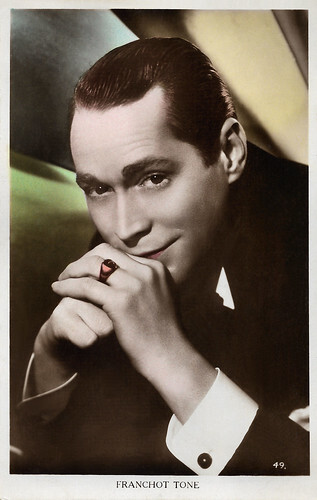
British postcard by Art Photo Postcard, no. 36-2. Caption: Franchot Tone - Born within sound of Niagara Falls. Graduated at Cornell University. Has appeared in Straight is the Way and Reckless. Weighs 11 1/2 st. and is 9 ft. tall.
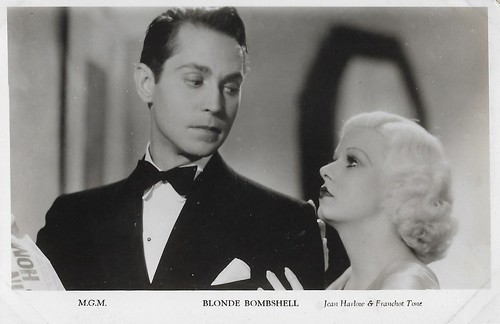
British postcard by Film Weekly. Photo: MGM. Jean Harlow and Franchot Tone in the American pre-Code screwball comedy Blonde Bombshell/Bombshell (Victor Fleming, 1933).
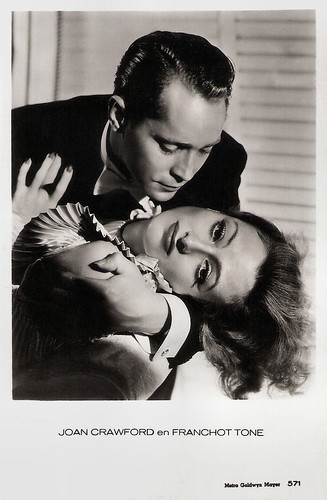
Dutch postcard, no. 571. Photo: George Hurrell / Metro-Goldwyn-Mayer (MGM). Joan Crawford and Franchot Tone in Dancing Lady (Robert Z. Leonard, 1933).
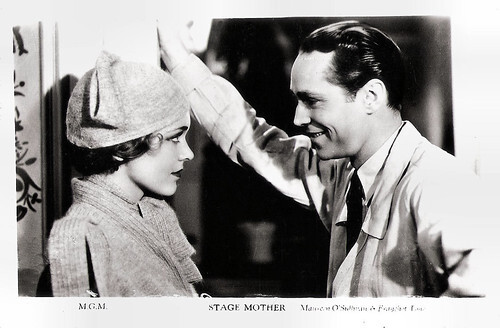
British postcard in the Filmshots series by Film Weekly. Photo: M.G.M. Maureen O'Sullivan and Franchot Tone in Stage Mother (Charles Brabin, 1933).
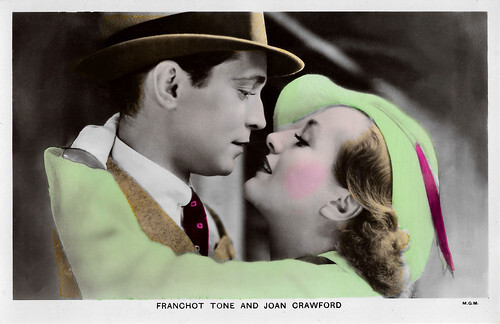
British postcard in the Film Partners Series, London, no. PC 133. Photo: Metro-Goldwyn-Mayer. Franchot Tone and Joan Crawford in Sadie McKee (Clarence Brown, 1934).
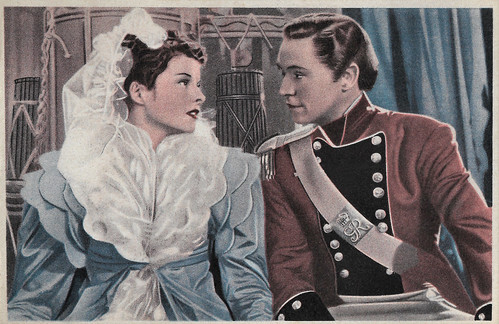
Italian postcard by Generalcine, Roma / Off. Graf. 'La Lito', Milano. Photo: RKO Radio Pictures. Katharine Hepburn and Franchot Tone in Quality Street (George Stevens, 1937).
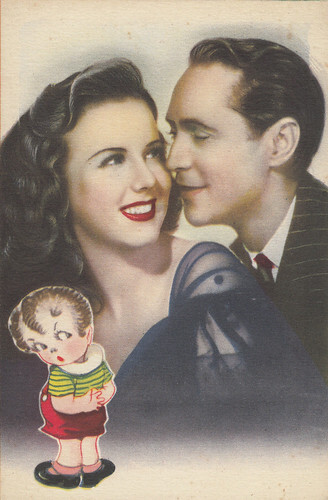
Portuguese postcard by Postais Krohn, Porto. Deanna Durbin and Franchot Tone in His Butler’s Sister (Frank Borzage, 1943). Collection: Marlene Pilaete.
Roles as a wealthy playboy or lover of the female lead
Stanislas Pascal Franchot Tone was born in 1905 in Niagara Falls, New York. He was the son of Dr. Frank Jerome Tone, a pioneer in the electrochemistry field and the wealthy president of the Carborundum Company, and his socially prominent wife, Gertrude Van Vrancken Franchot.
Franchot became interested in acting at an early age and was president of the drama club at Cornell University during his student days. Tone was originally supposed to take over the family business, but he decided to pursue a show career. He moved to Greenwich Village in New York and was already acting on Broadway during the late 1920s, in Katharine Cornell's production of 'The Age of Innocence' (1929).
Later he also became a member of the Theatre Guild and played Curly in their production of 'Green Grow the Lilacs' (1931), which later became the basis for the musical 'Oklahoma!'. Tone was also a founding member of the Group Theatre, when the Theater Guild disbanded, along with other former guild members Harold Clurman, Cheryl Crawford, Lee Strasberg, Stella Adler, and Clifford Odets. The Group Theatre was the first acting company in America to bring Konstantin Stanislavski 's revolutionary acting techniques to America.
Franchot Tone's first film was The Wiser Sex (Berthold Viertel, 1932), starring Claudette Colbert , filmed by Paramount at their Astoria Studios. Tone was the first of the Group to go to Hollywood when MGM offered him a film contract. MGM immediately gave Tone a series of impressive roles and he made his breakthrough with the romantic WWI drama Today We Live (Howard Hawks, 1933), written by William Faulkner. Tone was then the romantic male lead in Gabriel Over the White House (Gregory La Cava, 1933) starring Walter Huston. He also had an excellent role in the screwball comedy Bombshell (Victor Fleming, 1933), with Jean Harlow . The last of his 1933 films was Dancing Lady (Robert Z. Leonard, 1933 ), with an on-screen love triangle between Joan Crawford , Clark Gable and him.
In 1935 Tone married Crawford, with whom he made a total of seven films. Before the two actors divorced in 1938, Crawford had suffered several miscarriages. One of his best-known performances was as for his role as Midshipman Roger Byam in the classic adventure film Mutiny on the Bounty (Frank Lloyd, 1935), for which he received an Oscar nomination for Best Actor. Despite historical inaccuracies, the film was a huge box office success, becoming the highest-grossing film of 1935 and one of MGM's biggest hits of the 1930s. That same year he appeared in Henry Hathaway's also highly successful adventure film The Lives of a Bengal Lancer (1935) with Gary Cooper .
Warner Bros. borrowed him to play Bette Davis ' leading man in Dangerous (Alfred E. Green, 1935). In his films, Tone was often entrusted with playing second leads, such as a wealthy playboy or lover of the female lead who doesn't end up getting the leading lady. After his contract ended, Tone left MGM in 1939 to act on Broadway in a return to his stage roots, often working with the Group Theatre's members of its formative years, and playwrights such as Eugene O'Neill. He returned to Broadway for Irwin Shaw's 'The Gentle People' (1939) and an adaptation of Ernest Hemingway's 'The Fifth Column' (1940), which only had a short run.
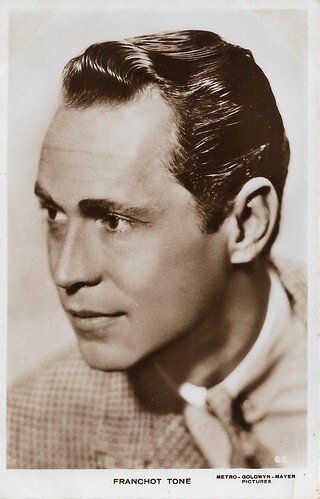
British Real Photograph postcard, no. 62. Photo: Metro-Goldwyn-Mayer Pictures.
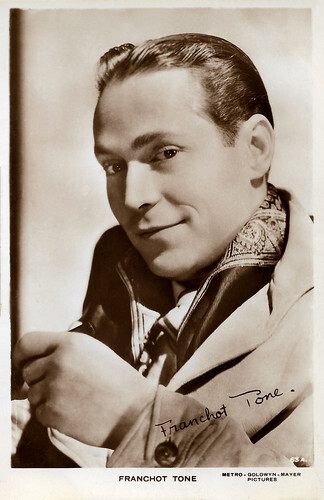
British Real Photograph postcard, no. 63 A. Photo: Metro-Goldwyn-Mayer Pictures.
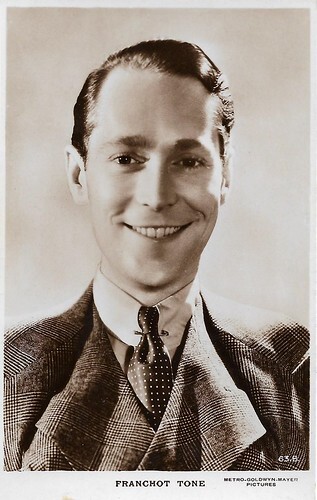
British Real Photograph postcard, no. 63 B. Photo: Metro-Goldwyn-Mayer Pictures.
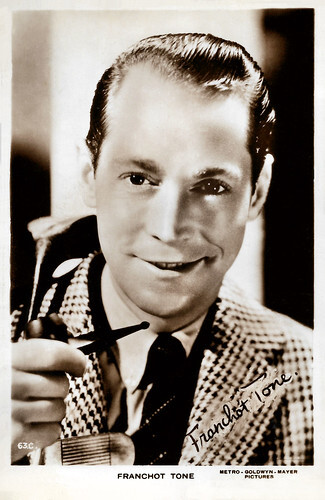
British Real Photograph postcard, no. 63 C. Photo: Metro-Goldwyn-Mayer Pictures.
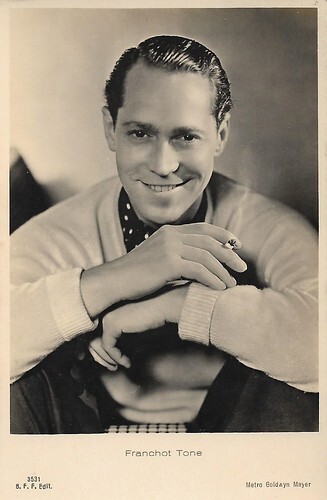
Italian postcard by B.F.F. Edit., no. 3531. Photo: Metro-Goldwyn-Mayer.
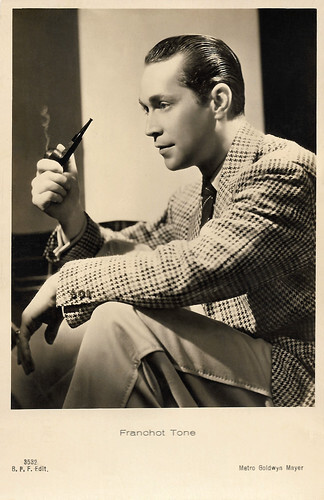
Italian postcard by B.F.F. Edit., no. 3532. Photo: Metro-Goldwyn-Mayer.
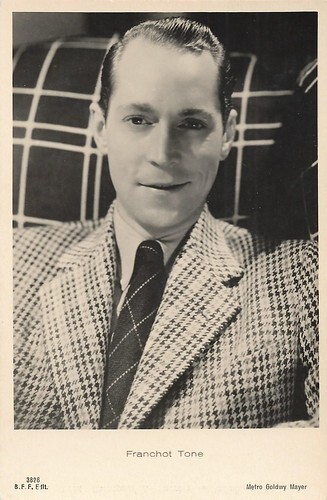
Italian postcard by B.F.F. Edit., no. 3828. Photo: Metro-Goldwyn-Mayer.
A love rival in the battle for Barbara Payton
In the 1940s, Franchot Tone's film career continued successfully. A departure from his usual role pattern was the lead in Billy Wilder's war film Five Graves to Cairo (1942), in which he is the sole survivor of a unit of British soldiers stranded in a lonely Sahara hotel. Erich von Stroheim portrays Field Marshal Erwin Rommel in a supporting performance.
In Robert Siodmak's gritty Film Noir Phantom Lady (1944), Tone's character turns out to be a murderer at the end of the film. In 1941 he married the fashion model-turned-actress Jean Wallace, with whom he co-starred in the Film Noir, Jigsaw (Fletcher Markle, 1949). In 1948 this marriage also ended in divorce. Tone produced and starred with Charles Laughton in The Man on the Eiffel Tower (Burgess Meredith, 1949), a troubled production suffering from filming delays on location, creative wrangling and the pictures hard to transfer single-strip technicolour film stock.
In 1951 Tone married the young actress Barbara Payton , who suffered from alcohol and drug addiction. A love rival in the battle for Payton was the actor Tom Neal. A fight ensued in which Tone suffered numerous injuries and went into a coma for 18 hours. He survived and plastic surgery nearly fully restored his broken nose and cheek. He married Payton in 1951, but he divorced her just one year later, after obtaining photographic evidence she had continued her relationship with Neal. Payton and Neal capitalised on the scandal by touring with a production of 'The Postman Always Rings Twice'.
Tone was listed as one of "Stalin's Stars" in the Red Treason in Hollywood published by Myron C. Fagan and was put on a Hollywood blacklist during the McCarthy era. He left Hollywood and returned to his roots in New York. There he starred again on Broadway in the big hit 'Oh, Men! Oh, Women!' (1953–1954), which ran for 400 performances. He also appeared in a revival of 'The Time of Your Life' (1955) and Eugene O'Neill's 'A Moon for the Misbegotten' (1957) with Wendy Hiller and Cyril Cusack.
He acted in numerous television shows, including as the choleric Juror No. 3 in the original television version of Twelve Angry Men (Franklin Schaffner, 1954), on which the classic film 12 Angry Men (Sidney Lumet, 1957) starring Henry Fonda was based. He also made guest appearances in series such as Bonanza and Twilight Zone. In 1956 Tone married Dolores Dorn, with whom he appeared in a film version of Uncle Vanya (1957) which Tone directed and produced. His fourth marriage also ended in divorce in 1959.
In 1960, Tone received a star on the Hollywood Walk of Fame for his film work. He made a late return to Hollywood in 1962 as a character actor in Otto Preminger's star-studded political drama Advise & Consent (1962), in which he plays the charismatic but terminally ill US president. On stage, he acted in a revival of Eugene O'Neill's 'Strange Interlude' (1963), with Ben Gazzara and Jane Fonda . He appeared in what is possibly the first TV movie, See How They Run (David Lowell Rich, 1964) with John Forsythe and Senta Berger . He had roles in Otto Preminger's film In Harm's Way (1965) in which he portrayed Admiral Husband E. Kimmel and Arthur Penn's Mickey One (1965). His last film role was in the British spy-thriller The High Commissioner/Nobody Runs Forever (Ralph Thomas, 1968) starring Rod Taylor and Christopher Plummer.
In 1968 Franchot Tone died of lung cancer at the age of 63. When Tone was dying, Joan Crawford often cared for him, paying for medical treatments and at one point, Tone suggested they remarry, but she declined the offer. He had two sons with Jean Wallace, Pascal Franchot Tone and Thomas Jefferson Tone. Tone was cremated and his ashes were kept on a shelf in his son's library, surrounded by the works of William Shakespeare , until 2022, when they were interred in the Point Comfort Cemetery in Quebec, Canada.
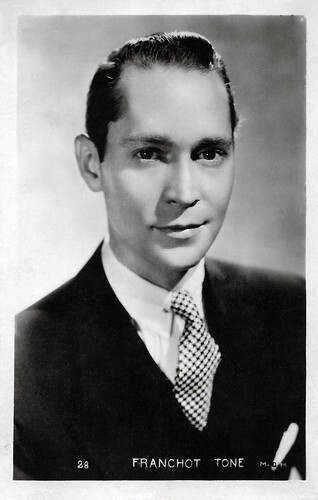
French postcard, no. 28. Photo: Metro-Goldwyn-Mayer.
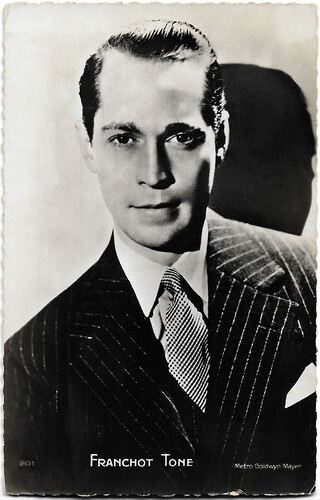
French postcard by Editions P.I., Paris, no. 201. Photo: Metro-Goldwyn-Mayer.
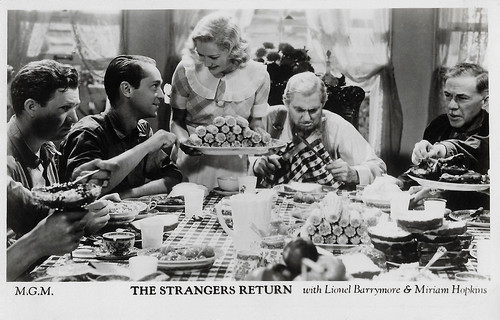
British postcard by Film Weekly. Photo: MGM. Miriam Hopkins , Stuart Erwin, Franchot Tone and Lionel Barrymore in The Stranger's Return (King Vidor, 1933).
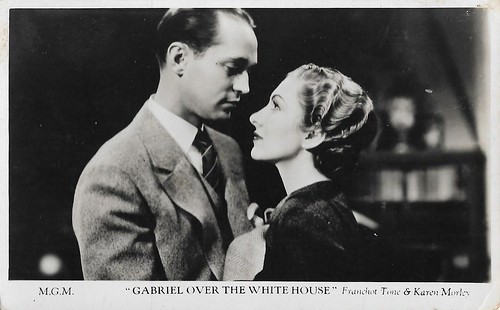
British postcard by Film Weekly. Photo: MGM. Karen Morley and Franchot Tone in Gabriel over the White House (Gregory La Cava, 1933).
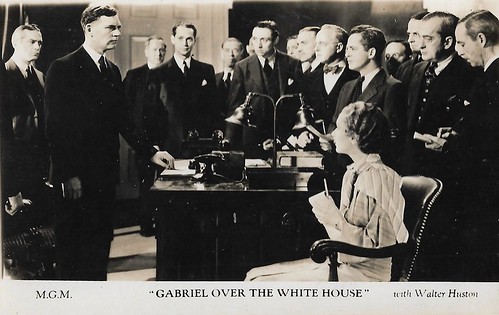
British postcard by Film Weekly. Photo: MGM. Walter Huston, Karen Morley and Franchot Tone in Gabriel over the White House (Gregory La Cava, 1933).
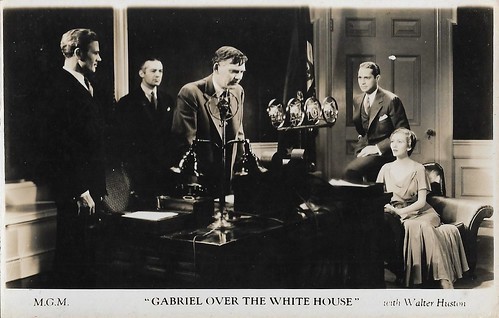
British postcard by Film Weekly. Photo: MGM. Walter Huston, Franchot Tone and Karen Morley in Gabriel over the White House (Gregory La Cava, 1933).
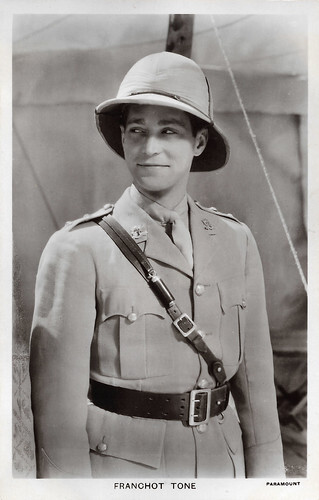
British postcard in the Picturegoer Series, London, no. 956. Photo: Paramount. Franchot Tone in The Lives of a Bengal Lancer (Henry Hathaway, 1935).
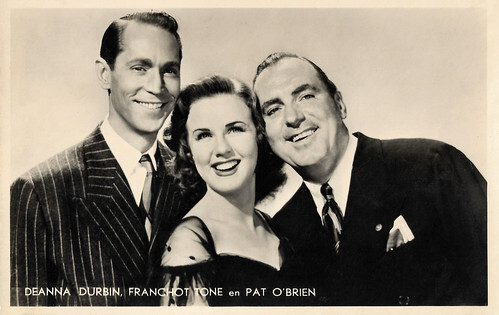
Dutch postcard by J.S.A. (J. Sleding, Amsterdam. Photo: F.B.O. - M.P.E. / Universal. Deanna Durbin , Franchot Tone and Pat 'O Brien in His Butler's Sister (Frank Borzage, 1943).

American postcard, no. 491. Franchot Tone, Betsy von Fürstenberg and Gig Young in the comedy play 'Oh, men! Oh, women!' (1953) by Edward Chodorov at the Henry Miller's Theatre (now Stephen Sondheim Theatre), New York City. John Chapman, N. Y. Daily News said: "Happy, Hilarious and Human". Walter Kerr, N.Y. Herald Tribune said: "Extremely Funny - A Dandy Show."
Sources: (IMDb), Wikipedia (German, Dutch and English) and .

British postcard by Art Photo Postcard, no. 36-2. Caption: Franchot Tone - Born within sound of Niagara Falls. Graduated at Cornell University. Has appeared in Straight is the Way and Reckless. Weighs 11 1/2 st. and is 9 ft. tall.

British postcard by Film Weekly. Photo: MGM. Jean Harlow and Franchot Tone in the American pre-Code screwball comedy Blonde Bombshell/Bombshell (Victor Fleming, 1933).

Dutch postcard, no. 571. Photo: George Hurrell / Metro-Goldwyn-Mayer (MGM). Joan Crawford and Franchot Tone in Dancing Lady (Robert Z. Leonard, 1933).

British postcard in the Filmshots series by Film Weekly. Photo: M.G.M. Maureen O'Sullivan and Franchot Tone in Stage Mother (Charles Brabin, 1933).

British postcard in the Film Partners Series, London, no. PC 133. Photo: Metro-Goldwyn-Mayer. Franchot Tone and Joan Crawford in Sadie McKee (Clarence Brown, 1934).

Italian postcard by Generalcine, Roma / Off. Graf. 'La Lito', Milano. Photo: RKO Radio Pictures. Katharine Hepburn and Franchot Tone in Quality Street (George Stevens, 1937).

Portuguese postcard by Postais Krohn, Porto. Deanna Durbin and Franchot Tone in His Butler’s Sister (Frank Borzage, 1943). Collection: Marlene Pilaete.
Roles as a wealthy playboy or lover of the female lead
Stanislas Pascal Franchot Tone was born in 1905 in Niagara Falls, New York. He was the son of Dr. Frank Jerome Tone, a pioneer in the electrochemistry field and the wealthy president of the Carborundum Company, and his socially prominent wife, Gertrude Van Vrancken Franchot.
Franchot became interested in acting at an early age and was president of the drama club at Cornell University during his student days. Tone was originally supposed to take over the family business, but he decided to pursue a show career. He moved to Greenwich Village in New York and was already acting on Broadway during the late 1920s, in Katharine Cornell's production of 'The Age of Innocence' (1929).
Later he also became a member of the Theatre Guild and played Curly in their production of 'Green Grow the Lilacs' (1931), which later became the basis for the musical 'Oklahoma!'. Tone was also a founding member of the Group Theatre, when the Theater Guild disbanded, along with other former guild members Harold Clurman, Cheryl Crawford, Lee Strasberg, Stella Adler, and Clifford Odets. The Group Theatre was the first acting company in America to bring Konstantin Stanislavski 's revolutionary acting techniques to America.
Franchot Tone's first film was The Wiser Sex (Berthold Viertel, 1932), starring Claudette Colbert , filmed by Paramount at their Astoria Studios. Tone was the first of the Group to go to Hollywood when MGM offered him a film contract. MGM immediately gave Tone a series of impressive roles and he made his breakthrough with the romantic WWI drama Today We Live (Howard Hawks, 1933), written by William Faulkner. Tone was then the romantic male lead in Gabriel Over the White House (Gregory La Cava, 1933) starring Walter Huston. He also had an excellent role in the screwball comedy Bombshell (Victor Fleming, 1933), with Jean Harlow . The last of his 1933 films was Dancing Lady (Robert Z. Leonard, 1933 ), with an on-screen love triangle between Joan Crawford , Clark Gable and him.
In 1935 Tone married Crawford, with whom he made a total of seven films. Before the two actors divorced in 1938, Crawford had suffered several miscarriages. One of his best-known performances was as for his role as Midshipman Roger Byam in the classic adventure film Mutiny on the Bounty (Frank Lloyd, 1935), for which he received an Oscar nomination for Best Actor. Despite historical inaccuracies, the film was a huge box office success, becoming the highest-grossing film of 1935 and one of MGM's biggest hits of the 1930s. That same year he appeared in Henry Hathaway's also highly successful adventure film The Lives of a Bengal Lancer (1935) with Gary Cooper .
Warner Bros. borrowed him to play Bette Davis ' leading man in Dangerous (Alfred E. Green, 1935). In his films, Tone was often entrusted with playing second leads, such as a wealthy playboy or lover of the female lead who doesn't end up getting the leading lady. After his contract ended, Tone left MGM in 1939 to act on Broadway in a return to his stage roots, often working with the Group Theatre's members of its formative years, and playwrights such as Eugene O'Neill. He returned to Broadway for Irwin Shaw's 'The Gentle People' (1939) and an adaptation of Ernest Hemingway's 'The Fifth Column' (1940), which only had a short run.

British Real Photograph postcard, no. 62. Photo: Metro-Goldwyn-Mayer Pictures.

British Real Photograph postcard, no. 63 A. Photo: Metro-Goldwyn-Mayer Pictures.

British Real Photograph postcard, no. 63 B. Photo: Metro-Goldwyn-Mayer Pictures.

British Real Photograph postcard, no. 63 C. Photo: Metro-Goldwyn-Mayer Pictures.

Italian postcard by B.F.F. Edit., no. 3531. Photo: Metro-Goldwyn-Mayer.

Italian postcard by B.F.F. Edit., no. 3532. Photo: Metro-Goldwyn-Mayer.

Italian postcard by B.F.F. Edit., no. 3828. Photo: Metro-Goldwyn-Mayer.
A love rival in the battle for Barbara Payton
In the 1940s, Franchot Tone's film career continued successfully. A departure from his usual role pattern was the lead in Billy Wilder's war film Five Graves to Cairo (1942), in which he is the sole survivor of a unit of British soldiers stranded in a lonely Sahara hotel. Erich von Stroheim portrays Field Marshal Erwin Rommel in a supporting performance.
In Robert Siodmak's gritty Film Noir Phantom Lady (1944), Tone's character turns out to be a murderer at the end of the film. In 1941 he married the fashion model-turned-actress Jean Wallace, with whom he co-starred in the Film Noir, Jigsaw (Fletcher Markle, 1949). In 1948 this marriage also ended in divorce. Tone produced and starred with Charles Laughton in The Man on the Eiffel Tower (Burgess Meredith, 1949), a troubled production suffering from filming delays on location, creative wrangling and the pictures hard to transfer single-strip technicolour film stock.
In 1951 Tone married the young actress Barbara Payton , who suffered from alcohol and drug addiction. A love rival in the battle for Payton was the actor Tom Neal. A fight ensued in which Tone suffered numerous injuries and went into a coma for 18 hours. He survived and plastic surgery nearly fully restored his broken nose and cheek. He married Payton in 1951, but he divorced her just one year later, after obtaining photographic evidence she had continued her relationship with Neal. Payton and Neal capitalised on the scandal by touring with a production of 'The Postman Always Rings Twice'.
Tone was listed as one of "Stalin's Stars" in the Red Treason in Hollywood published by Myron C. Fagan and was put on a Hollywood blacklist during the McCarthy era. He left Hollywood and returned to his roots in New York. There he starred again on Broadway in the big hit 'Oh, Men! Oh, Women!' (1953–1954), which ran for 400 performances. He also appeared in a revival of 'The Time of Your Life' (1955) and Eugene O'Neill's 'A Moon for the Misbegotten' (1957) with Wendy Hiller and Cyril Cusack.
He acted in numerous television shows, including as the choleric Juror No. 3 in the original television version of Twelve Angry Men (Franklin Schaffner, 1954), on which the classic film 12 Angry Men (Sidney Lumet, 1957) starring Henry Fonda was based. He also made guest appearances in series such as Bonanza and Twilight Zone. In 1956 Tone married Dolores Dorn, with whom he appeared in a film version of Uncle Vanya (1957) which Tone directed and produced. His fourth marriage also ended in divorce in 1959.
In 1960, Tone received a star on the Hollywood Walk of Fame for his film work. He made a late return to Hollywood in 1962 as a character actor in Otto Preminger's star-studded political drama Advise & Consent (1962), in which he plays the charismatic but terminally ill US president. On stage, he acted in a revival of Eugene O'Neill's 'Strange Interlude' (1963), with Ben Gazzara and Jane Fonda . He appeared in what is possibly the first TV movie, See How They Run (David Lowell Rich, 1964) with John Forsythe and Senta Berger . He had roles in Otto Preminger's film In Harm's Way (1965) in which he portrayed Admiral Husband E. Kimmel and Arthur Penn's Mickey One (1965). His last film role was in the British spy-thriller The High Commissioner/Nobody Runs Forever (Ralph Thomas, 1968) starring Rod Taylor and Christopher Plummer.
In 1968 Franchot Tone died of lung cancer at the age of 63. When Tone was dying, Joan Crawford often cared for him, paying for medical treatments and at one point, Tone suggested they remarry, but she declined the offer. He had two sons with Jean Wallace, Pascal Franchot Tone and Thomas Jefferson Tone. Tone was cremated and his ashes were kept on a shelf in his son's library, surrounded by the works of William Shakespeare , until 2022, when they were interred in the Point Comfort Cemetery in Quebec, Canada.

French postcard, no. 28. Photo: Metro-Goldwyn-Mayer.

French postcard by Editions P.I., Paris, no. 201. Photo: Metro-Goldwyn-Mayer.

British postcard by Film Weekly. Photo: MGM. Miriam Hopkins , Stuart Erwin, Franchot Tone and Lionel Barrymore in The Stranger's Return (King Vidor, 1933).

British postcard by Film Weekly. Photo: MGM. Karen Morley and Franchot Tone in Gabriel over the White House (Gregory La Cava, 1933).

British postcard by Film Weekly. Photo: MGM. Walter Huston, Karen Morley and Franchot Tone in Gabriel over the White House (Gregory La Cava, 1933).

British postcard by Film Weekly. Photo: MGM. Walter Huston, Franchot Tone and Karen Morley in Gabriel over the White House (Gregory La Cava, 1933).

British postcard in the Picturegoer Series, London, no. 956. Photo: Paramount. Franchot Tone in The Lives of a Bengal Lancer (Henry Hathaway, 1935).

Dutch postcard by J.S.A. (J. Sleding, Amsterdam. Photo: F.B.O. - M.P.E. / Universal. Deanna Durbin , Franchot Tone and Pat 'O Brien in His Butler's Sister (Frank Borzage, 1943).

American postcard, no. 491. Franchot Tone, Betsy von Fürstenberg and Gig Young in the comedy play 'Oh, men! Oh, women!' (1953) by Edward Chodorov at the Henry Miller's Theatre (now Stephen Sondheim Theatre), New York City. John Chapman, N. Y. Daily News said: "Happy, Hilarious and Human". Walter Kerr, N.Y. Herald Tribune said: "Extremely Funny - A Dandy Show."
Sources: (IMDb), Wikipedia (German, Dutch and English) and .
Published on January 08, 2023 22:00
Paul van Yperen's Blog
- Paul van Yperen's profile
- 13 followers
Paul van Yperen isn't a Goodreads Author
(yet),
but they
do have a blog,
so here are some recent posts imported from
their feed.



